- DESIGN TOPICS
- Daggerboards vs. Fixed Keels

Daggerboards or Mini Keels for Catamarans?
Comparing fixed keels and daggerboards.
Fin keels, fixed keels, minikeels, skegs. Call them what you like, we know what you’re talking about. Choosing between fixed keels and daggerboards is probably one of the most debated options for a cruising boat and a difficult decision for a first time boat builder or purchaser. There’s no doubt high aspect ratio daggers give the optimum lift to windward and quicker tacking, but how significant is the downside of going to fixed keels, and are there significant disadvantages to living with daggerboards?
Fixed keels often get a bad rap. But it’s largely because there’s a lot of fixed keels out there that aren’t well designed. Poor section shapes and too shallow are the main problems.
Not all fixed keels are created equal, and because fixed keels by nature have a lower aspect ratio than a daggerboard, the foil section and planform (side view) selection are critical to minimise the tip loss - or the flow that runs under the keel and reduces the lift which provides windward ability. Obviously a relatively deep keel of moderate length will develop more lift than a long shallow keel, and this can be further improved by fitting an end plate to the base of the keel.
Construction Time and Cost
The dagger and dagger case combination probably take a little longer to manufacture and install and you will need to use carbon in the spar caps, but otherwise there is no significant difference in materials costs.
However for daggerboards you do need to pay particular attention to the hull to dagger case bonding areas which need to be de-cored and strongly reinforced. Also there is the additional hardware involved in the controls required for daggerboards, and a little extra deck clutter.
Asymmetric boards? These are totally inappropriate on a cruising cat in my view. With asymmetric boards the windward boards should ideally be lifted each time you tack or it will be causing drag. This means each board needs to be larger to get the same lift. An unnecessary complication for a minimal difference in performance on a cruising boat.
Building Implications
The keels are at a disadvantage here in that the building space will require 500mm or more of roof height if they are attached to the hulls at the start of the project. This also means more climbing and more scaffolding to work on the boat. One option here is to fit the keels and glass tape them to the hulls after the boat is extracted from the building space and lifted to the required height.
Performance Comparison
The difference in windward performance between fixed keels and daggerboards on cruising cats varies depending on the conditions. In very light airs the daggerboards have a clear advantage, providing reduced wetted area and greater lift at angles of attack where a large percentage of the fixed keel’s area is likely to be suffering from flow separation. The boat with a fixed keel is likely to point nearly as high as one with dagger boards, but will lose ground though increased leeway.
As the wind strength increases the fixed keels will typically operate much more efficiently and from personal experience the difference in performance between two similar cats -one with efficient fixed keels, the other with daggers - is minimal in 10 knots or more of breeze, and negligible in 15 knots and above.
The boat with the fixed keel might be expected to suffer more friction drag downwind due to increased wetted area, but once again from personal experience this disadvantage is only clearly evident in light airs.
Other Factors
Most of the cruising boats I have designed have been fitted with fixed keels - even though an option for dagger boards is provided in the plans. This is mainly because of the advantage of being able to dry the boat out on the beach with the hull bottom easily accessible for cleaning, but also for the protection the keel provides to the rudder and sail drive leg.
These factors don’t rule out dagger boards - most boats will sit on the hull bottom and the rudder without suffering damage to the rudder stock - however I do recommend that the dagger board, if fitted has a restraining strap or line which can be released to prevent the board being raised above the height of the rudder tip or sail drive leg when sailing.
Keep in mind that with fixed keels you will have less draft than a boat sailing with the boards fully down so the chance of a grounding is increased with daggers, and because the fixed keel has an angled entry profile it is less subject to damage from a sudden collision. Dagger boards take very high loadings and cedar and glass construction is generally more forgiving than amateur composite construction.
Daggerboards can be noisy inside the case, both when raised or lowered. This problem can be minimised with soft bearings at the top and bottom inside the case (synthetic grass or carpet) but is not always easy to completely avoid.
On a boat any bigger than about ten or eleven metres the daggerboards are a big chunk of stuff and can be difficult to raise and remove from the boat for maintenance.
We sometimes hear the argument that fixed keels could cause the boat to trip and capsize sideways in a sea. In steep seas you're most likely to be running (possibly with a drogue) or laying to a sea anchor.
I've never heard of a cat tripping sideways over its' keels but please enlighten me if this has been the case.
Making the Decision
I generally recommend that daggerboards are a worthwhile investment if the owner has a preference for sailing to windward rather than motoring or waiting for a favourable breeze, and if the boat is going to be kept light enough to have a power to weight ratio that will do justice to the dagger board configuration.
As a rough guide I would suggest that a 40’ cat which had a sailing weight of six tonnes or less would benefit from dagger boards, while a relatively heavy cruising cat would gain very little benefit from the more efficient foils. On a 50’ cat the cut off point is probably about 10.5 to 11 tonnes.
Dagger boards should be at least partially raised when reaching at high speed, and the need to raise and lower the board at various times is an added complication that a lot of cruising people would prefer not to have.
Daggerboards do break from time to time. Until now I have not heard of a cat having a structural problem with fixed keels, except for one that was washed sideways across a coral reef and then mercilessly pounded by waves. In that case the keels may have provided some additional safety.
Generally speaking cruising cats with fixed keels are probably easier to resell than cats with daggerboards. If you’re finding it difficult to make the decision and you're not interested in racing then it’s likely that fixed keels are right for you.
Join the Newsletter

- Scroll to top

What are the pros and cons of different keels?
We all sail for different reasons, in different cruising grounds and use our yachts differently, so it makes sense that there is no one-size-fits-all keel design. At Sirius, however, we like to make the perfect yacht for each individual owner. One of the ways we serve our customers is our choice of keels – at least six different options for each model. It’s one of the ways we stand out – or should that be stand up?
We offer three styles of keel: fin, twin and lifting swing keel. All of our keels excel in many ways, but every design does have drawbacks – this is not unique to Sirius, but the keel affects the way you use the boat, so it’s important to choose the right one for you.
These are the keels we currently offer:
Standard Fin (310DS, 35DS, 40DS) Performance Fin (310DS, 35DS, 40DS) Medium Fin (310DS, 35DS, 40DS) Shallow Fin (310DS) Shallow Twin (310DS, 35DS, 40DS) Performance Twin (35DS, 40DS) Lifting Swing Keel (310DS, 35DS, 40DS)

Does the choice of keel compromise ocean capability?
For Sirius yachts, absolutely not. It’s important to realise that choosing one keel style over the other does not affect the yacht’s righting moment or compromise its ocean-going capabilities at all!
Whichever keel you choose, deep or shallow, twin or fin, they all have the same stability. This is achieved by putting more weight in the bulbs of the shallower keels as the shorter lever can be balanced with higher weight. Most of the blue water cruising and circumnavigations in Sirius Yachts have been made with twin-keel or reduced/shallow fin keel yachts.

Does keel choice affect performance?
As our shallow keels are heavier the weight dampens the yachts’ motion at sea, but as a downside, you have more weight to move with sails or engine. Once you’re moving there isn’t a difference but when tacking or gybing, or when not steered well, you will lose a bit in sailing performance. The shallower draught yachts also lose a few degrees to windward compared to their deeper keeled sisters, but they are still good all-round performers. Our customers with racing backgrounds always try to go for a keel as deep and light as their sailing area permits, either with a single or twin keel.

Pros and cons of fin keels
The standard keel on our yachts is a fin keel. Most sailing boats today use a fin keel because it gives a good all-round performance on all points of sail. By keeping the ballast lower it gives the most comfortable motion. The main downsides are that the draught (the depth of water required to stay afloat) is the greatest, and it’s very important to avoid running aground on a falling tide. Fin keel boats cannot dry out without additional support, either from a harbour wall or by fitting a pair of beaching legs. Some fin keel yachts are not built strongly enough to stand on their keels when out of the water, so they can’t dry out alongside a harbour wall and they need to be kept in a special cradle when stored ashore to avoid the risk of the hull deforming under its own weight. By contrast, all Sirius yachts can stand on their keels for any length of time with no problem at all.
We offer four types of fin keel. The standard fin is available on the 310DS, 35DS and 40DS and is fully cast-iron. It offers the best value, good performance, and excellent responsiveness. It is the deepest of our fixed-keel options, so if you want less draught you may want to look at our other fin keels.
We also offer a performance fin keel for all our models. This uses a cast iron fin with a lead bulb at the tip (bottom). The structural strength of cast iron means the fin is the slimmest profile, but lead is denser than iron so the same volume of lead will weigh around 1.4 times more than cast iron, giving more righting moment. The heavier, softer lead down low has less volume in the bulb so achieves a slimmer profile with less drag and therefore better performance.
A lead bulb is also safer if it hits something. Lead can absorb 60% of the energy in flexing and deformation so that only 40% of the force will be transferred to the laminated structure of the keel reinforcement. A lead bulb is very forgiving and easy to reshape and will not start to rust where the coating is damaged. We can use less volume of lead than iron, and achieve better stability than a wholly cast-iron keel. We can also reduce the depth of the keel and retain excellent stability. However, lead is more expensive than cast iron and the bulb must be attached very securely to the iron fin, so this option does cost more.
If you want less draught, we also offer a medium fin. This reduces the draught of the 310DS and 35DS by around 40cm/1ft 4in and 55cm/1ft 9in on the 40DS. Like the performance fin, it uses a cast iron fin with a lead bulb. To retain the keel’s grip in the water it has to have a longer chord (the distance from fore to aft). While this gives the boat better directional stability, it does make her a little less responsive and a little slower to manoeuvre.
On our 310DS, we offer a shallow fin option – a special version for very shallow cruising grounds. This fin keel offers the least draught of any of our fixed keel options at 1.15m/3ft 9in and draws 10cm/4in less than the twin keel version. The keel has a significantly longer chord (2.24m/7ft 4in compared to 0.7m/2ft 3in of the standard keel) so she has the reassuring directional stability of a long-keeled yacht but with better manoeuvrability.

Pros and cons of twin keels
Our twin keels are the most popular option. About 70-80% of all Sirius Yachts are delivered with them – and on the 40 DS it’s 90%. Some folk still believe there is a big performance penalty with twin keels. In the past this used to be true but it’s no longer the case with modern twin keel designs, from Sirius at least. We have conducted many two-boat comparison tests, often battling for hours, by ourselves, with owners, and for sailing magazines and we have found that there may only be one or two boat lengths of difference at the end of a long windward leg, if at all. At the end of many of these comparison tests, the crews could not point out which of the boats had the twin keel.
If you cruise tidal areas, twin keels will reward you time and time again. Not only do they give you a shallower draught than the typical fin keel, they also give you the ability to dry the yacht out, whether that’s for a motion-free night’s sleep, to explore cruising grounds others cannot reach, or just for cheaper mooring and maintenance costs.

We offer two styles of twin keels; performance and shallow draught. Both options have a cast iron fin with a lead bulb. The performance keels have a deeper draught and a thinner chord so they act and feel a bit livelier when sailing and manoeuvring. The shorter keels have a longer chord, but give you the ability to navigate shallower areas. Like all keel designs, twin keels do have some downsides. They are more expensive than fin keels, and when you’re sailing fast in choppy seas at a steep angle of heel, you can occasionally get a slapping sound when an air pocket is caught and pressed out under the windward fin. Lastly, we’ve yet to meet an owner who enjoys antifouling between the keels. Thankfully it only has to be done once a year and with twin keels you might get away with doing it less frequently. A twin keel yacht can be kept on a drying mooring, where fouling is reduced because the hull spends more time out of the water. And when you’re off cruising it’s easy to give the bottom a quick scrub while the yacht is dried out.
Our yachts will happily sit on their keels on a hard surface, like a drying grid, or for winter storage but on softer surfaces we use the rudder for additional support. The rudders on our twin keel yachts are specially reinforced for this: we use a Delrin sheave to take the weight of the hull and the tip of the rudder has a wide, foil-like foot to spread the weight.

A lifting swing keel
We are one of a few manufacturers to offer a lifting swing keel. There’s a lot of confusion with the term ‘lifting keel’, it seems to encompass all yachts that have centreboards, variable draught, lift-keels or swing keels. To us, a lifting keel boat should have all the ballasted weight of the boat in the keel, and that keel needs to be retracted into the hull.

Technically, a lifting keel is a keel that can be lifted or lowered and gives the boat the ability to dry out when the tide goes out. A lift-keel is a ballasted keel that raises and lowers vertically. A swing keel has a ballasted fin that has a single pivot point and the keel swings up into the boat. There are other variants of design, for example some have a lifting keel to reduce the draught of the vessel but they cannot dry out on it, others have a ballasted keel and ballasted grounding plate. All these examples have a keel that does two things: keep the boat upright and stop her sliding sideways. Our swing keel is designed with a NACA profile to give the most efficient performance.
Centreboard yachts have a centreplate to provide grip in the water and reduce leeway. The plate may carry only 15-20% of the ballast but the rest of the yacht’s ballast is within the hull and/or in the grounding plate. This is called an “integral keel” and is more common as it’s less complicated to build. The lower a yacht’s ballast is located, the better her stability, the more comfortable her motion and the better she stands up to her sail area. The most efficient place for the ballast is as low down on the deepest keel possible – this is why race boats have deep skinny keels with large torpedo-shaped bulbs on the bottom, but they don’t make practical cruising sailboats.
Our keel designs have more weight in the tip (bottom) – using a bulb on the fin and twin keel design and flaring the lower sections on our lifting swing keel yachts. You don’t have this with centreboard and integral keel yachts.
It might be surprising, but a lot of owners come to us thinking that a lifting swing keel is the best option for them. Sometimes it is, but about 98% of customers who approach us because we offer swing keels end up sailing away on a twin-keel Sirius.

The downsides of a lifting keel
A lifting swing keel does give you more cruising options. It will lift should you run into something and, of course, it gives you the shallowest draught. But that difference is only 40-50cm (1ft 4in to 1ft 8in) less draught than our shallow twin keel option. The lifting keel increases the complexity of the build and the final cost of the yacht; it also sometimes limits the internal layout and engine drive options, and you need to have twin rudders too. Twin rudders make the boat less manoeuvrable in a marina – you can opt for a third central rudder which does improve the handling, but again comes at an extra cost.
On the lifting swing keel, 40 and 310 owners are restricted to the use of a shaft drive, which is less efficient and you have to accept a bit more noise and vibration. When drying out, the drive is more vulnerable to damage, whereas it’s totally clear when taking the ground on twin keels. With twin keels, you also do not have to worry about something sticking out of the beach or stones lying around because the hull is high above the ground. With the hull up high, you do not have to dig a hole in the sand and slide down on your stomach to check or change your anodes as you would on a swing keel.
Sailors who are attracted to the idea of a lifting swing keel should carefully consider the pros and cons to compromise the least. When owners understand the repercussions of choosing a lifting keel yacht, many of them feel it restricts their options too much. They could have a lifting keel or they can sail with twin keels, dry out, have better close-quarters handling and save money in the process. Unless you need the shallowest possible draught – 0.75m (2ft 5in) on the 310DS, 0.9m (2ft 11in) on the 35DS or 0.95m (3ft 1in) on the 40DS – a twin keel might well be a better option.

How are the keels attached?
The design of the keel is important but the way they are attached is just as important, if not more so. All of our fixed keels are through-bolted. Every keel has a wide flange at the root (top) of the keel and the flange sits into a reinforced recess in the hull. The flange and the recess work together to spread the loads of the keel/s into the yacht’s hull. The keels are bonded and bolted to the hull. We use up to twelve 20mm and 24mm bolts (per keel) and these go through rolled stainless steel backing plates inside the hull to spread the bolt loads evenly into the fully laminated keel grid which goes all the way up to the chainplates and also carries the mast support.
For our lifting swing keel, we laminate a substantial keel box as part of the hull to accept the keel and the hydraulic mechanism needed to retract the keel into the hull. Unlike most other boatbuilders we don’t use a grounding plate to take the weight of the yacht, our yachts sit on the length of the leading edge of the keel. Integral keels with the majority of the ballast in the grounding plates move the ballast (weight) from low down in the keel to inside the hull. This negatively affects the stability as the more weight you have lower down, the better.
We also don’t like grounding plates because they bring the hull in contact with the ground. By leaving 10-15 cm (4-6in) of the keel out of the hull when it’s retracted, most of the time the hull is kept clear of the beach and anything that could damage it.
The problem with too much form stability
With only 15-12% of their ballast in the centreboard, most lifting-keel yachts cannot rely on keel weight for stability so their hulls need to be designed with extra form stability instead. This means the hull sections have to be much wider and flatter. A flat-bottomed hull is not what you want for a comfortable ocean cruising yacht; it isn’t sea-kindly or easy to steer in waves and gusty winds conditions. We don’t make that compromise at Sirius. With all the ballast in the swinging part of our swing keel design, we can use the same seaworthy, ocean-capable hull shape designed for our yachts with fixed keels.
If you don’t know which keel would be best for your Sirius, contact us to discuss the type of sailing you intend to do, where you want to sail and what your cruising aspirations are.
General Manager – Torsten Schmidt SIRIUS-WERFT GmbH Ascheberger Straße 68 24306 Plön/Holstein
Fax: 0049 – 4522 – 744 61-29
Receive regular updates from Sirius Yachts
Subscribe to our email newsletter
Privacy Overview
production Strider 24
plywood Romany 34
lightweight 14ft Zeta mainhull
Strike 15 trimaran at speed
28ft Skoota in British Columbia
10ft 2 sheet ply Duo dinghy
24ft Strider sailing fast
36ft Mirage open deck catamaran
- All Our Designs
- For new visitors
- About Richard Woods
- Useful Articles
- Testimonials
- Plan Updates
- Links to Owners and Suppliers
- Consultancy Service
- Boats for Sale
- Blog and Facebook Posts
- Our Cruising Blog (updated Jan 26th 2020)
- Download Eclipse logbook (300 page pdf)
- Download Newsletters 1992-2002 (pdf)
- Download Year Reviews 2002-14 (pdf)
- Download FAQs (pdf)
- Download Boat Tests (pdf)
Keels or Daggerboards, the pros and cons
When writing about foils (ie boards, keels and rudders) it is easy to baffle people by talking about lift to drag ratios, NACA sections, end plates, twist, stall, Karman vortices and all the rest. So I won't - it's probably best to leave all that to designers and hydrodynamacists Instead I'll try to help those who want to know the basics; like should they have keels or boards on their multihull?
I'm not just a multihull designer; I'm also a (home) boatbuilder and owner. Currently I own two catamarans, one with daggerboards and one with keels. Over the last 30 years I have owned five cruising catamarans with keels, nine with daggerboards and one with one centerboard. Furthermore, I am one of the few designers who has fitted LAR keels and boards to the same hull (on Strider, Sagitta and Banshee) and then sailed them against each other.
As with everything to do with yacht design, leeway prevention is a complex subject. And it is not helped by the fact that boats are not just for sailing. You load them down and treat them as a floating cottage when you live aboard them. You motor them, you dry them out (either when the tide goes out or when stored ashore in a boatyard). And you have to pay for it all.
===========================
First a bit of simple theory
The main factor determining the efficiency of a foil is its "Aspect Ratio" (AR) or the ratio of it's depth to width. I think we all know that a high aspect ratio foil is more "efficient" than one with a low aspect ratio. A 3:1 AR is generally considered ideal for rigs but is usually too high for foils. In fact a 1:1 AR is OK for keels, although 2:1 or a bit more is better. In other words, a 1.5m deep daggerboard on a 10m boat will be about 750mm fore/aft (or more properly called it's "chord"). And it will be about 75mm thick, as the thickness of a foil should be about 8-10% of the chord.
Despite the fact that high AR foils are more efficient, there are a couple of reasons for limiting AR. As the AR increases the chord decreases and so the foil becomes thinner and clearly it is then also weaker. Unfortunately the foil loads have gone up (because the deeper the foil the further the Centre of Lateral Resistance (CLR) is from the bottom of the hull, so the lever has lengthened). So long, narrow foils are more prone to damage (one reason all those monohull keels have snapped off - a J800 lost one just recently).
In addition, the higher the AR the easier it is to stall the foil. When a foil stalls it stops "working", this is most obvious after tacking in a sloppy sea and you find that the boat won't sail properly for a couple of boat lengths. That is because the foil has stalled. In other words, you have to be sailing in flat water and be a very attentive helmsman to avoid stalling a high AR foil.
The lower the AR the bigger the foils area has to be to compensate for the reduced efficiency, however a lower AR is more tolerant of shape, surface roughness and angle of attack (which basically makes it easier to sail)
So how big should a foil be? Roughly 4% of the sail area is a good starting point. Some designers use very small boards. That may be OK in theory, which says that you sail in flat water at maximum speed, but in practice I find you need a bigger board to cope with waves and slow sailing, never mind tacking in a lumpy sea.
Whilst on the dangers of too much theory. Many race boats use sophisticated shapes and low drag sections. Don't use them unless, like top racing boats, you also dry sail your boat. Only the simplest shapes work with a rough surface (even new, clean antifouling is considered rough), these fancy shapes need a smooth, ie a mirror finish, to be of benefit.
I definitely don't like asymmetric foils. True they may give a bit more lift but only one can be used at a time, the other HAS to be raised. So you are carrying around the extra weight of a second board and box plus wasting time adjusting boards after each tack which all makes it not worth the very small efficiency gain.
Many people, especially cruisers, don't mind compromising on performance if it means an easier life, more load carrying and greater protection for the rudders and propellers. And that is why Low Aspect Ratio (LAR) keels are so popular. In much the same way as monohull sailors buy a long keel boat rather than one with a fin keel.
Unfortunately, using LAR keels results in a slower boat and more pitching. That is because to optimize speed you need a hull with buoyancy in the ends, not in the middle (technically you need a high Prismatic Coefficient - Cp). Clearly adding a LAR keel adds buoyancy in exactly the wrong place. Furthermore the midships buoyancy makes the boat pitch more as the hull is more "diamond-like". Having said that the buoyancy in the keel adds to total displacement, so you can carry more gear. And you can use the keel as a water tank/shower sump or even somewhere to fit an engine.
As I have just said, a lower AR means having a bigger foil and so clearly a LAR keel has to have much more area than a daggerboard. Thus the wetted surface area (WSA) is significantly increased, especially when sailing offwind compared to a daggerboarded boat with raised boards. And WSA is the prime source of drag at low speeds. So most designers draw a compromise keel which is smaller than strictly needed to balance the sail forces. But these forces must still balance and this can only be done by having a wider sheeting angle. Which in turn means a LAR boat cannot point as high as one with daggerboards.
So all in all boats with LAR keels are slower on all points of sail and in all conditions when compared to a daggerboarded boat. Say 5deg more leeway and 2deg less pointing. Remember it is hard to tell ones real leeway from looking back at the wake as in a seaway the top 2-3ft of water is blown sideways by the wind. So unless the keel is in deep still water you don't notice that you are drifting sideways until you look at the gps.
Further Design Considerations
Boards can be daggerboards (ie adjusted vertically) or centerboards (ie adjusted by rotating). Even though centre boards sometimes fit better into the accommodation layout and can pivot aft without damage when hitting the ground, daggerboards have proven far more popular. Probably because the centerboard pivot bolt often leaks, while it is very difficult to stop the water surging in the case with the board down, and it is easier for "Stuff" to get stuck in the gap between slot and board, thus jamming the board. A centerboard box/centerboard is probably heavier than using daggerboards. And finally it is harder to remove a centerboard for painting/maintenance.
Angled boards actually take up little interior room and can always be incorporated into accommodation dividers - the nav table bulkhead on a Banshee, the hanging locker on a Sagitta, against the hull side on a Merlin for example. More important is that they then don't bang around in a sloppy sea. Providing the board is angled at under 15deg to the vertical I haven't found any disadvantage in using angled boards. Nor have I noticed any difference between boards placed on the inside of the hull and those on the outside. Certainly there is no advantage in having vertical boards fitted on the hull centerline.
Don't use central boards though the bridgedeck. They simply don't work well. The Prout brothers discovered that in 1953 when they fitted a central board on the prototype Shearwater. By 1954 they had fitted boards in the hulls. The Stiletto catamaran started with a central daggerboard but owners quickly found that converting to ones in the hulls improved performance significantly.
The bottom of a LAR keel should be horizontal, otherwise you'll dry out at angle (OK I know that in many areas boats never dry out, but you want your boat level when in a boatyard) Even worse is a keel that is too short as then the boat can fall forward or aft when people move to bow/stern. Clearly dangerous and damaging to crew and boat.
Building Considerations
Boards are heavy, and more expensive than LAR keels, there's nothing one can do about that. To save weight you can make a short board, so that when down the top of the board is below deck level. Daggerboards can be profiled over their full length. But in that case you need to make the board first, and then make the box round the board. So you need to make expensive boards early on during the build.
The alternative is to profile only the below water portion, leaving the rest rectangular. This means the box is also rectangular, so the board can be made after the box. True, there is some extra turbulence when the board is half raised, but you can negate much of that by fitting a profiled cover plate on the outer side. Also I've found that there are less chance of leaks with a rectangular box and more important, weed, twigs etc are less likely to get between board and case and jam the board.
Many people suggest building a "crash box" to absorb any grounding shock. But be warned! I made one once years ago as an experiment on a dinghy. I ran aground and the board moved back into the crash box, exactly as planned. But then jammed - not part of the plan!! I had to capsize to free the board so I could raise it. Hardly practical on a cruising catamaran!
I haven't used a crash box since, relying instead on a very heavy laminate at the back of the box. My reasoning is that the tapered trailing edge of a board is far weaker than the box and so will always fail first. I proved that when hitting an unmarked reef off Nicaragua and we lost about 300mm x 100 mm of board, yet the box itself was undamaged.
Boards are generally made in timber or foam/glass. I prefer plywood over laminated timber as it is easier to profile. Foam boards are attractive in theory, but it is very hard to stop them warping and getting the correct shape without making a mould first is almost impossible. If you do make a mould you have to join the two halves, and remember boards don't just bend they also twist.
If you can, fit LAR keels as late as possible, this keeps the boat nearer the ground during building and saves a lot of ladder climbing.
What about in use?
Unlike boards, LAR keels are very much fit and forget. So there isn't much to say about keels, except to make sure you have a good sacrificial beaching strip and keep it maintained.
It is sensible to lift the lee daggerboard when reaching, as I have found that most breakages are of the lee board as it gets very loaded at speed. However lifting both boards in a big cross sea is not a good idea as that loads the rudders and that, apart from anything else, makes it heavier to steer, so have both boards half down.
Not being able to lift the lee board for half the time is one reason why I don't like using only one board in one hull. Doing so also means the board is much bigger so there are more local loads and of course it is harder to adjust. And it doesn't seem right to have the CLR so far offline. However if you do fit one board don't fit it in the galley hull as that is always heavier than the other hull.
Lifting the lee board to allow the boat to slip sideways is commonly thought a good idea. I'm not convinced. Tank test work has shown that having a deep lee hull actually helps prevent capsizing. That is because the windward hull lifts to a breaking sea, the sea goes under the bridgedeck and hits the lee hull. Because it is deep it is pushed sideways, which dissipates any overturning energy.
People often think you need a long keel (monohull or multihull) to steer straight "hands off". That simply isn't true. Good directional stability depends on the hull balance. A properly designed daggerboarded boat will sail as straight as a LAR keel one, and have the additional benefit of being quicker to tack and maneuver when necessary.
Finally, if you run aground, you can lift the boards to get off, but remain stuck with keels.
If you don't ever expect to race then keels are OK
If you think crosscut Dacron sails are good enough then keels are OK
If you trail your boat regularly fit dagger boards
If you have wheel steering and inboard engines and expect to dry out often fit keels
If you want the best performance then fit dagger boards, but be prepared to use them
Did You Know That We Offer Contract to Closing Services? Click Here to Find Out More.
Need Marine Financing? Apply Here With Our Partner, First Approval Source
- Catamaran Interviews
- Catamaran Reviews
- Buying Advice
- Selling Advice
- Woods Design Advice
- Americat 3014
- Balance 526
- Bali 40 Catspace
- Beneteau Blue II
- Broadblue 346
- Broadblue 38 Prestige
- Broadblue 385
- Broadblue 435
- Broadblue 46
- Catalac 10M
- Catalac 11M
- Catalac 12M
- Catalac 900
- Catana 42 S
- Chris White 48 Voyager
- Chris White 55
- Corsair F28 R
- De Villiers
- Dolphin 460
- Endeavour 30
- Endeavour 35 Victory
- Endeavour 36
- Endeavour 44
- Endeavour 44 TrawlerCat
- Fortuna 36 Island Spirit
- Fortuna 401 Island Spirit
- FP 32 Maldives
- FP 35 Tobago
- FP 37 Antigua
- FP 38 Athena
- FP 39 Fidji
- FP 40 Lavezzi
- FP 40 Lucia
- FP 40 Summerland MY
- FP 41 Lipari
- FP 42 Astrea
- FP 42 Venezia
- FP 43 Belize
- FP 44 Helia
- FP 44 Orana
- FP 46 Bahia
- FP 46 Casamance
- FP 48 Salina
- FP 56 Marquises
- FP 57 Sanya
- FP 60 Eleuthera
- FP Saona 47
- Gemini 3000
- Gemini 3200
- Gemini 3400
- Grainger 420 Mystery Cove
- Hirondelle 7M
- Lagoon 37 TPI
- Lagoon 42 TPI
- Lagoon 43 PC
- Leopard 39 PowerCat
- Leopard 45 Classic
- Leopard 47 PowerCat
- Leopard 51 PowerCat
- Leopard 53 PowerCat
- Maine Cat 30
- Maine Cat 41
- Matrix 450 Vision
- Matrix 760 Silhouette
- Maverick 400
- Maverick 420
- Maverick 440
- Nautitech 40
- Nautitech 442
- Nautitech 46 Open
- Nautitech 47
- Outremer 40
- Outremer 45
- Outremer 50 Standard
- Outremer 55
- Privilege 37
- Privilege 39
- Privilege 42
- Privilege 43
- Privilege 435
- Privilege 45
- Privilege 465
- Privilege 48 Transcat
- Privilege 482
- Privilege Serie 5
- Prout 31 Quest
- Prout 33 Quest
- Prout 34 Event
- Prout 35 Snowgoose
- Prout 37 Snowgoose
- Prout 37 Snowgoose Elite
- Prout 38 Manta
- Prout 39 Escale
- Royal Cape 45
- Royal Cape 530 Majestic
- Royal Cape Majestic 500
- Sailcraft 30 Iroquois
- Sailcraft 32 Comanche
- Sailcraft 35 Cherokee
- Sailcraft 41 Apache
- Sailcraft 44 Apache
- Wildcat 350
- Seawind 1000
- Seawind 1160
- Seawind 1200
- Seawind 1260
- Seawind 1600
- Solaris 36 Sunrise
- Solaris 36 Sunstar
- St Francis 44
- St Francis 48
- St Francis 50
- Stealth 11.8
- Heavenly Twins 26
- Ocean Twins 38
- Voyage 380 Maxim
- Voyage 400 Norseman
- Voyage 430 Norseman
- Voyage 450 Cabriolet
- Voyage 47 Mayotte
- Wharram 38 Tiki
- AMI 320 Renaissance
- Woods 22 Wizard
- Woods 35 Banshee
- Woods 35 Flica
- Woods 36 Scylla
- Woods 36 Vardo
- Woods 38 Transit
- Woods 40 Meander
- Xquisite X5
- Xquisite X5+
Catamaran Daggerboards and Keels – Woods Interview # 9
- Post author By Diane Selkirk
- Post date March 27, 2021
- No Comments on Catamaran Daggerboards and Keels – Woods Interview # 9

I am with Richard Woods, and we are talking about catamarans. He’s a legendary catamaran designer and experienced catamaran sailor of many different designs. This is one of several interviews we’re having on different topics. Today, we’re talking about daggerboards versus keels. Richard will tell us a little bit about how daggerboards work, how keels work, and what some of the benefits of each are.
For more from Richard Woods, please go to his website .
Richard, can you start off with what dagger boards and keels do for a boat?
There’s the three basic ways of preventing leeway, which is what you’re going to be doing with a multihull. On a monohull you’ve got the keel. Essentially, it’s for stability to balance the heeling, to stop the boat heeling too much. You don’t have that as a problem on a multihull. You are just trying to stop leeway.
You can do it either with using the hull shape, which would be like a Catalac or Wharram catamaran. Then the next would be to have keels. The third would be to have daggerboards.

You could essentially say that a catamaran with keels is a bit like a long-keel monohull, and the daggerboard catamaran is a fin keel monohull in more terms. I think we all know and all agree that the best sailing boats are going to be the one with fin keels. Then progressively a long-keel boat or keel or one with low aspect-ratio keels on the catamaran, that would be the next best. Then the one relying just on hull shape, whether it’s a test barge or a Catalac is going to be the the least good.

There’s two things on that. One is that the daggerboard prevents leeway better, but also prevention of or reduction of pitching, increasing potential top speed. You want to have buoyancy at the ends of the boat and not in the middle. You imagine a diamond shape sailing to windward, and it pitches up and down, up and down, and you end up hobby-horsing. Whereas a boat with fuller ends isn’t going to do that. Unfortunately, the thing with their keels, is that the buoyancy is more in the middle of the boat.

So there’s the two factors: one is the the sea kindliness of having daggerboards, and the other is the better performance.
A daggerboarded boat is always better, but it does have some disadvantages. The main one is that if you want to beach your boat or dry it out. To me, that’s always a major advantage of a multihull. You got to be able to have lifting rudders, and essentially, you don’t want your propeller to be the deepest part of the boat, or if you’ve got an inboard engine.
The daggerboarded boats work really well when you’ve got outboard engines and when you’ve got tiller steering, because it makes it easier to get the rudders. It is still possible on bigger boats and you can also have a bit of a compromise of having a small keel, and then the daggerboard. Or you can have like your boat was, which had daggerboards in the lead hull, so you didn’t need to lift the rudders. The rudders are still higher than the bottom of the keel.

Although there’s a lot of places in the world where you don’t have to beach the boat, the most obvious to say: the Great Lakes in North America, Florida, the Bahamas, most of the Caribbean in fact, you don’t have to. The Mediterranean. They don’t have tides and so you’re not in the beach.
I’ll just show you this. I’m just going to turn the camera around a bit now. As you can see, this is our house now. In fact, it’s low water and we have about an 18-foot tidal rise, so that’s more than you. It actually is neat, so it goes up quite a bit further. But we are used to drying out for six hours a day, every day when we moor our boats. So for us, it’s much more important to have good protection for the bottom of the boat.
If you’re sailing in Florida and then you sail up to say, Cape Maine, you suddenly get to the box and you get this 10, 12-foot tide, and you do want to go around, either deliberately or what not. With daggerboarded boats, you’ve got to think about a lot more when you’re beaching a boat.
The interior room, you might think that was a problem. But usually you can make the daggerboard, say, fit around the side of a heads compartment, or the galley worktop, or something like that, so it’s never really a problem. You can have the dagger board on the inside or the outside of the hull, it doesn’t seem to make much of a problem either.

But the other thing is that the daggerboards are more expensive to make because you’ve got to make the daggerboard case, which is in effect, same as making a keel. Then the daggerboard and then the controls for the daggerboard, so that all adds to cost and complication.
And there’s definitely a learning curve to knowing how to use the daggerboard effectively, and have that experience. So are they less of a beginner kind of attribute on a catamaran and more of a somebody who’s been sailing for a while?
Yes. There’s no point really, in having daggerboards if you’re not going to use them. Essentially, that means having them in simplest, both down sailing to windward, and then lift the leeboard when you’re reaching, and lift both when you’re sailing downwind. That’s the normal.
But you can have the position of, if you’re sailing in big seas, especially big quartering sea downwind, the tail wags the dog. In other words, the rudder steers, and it’s not actually doing anything, because there’s no hull in the water. Then, it makes it a lot easier having the daggerboards both half down.

So yes, you learn quite quickly how your boat behaves according to whether the daggerboards are up or down.
The other thing that I found, is that a lot of people, when they break a daggerboard, it tends to be the lead daggerboard that breaks. When you’re sailing, that’s the side that gets powered up when you’re pushing down on being hit by a wave, and pushing sideways tends to break the daggerboard.
Of course the other thing is, it’s quite a good ultimate echo sounder. We have never actually broken a daggerboard, on any boat, I don’t think. When we were, this is a good excuse because it was an unmarked reef, but we were sailing off Nicaragua, and we were sailing at eight knots. We hit a reef with the daggerboard and the boat stopped dead. In fact, my wife fell over. It was driving a car at 10 miles an hour into a wall, sort of effect, and once we sorted ourselves out, and we lifted the daggerboard, we lost about the trailing edge, about a foot by four inches being totally destroyed. We had a mill u-volt, a 5/16th u-volt, as an up haul, and that was bent completely flat by the force of the boat stopping.
I guess it was a sacrificial item!
We still sailed.
Right. That’s what I’m thinking. Rather than hitting the reef with your boat, you hit it with something sacrificial. They can be expensive to replace, but…
Yes. We didn’t hit it with the boat, no. We hit it with something that we could carry on for another three months before we actually had it taken out of the boat and repaired.

Of course, that’s always something. If you can take the broken bit to the mechanic, or to the boat yard, that’s always better than doing it the other way around. Usually, you can carry on sailing with one daggerboard or two half-daggerboards, whatever, but it is quite a common problem.
As I say, if you’ve got a conventional inboard engine with fixed rudders, there are quite a lot of multihulls around, even here, but they’re treated like monohulls. You can’t, for example, go to the Scilly Isles and go to Hawaii, and Green Bay, which is a wonderful place to spend a lifetime, really. It’s the nearest the equivalent of going into the Bahamas. But you can’t do that if you’ve got a boat you can’t dry out.

I guess that’s why multihulls became so much more popular in the UK before other places.
Everything in design, it’s always interconnected. Going back to the comfort, and the rolling. If you look at the Scilly Isles, which are 30 miles off the Southwest corner of England, sort of like saying you’re going out of Miami, and there’s the Bahamas. It’s not quite that far, but it’s pretty near the same as going to Bimini.

There’s a whole stack of islands, but the pilot guide says there is no safe anchorage, because it was written by a monohull sailor. We’ve been and they say, “You know, if you go into this anchorage, then you’re going to be as protected as you can be.” We’ve been into those anchorages, and they’ve been horrible, because you’re open to when the tide’s in. You’re open to the ocean because when they’re out, it’s out in the Atlantic. When you can dry out, you go onto these lovely sandy beaches, and you can dry out and you’re safe then.
Well that’s cool. So thank you Richard, that was fascinating on daggerboards and keels.
- Tags Buying Advice , Richard Woods

By Diane Selkirk
I love to travel and have spent the past seven years sailing with my family aboard our 40 Woods Meander catamaran - traveling from B.C.'s north coast, to the west coast of the US, Mexico, the South Pacific, Australia, New Zealand, South East Asia, across the Indian Ocean to South Africa and on to St Helena, South America, the Caribbean and Central America.
Leave a Reply Cancel reply
Your email address will not be published. Required fields are marked *
Save my name, email, and website in this browser for the next time I comment.

How To Create the Perfect Cruising Catamaran Layout
As an Amazon Associate, we earn from qualifying purchases. We may also earn commissions if you purchase products from other retailers after clicking on a link from our site.
More than ever before, sailing fans are gaining an interest in catamaran layouts and designs that define performance. Many others are also looking into either buying a cruising catamaran or designing and building one. While building a catamaran is no piece of cake, this article shows you how to create the perfect cruising catamaran layout.
To create the perfect catamaran layout, carefully consider factors like a good hull design, optimal helm station placement, boat stability, and adequate load-carrying capacity. Excellent galley positioning, ease of handling, and spacious living and sleeping quarters are also crucial.
The modern cruising catamaran is a far cry from the simple Polynesian double canoe of old. That’s because structural innovations and new composite materials have resulted in multihulls with impressive cruising abilities. Keep reading to learn more about exceptional catamaran layouts.
The Changing Trends in Catamaran Designs
The early cruising catamaran designs resulted in boats that could sail much faster than traditional sailing boats. In addition, they could glide with ease in shallow waters and required less wind and crew. Unfortunately, these cruising cats were heavy, had small, cramped interiors, and boasted somewhat challenging handling abilities.
Today’s cruising catamarans are different. They boast the utmost comfort, high speeds, and the safety of a well-designed cruising yacht. They are also more exciting, visually appealing, deliver the smoothest of rides, and sport more spacious interiors.
Have a look at the below video showcasing the top ten cruising catamarans:
Features To Look Out for in Catamaran Design Layouts
Cruising catamaran designers understand what most sailors look for in a cruising vessel. They, therefore, design cruising multihulls that address these pertinent issues and more. Some of the features you might want to consider having in your dream boat include the following:
- Responsive performance. Outstanding performance allows for pleasurable cruising and ensures your safety since you have more options during difficult weather.
- Excellent load-carrying ability . This allows you to have an extended cruising vacation or ocean crossing.
- Boat stability . Go for lightweight, robust construction, which results in a lot of buoyancy.
- A low center of gravity for smooth rides and enhanced performance. Centering weight around a low center of gravity improves the overall sailing quality, reduces pitching movement and reduces the risk of capsizing .
- Adequate bridgedeck clearance to reduce slamming and provide better performance in rough conditions. A high bridgedeck also means less noise and slapping action from the waves hitting the boat bottom, thus ensuring a quieter, smoother ride.
- Comfortable sailing. To enjoy a quality life on board, you need comfort while at sea. Thus, elements like gentle movement, no creaks or groans, no bridgedeck slamming, and minimal pitching are essential for quality, peaceful and restful sleep.
Now that you know what a cutting-edge catamaran features, let’s look at how to create the perfect cruising catamaran layout.
Build a Larger-Sized Catamaran
The early catamarans ranged between 36-42 feet (10.9-12.8m). At the time, this appeared to be a good size in terms of safety and ease of handling. However, the boats were heavy, and the additional drag and displacement adversely affected their performance and windward ability.
It’s now possible to make the new generation catamarans lighter, larger, and more spacious with excellent power-to-weight features. The current trend is larger-sized catamarans in the 45-50 feet (13.7- 15.2) range. Composite engineering and technologically advanced equipment such as furling systems, electric winches, and autopilot make it easier for a smaller crew to sail larger boats with confidence. And to do so without compromising safety or stability.
Get the Best Catamaran Hull Design
A cruising catamaran’s performance depends on three main aspects; its length, the sail area, and the boat’s weight. Long boats are generally fast. A light boat with more sail area is also faster than a heavier boat with less sail area. In other words, you can make a multihull faster by making it longer, lighter, or adding more sail.
However, there are exceptions to this rule; a boat with too much sail area is more likely to capsize if there are brisk winds. Also, if the boat’s design makes it too light, it’ll be unable to handle much punishment, while a hull design that’s too slim would make the vessel incapable of carrying any significant loads. But that’s not all; if the boat is too long or too large, it’ll become grossly exorbitant. Narrow hull shape might also mean smaller cabins.
Nonetheless, these three factors alone are not enough to determine a cruising catamaran’s performance. While faster boats boast finer hulls, the wetted surface area tends to increase as fineness increases; thus, fine hulls end up becoming less fast in low wind speeds. Also, very wide hulls mean a reduction in actual performance.
The Prismatic Coefficient (Cp), a measure of how full the ends of the hull get, is the most essential design hull shape factor for any catamaran. A high Cp equals high speeds, although you can still use a lower Cp if you have fine hulls. Nevertheless, the key to a good Catamaran design is a higher Cp for fast sailing.
To achieve a high Cp, there are several things you can do:
- Fit bulb bows . Unfortunately, the bulb bows tend to slam in a seaway when you do this.
- Have an extensive planning aft section . However, this can increase the wetted surface area, WSA and lead to additional challenges.
- Flatten out the hull rocker and add a bustle aft. This helps to add displacement aft.
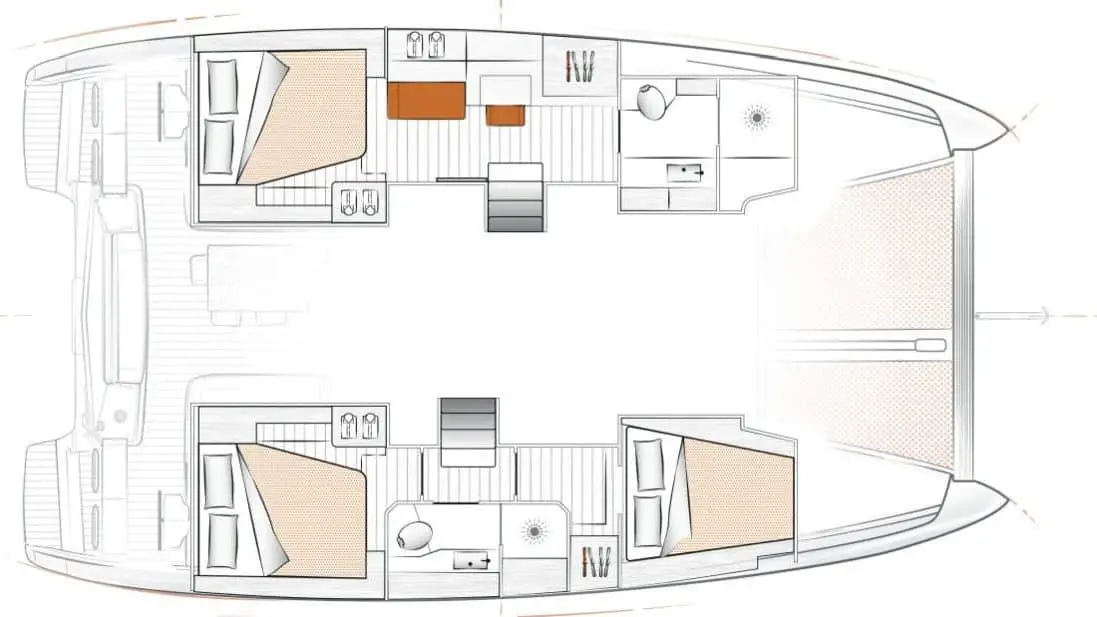
Build Convertible Main Living Spaces
The open cockpit is now a thing of the past. Instead, pioneering designers for catamaran manufacturers like Nautitech, Gunboat, and Catana now replace traditional-style salons, cockpits, and cabins with spacious indoor and outdoor living spaces. The concept involves merging separate saloon and cockpit areas with duplicate lounge spaces and the use of hard-wearing composite materials.
You can also design the cabin to suit your preferences. You may decide to add a cabin or remove one, add a bathroom, have the forward berth in the hull or on the wing deck.
- The design enhancements boost usable space while opening up the living areas.
- It reduces time and costs for interior maintenance and cleaning.
- Large windows bring in more light, increasing visibility.
- Luxurious, spacious, and airy owners’ cabins provide more comfortable living space.
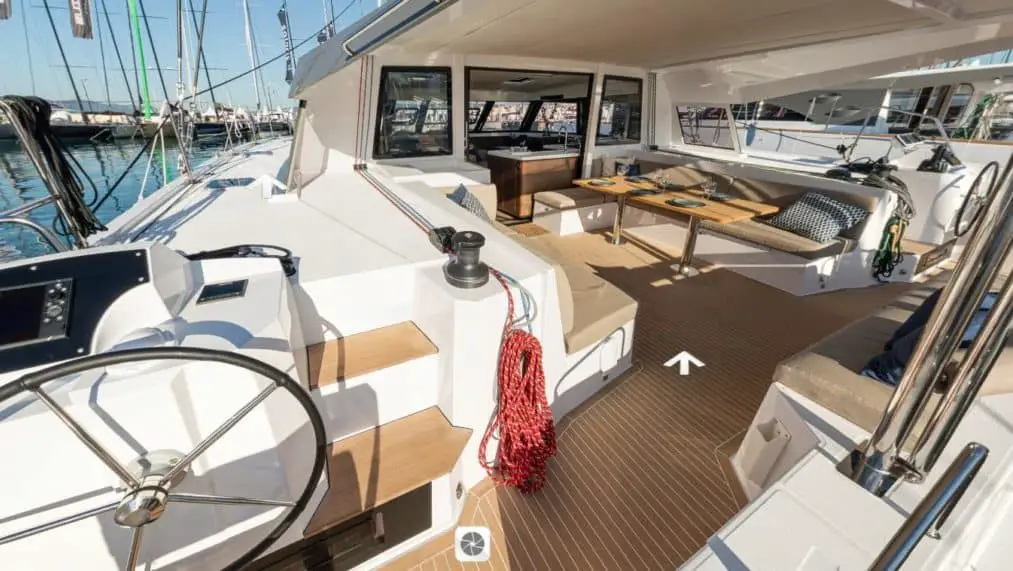
Bulkhead Helm Stations vs. Twin Stern Steering
Many catamaran owners have traditionally preferred bulkhead steering. This helm position remains popular, but twin stern steering positions come with more advantages since they provide greater sails visibility. The twin stern positions are also best suited for racing or day sailing since they often lack adequate protection for extended cruising.
Exposed helms are not ideal for a long ocean passage. Go for a safe, secure, and well-protected helm station that provides good visibility and comfortable space for long watches. Again, it’s best to have all control lines at the helm to establish a static control station. Also, have all push-button-controlled winches, instruments, windlass, and autopilot prominently located inside the cockpit.
- Twin stern steering positions give you a better view of the sails
- You get a better feel for overall sailing conditions.
- Twin stern steering positions lack the necessary protection for extended cruising.
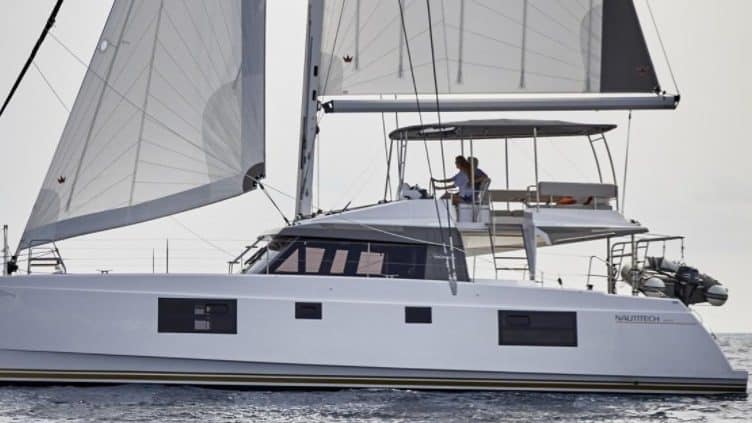
Go for the Flybridge Design
The flybridge design is appealing because it offers excellent visibility, more comfort, and additional entertainment and lounging space for everyone on board. Unfortunately for smaller boats – those below 50 feet (15.24m), there is minimal protection from the elements. As such, you might want to consider adding enclosures to offer protection. The flybridge, thus the helm, remains cut off from the vessel, which makes communicating with the crew a challenge.
- It provides great visibility.
- It offers comfortable spacing.
- It might be unsafe to move from the cockpit to the flybridge in bad weather.
- It isn’t easy to communicate with the crew.
Daggerboards vs. Fixed Keels
Average cruising catamarans typically utilize fixed keels while high-performance cats have daggerboards . Fixed keels allow you to beach your catamaran easily, and your hull remains intact if a collision occurs. While you lose some angle when sailing upwind, you gain more interior space in the hulls that you can put to good use.
Daggerboards are essential in a performance cruising catamaran since they guarantee that the boat delivers good upwind sailing, including during difficult situations. During long passages, they allow you to point better upwind though the drawback is that they consume much interior space within the cruising catamaran’s hulls.
Since flying on foils ( hydrofoils ) isn’t that practical on cruising catamarans, designers of larger-sized boats have also come up with modified daggerboards. These daggerboards produce lift and prevent leeway, too, thereby improving performance significantly, as seen with the Catana 59’s curved daggerboards. These foil-like daggerboards lift the boat ever so slightly upon reaching higher speeds, making it feel less heavy and much faster.
At the end of the day, calculating the performance of a boat sailing in a wide range of varying seas and winds might not be easy – despite a daggerboard or fixed keel configuration. This is because upwind speed depends not only on the sails’ quality but also windage and the height of the bridgedeck beyond the water.
- The design innovations -curved daggerboards and hydrofoils- improve catamaran performance significantly.
- Daggerboards enable you to access otherwise inaccessible anchorages.
- Daggerboards take up hull space in the hulls of your vessel.
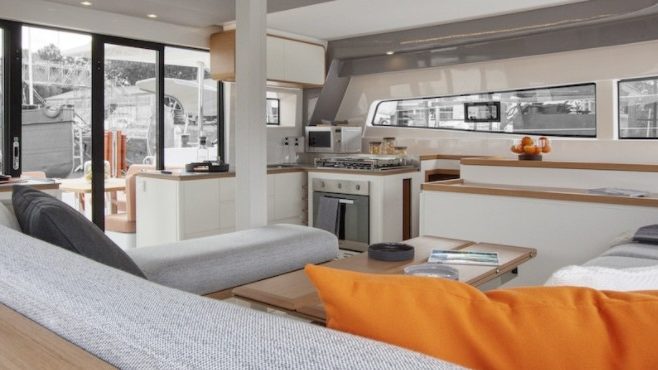
Galley Up vs. Galley Down
Galley layout are becoming more and more important as more people, including families, start sailing regularly. While at sea, your galley needs to be a safe place, well-ventilated, and functional. Everything should be well-thought-out for the sailor’s comfort, including handholds to make it safer to move around the boat.
While the galley location can either be up the bridgedeck or down in the hull, galley up appears to be the most popular trend. This makes the galley the focal point of both the living space and entertainment areas.
If you have a family, this placement is ideal since you make your meals from the galley and get to spend most of your time here. Many cruising families and couples prefer this arrangement and find separating the galley down the hull unappealing. Besides, carrying hot food up and down the staircase is unsafe.
Still, galley down is ideal for charter boats since it offers a private cooking area and uses up hull space efficiently.
- Having the galley on the bridgedeck is ideal for families and cruising couples.
- Placing the galley on a similar level with the serving area and cockpit is safer and less tiring.
- There’s better ventilation on the bridgedeck, making for comfortable cooking.
- There’s less kitchen privacy galley up.
- On smaller catamarans, this layout can impact the size of the saloon seating area significantly.
Production Catamaran vs. Custom
The choice of either a production catamaran or a custom design might seem pretty straightforward. Production catamarans from major brands come backed by proven designs, dependable construction, solid warranties, and many years of experience. The catamarans are easy to service, source for parts, and most – particularly the owner’s versions – hold on to their value, making them much easier to resell.
On their part, custom boats are fantastic in that you can tailor them to your exact needs. However, they might be more challenging to maintain or service. That’s because of parts unavailability and lack of construction knowledge.
Choose Quality Construction Materials
The best quality materials to use on your catamaran are both light and robust. While carbon fiber is great, plywood, plywood/epoxy, and strip-cedar are excellent materials too. What’s more, they are also affordable, so you don’t have to get too hung up on cutting-edge building materials. What matters is build quality; thus, a well-built plywood catamaran boat can last as long as a boat made from more high-tech materials.
Combining various materials also helps combat some of the issues that plague plywood boats in terms of resale value. At times, the design tends to make the boats appear pretty dated.
- Plywood and strip-cedar materials are affordable and provide excellent build quality.
- Plywood boats may have a lower resale value than those built with modern materials.
Consider Ease of Handling
An important factor in handling a cruising catamaran is deck layout. Most cruising catamarans sailed short-handed , so if your boat has one helm, all lines should run back here to allow for a static control station for the entire boat.
The other essential element is visibility from the helm. The 360 degrees of visibility while maneuvering, docking, or underway is crucial to your boat’s safety, as well as life and property. As such, you should be able to view both bows, or at least the pulpits and sterns, while standing at the helm. If not, you may have challenges handling the boat due to blind spots.
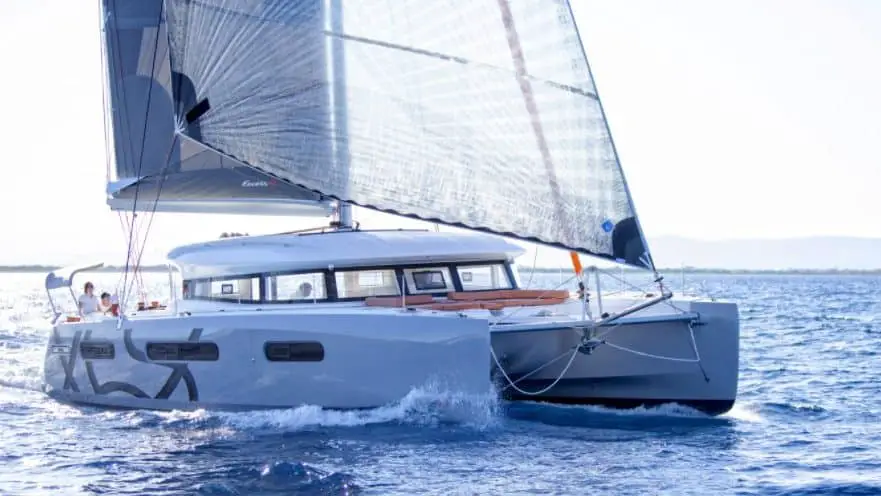
Consider the Load Carrying Capacity
A well-designed catamaran is enjoyable to sail in all weather conditions. It’s also much easier to handle than a monohull because of its widely spaced twin engines. But when you immerse extra hull depth, the vessel gets sluggish and moves slower, maneuvering in tight spots or when docking becomes more challenging. Furthermore, the hull submersion reduces bridge deck clearance, leading to hull slamming.
To allow for adequate load carrying capacity, you need a design that provides a generous displacement. This helps to ensure that you maintain reasonable bridge deck clearance even when fully loaded. It also allows you to avoid digging big holes in the water as you drag your transoms.
Displacement refers to the amount of buoyancy designed into the hulls, which essentially means that your boat will cruise better if its weight is less than your designed displacement.
Note that an overloaded catamaran not only loses out on performance but eventually, on safety too. To counter this, choose a lightweight catamaran with hulls bearing cored construction and interiors made of lightweight materials.
Remember, when you go cruising, you will need to carry fuel, extra water, supplies, equipment, and amenities, translating into thousands of extra pounds. Therefore, try and avoid the following design errors to ensure that your catamaran has an adequate load-carrying capacity:
- Avoid putting in place too much accommodation space.
- Avoid building a heavy boat ‐ use low-tech construction materials.
- Avoid installing inboards in a small boat.
- Lightly constructed catamarans perform faster and carry more weight.
- Cored construction makes for a strong and stiff catamaran, thus enabling good performance.
Final Thoughts
A well-designed cruising catamaran is a joy to behold. Today’s modern technological advancements mean that you can buy or build a light but strong cruising catamaran. And as you can see from this article, there are many excellent cruising catamaran layouts that you can choose from.
However, whichever layout you decide on needs to fit your sailing needs and purposes to ensure you remain comfortable and safe while at sea. Above all, ensure that you go for a vessel that you can handle with ease in all weather conditions.
Owner of CatamaranFreedom.com. A minimalist that has lived in a caravan in Sweden, 35ft Monohull in the Bahamas, and right now in his self-built Van. He just started the next adventure, to circumnavigate the world on a Catamaran!
Leave a Reply Cancel reply
Your email address will not be published. Required fields are marked *
Save my name and email in this browser for the next time I comment.
Recent Posts
Must-Have Boat Gear for Catamaran Sailors!
Sailing is probably the most gear-intensive activity I've ever done; there are so many decisions to be made about what gear to buy now, for tomorrow, and what to definitely never buy. The gear on...
6 Best Trailerable Trimarans For Bluewater and Coastal Sailing
Having a boat costs a lot of money, even when you are not using it, marina fees, etc. And once it is in the water most sailors never go very far from their "home marina" and sailing will be somewhat...

- About Aeroyacht
- Aeroyacht Design
- Aeroyacht TV
- Mission Statement
- Aeroyacht Racing
- Favorite Links
- Customer Testimonials
- Office Location
- BUY A MULTIHULL
- Specifications
- Photo Gallery
- Try Before You Buy
- Yacht Ownership and Demo Sails
- BUY A POWER CATAMARAN
- Yacht Business Ownership FAQ
- MULTIHULLS FOR SALE
- Aeroyacht Superyacht Catamarans
- Global Multihull Search
- Buy A Multihull
- Sell a Multihull
- Multihull News
- Publications & Articles
- Commissioning & Delivery Services
Multihull Keels and Daggerboards

Fountaine Pajot BELIZE 43 resting on her keels, showing good bridge deck height
Uncovering the compromises of both underwater appendages and analyzing their disadvantages and merits.
Man has learned much from nature, and sailboats and their underwater appendages are one of the areas that we have applied what works and what doesn’t. As we all know, boats – as most things in life- are compromises and often we are prepared to make concessions in one area in order to gain an advantage in another. Not only should this brief discussion illustrate the basic virtues and drawbacks of daggerboards and mini keels on multihulls, but also point out their active and passive safety aspects.
Most multihulls in todays marketplace come in two varieties. By far the vast majority of the production cruising catamarans (about 90%) are keelboats and have low aspect ratio, unballasted keels. These well known French, Australian or S.African boat manufacturers market their boats for private ownership and the charter industry and make a great product. Without sounding too general, these boats have very spacious interiors and are perfectly adaptable for live aboard families or the charter trade. This multi million dollar charter industry, has an obvious influence on the requirements and design of their charter fleet, which further has a trickle down effect to other builders who also market their cats for private ownership. Design parameters for these charter cats are often centered around 2 week multiple family vacations in the steady Trade Winds and day sails between closely spaced islands of the Caribbean. The features of these keel catamarans obviously put less demand on pure sailing performance or extreme upwind sailing characteristics, but rather try to please by offering solid construction, live aboard comfort and simple and reliable handling characteristics.
The other type of multihull is the catamaran with articulating daggerboards or centerboards. Centerboard and daggerboard multihulls both share the same basic concept, except their deployment and storage relies on different principles. The daggerboard lives in a scabbard, or daggerboard trunk. It moves up and down, vs. a pivoting centerboard, which is raised and lowered around a massive pin. High aspect ratio daggerboards are by far the most efficient foils. They have none of the problems associated with centerboards, which when fully lowered are only braced by a small area on top. When going upwind in a hurry, loads on the trunk act as a giant lever, which constantly work to spread the trunk apart. This is the reason why it is recommended to operate foils as pairs in heavier conditions to divide the loads. Also the large area of the remaining centerboard slot creates a lot of unwanted turbulence making them unpopular for performance minded sailors. Lastly declining popularity of the centerboarders can also be lead back to the often large intrusion on the interior space the trunks create. Although the Gemini catamaran is a good example of a very popular and well thought out production catamaran, there are few other mass produced centerboarders around. It should be noted that one great advantage centerboards have vs. any other underbody configuration is that they theoretically retract when colliding with an object. In spite of this, most offshore or performance orientated sailors clearly favor daggerboards or low aspect ration keels.

Illustration A
Daggerboard catamarans have several advantages over their keel counterparts, some of which are well known and others that are more subtle and sometimes only recognized by people who have used them. Active safety aspects are advantages created by speed and the ability to retract underwater appendages.
I am a firm believer of “faster” rather than “slower” on ocean going performance multihulls. Many people might say, going fast is only for racers. But lets think about this. The ability to reduce exposure time through speed is invaluable for cruisers. If say on a transatlantic passage you can shave off 5 days you have already increased your safety factor, in some cases, by 25%. Not being a “sitting duck” is a nice thing indeed. By being able to have the choice, bad weather can be avoided, which can sometimes lead to a negative spiral of incidences. In general, especially on long passages, a daggerboard cat will have the edge on speed over her keel counterpart.
Lets face it, we are all in it for the fun of sailing as famed designer Francis L. Herrshoff said: “The fun of sailing is directly proportional to the speed of sailing”. Maybe this is the reason he designed Amaryllis, his revolutionary catamaran, which was later banned from racing. Generally speaking daggerboard catamarans will always be slightly faster than their keel equivalents. The speed advantage of most daggerboard catamarans vs. keel catamarans though is often exaggerated. On a typical day sail a well trimmed and tuned keel cat will only be slightly slower than a daggerboard cat.
Multihulls lack the feeling of being in the “groove”, which monohull sailors enjoy. Effortless high average speeds, acceleration and sustained high velocity surfs is something fast multihulls compensate with. It should be noted that anything (even a barn door) surfs in the right conditions. Even keel catamarans can surf at speeds up to 30 knots down large seas.
Upwind Advantages: Depending on sea state going upwind, daggerboard catamarans vs. their keel relatives will point up to 5 degrees higher and also experience 2-5 degrees less leeway, which isn’t much one would think. But in an uncomfortable 100 mile beat this ads up to being more than 17 miles closer to your destination! (Illustration B).

Illustration B
sin A=a/c (sin A) c =a (0.1736) * 100 = a a = 17.36 miles
Lets take a 45’ catamaran: the lift (to windward) generated by a daggerboard is almost twice that of a low aspect ratio keel and the drag with the board all the way down would be almost 20% less. The most recent generation cats with large beams and stately bridge deck houses benefit especially from high lift foils, since the windage of their projected area can ad up quickly. The same cats with keels usually suffer from excessive leeway and sideslip. Keel cat’s however, especially in a calm sea state, lessen this disadvantage as boat speed and flow over their keels increases.
Reaching and Running Deep: When running deep in fresh conditions the fixed could act as a brake, that one cannot disengage. Since they cannot be retracted, their volume and resistance slows the boat’s progress and in combination with the forward pressure of the sails forces the bows down. This is especially the case with catamarans that have long bridgedecks, heavy extremities and low volume- fine bows. The bigger the friction in the water, the bigger the pressure on the mast and the more the boat is burdened. Another neat trick is lifting the daggerboards, one can actually increase apparent wind by pointing up and induce leeway, crabbing faster to ones destination.
Tacking and Helm Feedback: Cruising catamarans are often mistaken to tack slowly and behave sluggishly to movements of the helm. This is certainly true for some heavy keel catamarans and much less so for ones equipped with boards. In complex seas, some of the heavier keel cat’s only option for a safe tack is back winding the jib. Monohulls with only one fin will always tack quicker than multihulls, just as foil equipped catamarans will be more responsive than keel multihulls. Modern hydraulic steering systems are easy to build and with most forward helm stations behind the main coachroof, pose sometimes the only alternative for the builder. Mechanical steering and daggerboards will give the ultimate feedback and fun at the helm…if one is driving at all, since usually the autopilot is engaged for longer legs.

Inclined foils on the Aeroyacht H42 performance catamaran built by Edel
Another advantage of daggerboards is the better maneuverability under one engine. If you loose one engine and retract the board on the hull which has no engine power, but leave the powered hull’s foil down, the boat will turn easier. Because of the retracted foil on the un-powered side there will be much less drag induced turning moment, the boat will be more balanced and the other sides deployed board will provide sufficient bite for “survival” steerage. Especially in high crosswind situations a catamaran with both boards down is much easier to maneuver than one with shallower keels. Usually harbor maneuvers under power are low speed operations, and this is where the high lift capacity of twin boards excel yet again and facilitate handling and precision steerage. Daggerboard cats also can motor a bit faster, since by retracting the foils they have less resistance.

Keel and daggerboard cats usually have less draft than keel monohulls, opening access to shallow anchorages. An advantage daggerboards have, are their gauging characteristics when entering shallow harbors or unknown territory. By lowering them, one actually creates a “safety depth”. When they touch bottom one still has the possibility of raising them, performing a U-turn and getting into deeper water. With fixed- non retractable keels, especially with a monohull, groundings or unplanned bottom encounters could end tragic. At least a monhull can attempt in heeling the boat to reduce draft and re float. This obviously is not an option on a keel cat. If you get stuck in the mud you are dedicated to await the next high tide to get you off. Crashing into a coral reef could be a different story altogether and only a haul out can asses and repair damage. Depending on their design, boards could be rotated or flipped, and even repaired underway. In general daggerboard cats also have less draft than keel multihulls allowing access to even more harbors and anchorages. They can be beached high up for repairs or inspections, increasing the window of exposure time between tides. I know, I once performed a 5 hour long emergency repair on our 43’ catamaran this way, saving 1000’s in yard bills and days of headaches.
It should be notes that keel catamarans however, can be beached just as easy as daggerboard cats. They can be left sitting, high and dry, completely safe on their keels, without having to worry about damaging the hulls or getting debris or sea life stuck into the vulnerable daggerboard trunks.
Bruno Nicoletti is an old friend and one of the most low key-expert sailors I know. He has logged more than 130,000 miles (geriatric miles as he calls them) on his 44’ daggerboard catamaran.. At a recent meeting with him in France we talked about his experiences of his record, double handed – one stop- Southern Ocean circumnavigation at age 63. The French Press compares Bruno to sailing legend Vito Dumas and has published his accounts in an article called: “The Impossible Route”. He explained, that in the Southern Ocean, in the most convoluted conditions he would simply raise both boards, lock the helm to windward and lay a-hull with no sails. “Brumas Patagonia” would safely slide down the steep faces of waves and minimally drift to leeward at about 1 mile per hour while he was either resting or reading. The water spoil of his side wards drift would help keep the edge off cresting waves and often prevent them from breaking (Illustration D) While it was blowing 70 knots and higher he felt very safe and in fact the world around him turned peaceful and quiet. His confidence in this system is impressive: I am currently helping him with sea trials on his new 47 footer for a yet another go at a High Latitude – geriatric- circumnavigation. This time he is planning to take his 78 year old brother and do it non stop !

Illustration D
It is not only in the Southern Ocean that one encounters steep, breaking waves. Major capes or the Gulf Stream are notorious for rough conditions where the ability to navigate safely becomes imperative. In these environments any proven and strongly built daggerboard cat would have a slight advantage by lifting her boards, although a well designed keel catamaran could get through unscathed. In extreme weather, and I am talking beyond Force 10, it is very important to enable a catamaran to side-slip rather than encouraging the possibility to trip, and maybe flip. A catamarans behavior in towering side waves is decisive and the possibility to lift underwater appendages is essential, especially if one has lost the ability to steer. The disadvantage of a keel catamaran in huge beam seas is more psychological than real, as these types of vessels typically also slip sideways. In survival conditions or emergencies, the use of parachute anchors, which force the boat into a certain attitude is often thought to be the only answer for most boats. In my mind this tactic is questionable since it puts enormous strains on the boat, is accident prone and renders one helpless when the odd rogue wave from a different direction smacks into the boat. It is better to manage survival conditions, by controlling and slowing the vessel with the use of drogues.
We have learned a great deal from aerospace industry and the trickle down effect to monohull keels. Multihull designers and builders greatly profit from the advanced research, that has been done in the field of NACA sections (National Advisory Committee for Aeronautics) and foil performance. Keels and daggerboards come in a variety of aspect ratios but most are based on low speed foils, which drag/lift characteristics have been optimized. To increase lift even further, some performance catamarans even utilize asymmetrical shaped daggerboards, shaped flat on the outside (leeward) and cambered on the (windward) inside. As they can only be used one at a time asymmetrical boards are somewhat limited in their adaptation for cruisers. (Illustration E)

Illustration E
Since multihulls do not heel, their underwater appendages are more effective in retaining positive flow than their monohull relatives.(this is also the reason why autopilots burn out less often and can be used in heavier conditions on catamarans) As the monohull heels, not only is the upper part partly blanketed by the underbody of the vessel but also flow is lost as the water slips past the angled keel to leeward. (Illustration F) This was especially prevalent on the early IOR monos, which had extremely beamy and shallow bilges and high prismatic coefficient center sections. To compensate for this loss of heel induced flow, monhulls need deep draft keels to make good progress to windward. The keel or daggerboard catamaran on the other hand can more efficiently create lift for the same keel plan view area, not only because it has two vs. one keel, but also through its minimal heel is able to keep its underwater appendages perpendicular in the water.

Illustration F
Usually catamaran daggerboards have a higher aspect ratio and are deeper than the equivalent length monohull, since they have the ability to retract them and therefore have no draft considerations. It is therefore not surprising to see that in wind speeds starting at around 10 knots a well designed and sailed daggerboard cat, will often outpoint and outpace a performance monohull. Even well sailed keel catamarans can often arrive earlier at an upwind destination compared to heavy monohulls. The couple of degrees they sacrifice in their ability to point to windward is often made up by their higher speed and VMG (Velocity Made Good). This performance difference increases proportionally to the wind speed and is very noticeable in F.4 conditions and beyond.
A well known fact and possibly the single biggest psychological deterrent of daggerboard cats is the vulnerability of the boards and trunk in collisions. The true Achilles heel are actually ill constructed and designed trunks, which cause flooding in an impact. This obviously is not the case with keels, which would deflect a minor obstacle, or in case of hitting a container or whale, simply break off. In the case of sacrificial keels, they would sheer leaving the hull completely intact.
Obviously the most critical area in daggerboard design is the construction of the daggerboard trunk. It is usually heavily reinforced with massive gussets, especially at its aft bottom end and extends from the bilge to the overhead. Typical forces on the trunk easily exceed the pressure of the wind on the sails. Dynamic forces of wave action and the shock loads of slamming into seas or solid objects must make this area one of the strongest and best engineered of the entire vessel. Usually the foils are located just aft of the main- mast bearing crossbeam and are somehow tied into this unit to profit from its stiffness. The more “left over” daggerboard remains in the scabbard in the fully down position, the better it is braced, so it is not surprising to see foils that are 18’ long for a 60’ boat. Builders who take their job seriously go through great lengths to make this key area as strong as possible. In a recent conversation with the manager of a reputable French production yard it was pointed out that the daggerboard trunk is engineered and constructed 7 times stronger than the composite board. In case of a violent impact, the foil, which has weak spots designed into it, will snap and leave the daggerboard trunk unscathed. It is a type of sacrificial impact philosophy or a safety fuse, just as it is used on sacrificial fixed keels. The careful engineering and experience necessary in building reliable daggerboard or keel cats stresses the importance of a production yard, which has consistently built them. This aspect should not be taken lightly if one ventures out into the open sea, even if it is only 20 miles offshore.

Often builders of keel cats ad daggerboards to their designs, with the objective to market increased performance and safety. This usually ends up in a compromise, since the hydrodynamic hull requirements of both types could differ substantially, let alone the experience of proper integration, engineering and construction might be lacking altogether. Building with keels does not require the experience, careful construction and engineering which are necessary with retractable foils.
Keels offer advantages, as they do not need to be operated at all. They do their work silently and its usually one less thing to go wrong. On the other hand people who have never sailed with daggerboards think their operation is complicated. In fact they are as easy to use as outhauls or travelers. In normal conditions with 2 people – one pumping the daggerbaords up haul line directly at the board- the other taking up the slack of the up haul, it literally takes 3 seconds to raise a 15’ daggerboard. Single-handed it is a 10 second affair involving 2-3 wraps of the up haul around a winch and 10 cranks. Most boards are slightly heavier than the water they displace and often only weigh 80 lbs. Dropping takes half a second, by simply opening the up haul sheet stopper and easing the foil down. Loads on the boards increase as the speed and pressure builds, so if one has the choice, these maneuvers are usually performed just before tacking. It is a misconception that the operation of foils will depend on the wind speed. It is rather the boat speed, in regards to sea state – which in turn limits progress – which dictates the proper positioning of the daggerboards.
Nothing is perfect and this analysis would be worthless without mentioning the pro’s and con’s of either underwater appendage. Daggerboards, their surrounding structures and systems are more expensive to build, so builders prefer to stay away from them given the choice. In some catamarans, especially smaller ones or ones that have the trunk in the center of the hull, the interior passage in the hulls can be crammed. Lastly it should be mentioned that incorrectly designed and constructed, daggerboards multihulls can be more of a detriment than virtue and in some cases can be extremely dangerous. If the trunks are not massively reinforced and in case of a violent collision one could flood one hull and cause a capsize. In this case one is better off with a well designed and constructed keel multihull than a mediocre or untested one with daggerboards.
Yet daggerboards give you choices, that keels deny you. It is like the new generation of cars with Tiptronic gearboxes, which offer you an automatic transmission with manual override. By physically selecting the proper gear, torque can be adjusted to suit the conditions. It’s the same with the daggerboard equipped catamaran. The boat can be fine tuned to optimize the level of efficiency of the vessels motion through the water. By being able adjust the foils, superior sailing characteristics result in speed and generally more fun on the water. Active safety aspects of reduced exposure time, better maneuverability and shallow draft provide significant benefits.
For safety reasons, most catamarans builders opt for fixed keels and completely separate the keels from the hulls, a feature which preserves and protects the water tightness of the boat in the event of violent impact. Furthermore, if such a situation arises, it makes them easier to repair or replace. Fixed keels require no manipulation, such as daggerboards and give perfect protection to drive shafts, propellers, rudder blades and hull bottoms in the event of grounding. Lastly the absence of a centreboard case means saving of space in the interior of the vessel and usually results in a larger living space.
Back to the birds. We all know the giant Albatross as an extreme example of a sorer that can glide for days in varying conditions, without having to move its wings. This Southern Ocean beast, who calls his home the most inhospitable area on our planet, is better adapted to handle extreme circumstances than any other flying animal. The Albatrosses’ wings are sophisticated in shape, but basically are articulating high aspect ratio foils very similar to daggerboards. Similar to the Falcons “high speed” wings, the Abatross can modify its wings aspect ratio to adjust to the breeze. The designers of the Polynesian multihulls, legendary Viking long ships and American Cargo Schooners understood this too. By adding movable leeway devices, center- or daggerboards, they made their boats more seaworthy and even sailors in the past preferred them over fixed keels.
Today we continue to strive to find the perfect compromise in our vessels to satisfy our most important requirements. We should be extremely thankful to the 1000’s of keel multihulls that have revolutionized the charter industry and many good boats have evolved from this trend. Reputable dagger board catamarans and well designed keel multihulls will continue to be the choice of future generations of serious offshore voyagers. Both offer their advantages and disadvantages and it is important to understand both in order to make the proper choice.
Gregor Tarjan, a trained naval architect and longtime multihull enthusiast is writer of numerous articles for Multihulls Magazine and various other trade publications. He has been involved in Dennis Conner’s “Stars and Sripes” 1984 Americas Cup Campaign, is the founder of Aeroyacht.He is also the co-editor and contributing author of the “Sailors Multihull Guide”, the book by Kevin Jeffrey.
Social Share
Catamaran news.

Planet Sail tests a McConaghy Multihull

Charles Caudrelier wins Arkea Ultim Challenge

Nautitech 48 – Control of the Wind

Boat Test: Nautitech 48 Open catamaran

NEEL 52 Trimaran VIDEO – Sailing at 17 knots
- Catamaran Steering Positions
- Catamarans vs. Monohulls
- Catamaran Learning Center
- Catamaran Speed
- Catamaran Efficiency
- Catamaran Stability
- Catamaran Safety
- Catamaran Shallow Draft
- Catamaran No Heel Sailing
- Catamarans and Seasickness
- Catamaran Space
- Catamaran Boat Handling
- Catamaran Advantages over Monohulls
- Wave-Piercing Bows
- Catamaran Sailing Schools
- Catamaran Insurance
- Catamaran Charter Business and Tax Savings
- Ask the Owner
- 5 Valuable Tips
- Survey Checklist
- Sea Trial Checklist
- MULTIHULLS & CATAMARANS App for Iphone
- Catamaran Surveys
- Multihull Services
- Catamaran Build Consultation
- Financing Services
- Catamaran Repair & Service Facilities
- Catamaran Demo Rides & Shows
- Catamarans for China
- Yacht Design
- Interior Styling & Yacht Art
- Photography
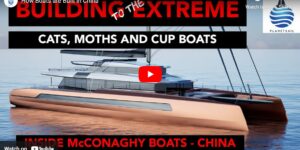
McConaghy MC63 Power Tourer – showing her pace
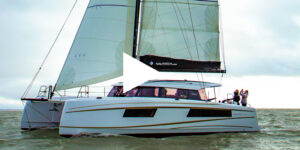
Nautitech 48 Open catamaran – Video

Nautitech 48 catamaran – Interior Design

How the Nautitech 48 catamaran was conceived – Designer Comments.
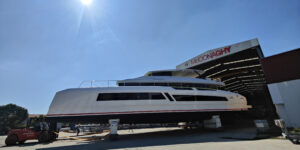
Launched ! – McConaghy MC82P Power
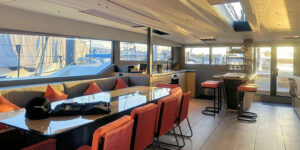
McConaghy 75 catamaran – Stunning NY Loft-Style Interior
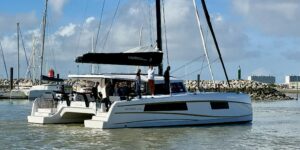
VIDEO: Nautitech 48 catamaran walkthrough. Part 1. EXTERIOR

VIDEO: Nautitech 48 catamaran walkthrough. Part 2. INTERIOR
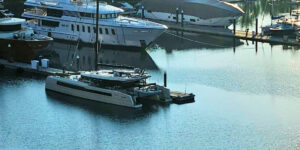
McConaghy 75 Launched.
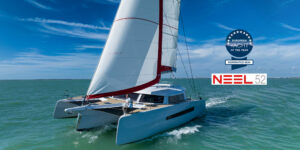
NEEL 52 trimaran nominated European Yacht of the Year 2023
Helpful tips from aeroyacht.
AEROYACHT PUBLICATIONS
Catamaran books by gregor tarjan.

JOIN AEROYACHT’S NEWSLETTER
Catamaran Design Guide
Spectacular sunsets in the Pacific turn the horizon into a brilliant spectrum of gold and orange colors.
Copyright © 2006, 2008 by Gregor Tarjan. Click here for terms of use.
performance, yet desire high daily averages and passage times, which should be as short as possible. When choosing a large multihull, sailors look, above all else, for safety and comfort, long before the consideration for flat-out speed comes into the discussion. Nevertheless, performance is a highly important design consideration. No catamaran sailor wants to sail slower than a same length ballasted keelboat. Below are some EVALUATION & COEFFICIENTS useful coefficients, which will help compare monohulls and multihulls objectively.
Bruce Number (BN)
below "Indigo," a magnificent Wormwood 70, sailing in sparkling Caribbean waters.

Various multihull characteristics and design features can be expressed in mathematical formulas. Their results are crucial and will give prospective owners a basis of comparison between different types of catamarans. These numbers are important, as they eliminate ambiguity and clearly display various advantages or concessions of a design, which would be hard to quantify any other way. Mathematical coefficients not only will provide insight into a boat's performance in varying conditions, they also reflect concerns about loads to be carried safely, speed and stability.
We have already mentioned the Displacement/Length and Sail Area/ Displacement ratio in our chapter on Multihull Advantages, illustrating the point of a multihull's efficiency. Let's look at some other coefficients that give us an indication of a boat's performance.
What is performance and how do we really measure it? Most people who buy a cruising catamaran are not really interested in racing
The Bruce Number is very similar to the Sail Area to Displacement ratio although the formula is slightly different. It is the square root of the sail area in feet, divided by the cube root of the boat's displacement in pounds:
SA = upwind sail area (mainsail and 100% jib)
Displ = weight of the boat in pounds
Similar to the Sail Area to Displacement ratio, the higher the coefficient the faster the boat and better is its performance in light air. Typically a BN of 1.1 will be the threshold between fast and more sluggish multihulls. A heavy displacement monohull might have a BN of .7, whereas a modern cruising catamaran shows a BN of 1.3. Offshore multihull racers can have BNs of 2.0 and higher. The BN will also tell us about a catamaran's ability to withstand stronger winds before reefing. A boat with a higher BN is usually overcanvassed in strong conditions and will have to be reefed earlier than one with a lower coefficient.
On the other hand, they will be able to produce more "power" than their counterparts in lighter winds and perform better.
Sail Area to Wetted Surface (SAWS)
SA/WS = Sail Area Wetted Surface Coefficient
SA = upwind sail area
WS = total underwater surface area (hull and appendages)
This formula simply divides the upwind sail area of the boat (mainsail and 100% jib) by the wetted surface. This coefficient will give us a statistical indication of the multihull's lightair performance since in low wind conditions skin friction becomes an important factor. Monohulls can have coefficients of at least 7% more than multihulls.
Hull Fineness Ratio (HFR)
The Hull Fineness Ratio, known as the hull's beam-to-length ratio, is an interesting number. It is derived by simply dividing the waterline length of the hull by the waterline beam of the hull.
Max. WL/Max. Beam WL = Hull Fineness Ratio Max. WL = length of the hull at waterline in ft. Max. Beam WL = beam of the hull at the waterline in feet.
Monohulls, when compared to multihulls, have low hull/fineness ratios. In Part 1 of this

book, discussing "Efficiency," we saw that ballasted keelboats are limited to Archimedes' principle of hull speed (1.34 x VWL). Multihulls do not have these theoretical barriers, because their hulls are narrower.
The thinner the hull the faster it will be able to travel through the water. But, attention! It will also carry less unless you are on a mega cat. Typically, a 40' cruising catamaran's HFR will range from 8:1 to 10:1. Dennis Conner's above While sailing under spinnaker and experiencing virtually no roll at all, guests will always find a comfortable spot to relax on the foredeck, an impossibility on a monohull.
There are various methods of calculating the transverse stability of a catamaran. One of the simplest and most utilized techniques is establishing a relationship between the height of the Center of Effort (CE), displacement, beam and sail area. Multihull designer, James Wharram added safety factors of 20% to compensate for gusts and the dynamic environment of the ocean. Another method is described in the text below.
Multihull Stability & Capsizing Moment d - Displacement (kg) x half beam (m) max ~ Sail Area (sq m) x Height of Center of Effort (m)
P max = maximum pressure exerted onto sails
Multihull Stability & Capsizing Moment

height of sailplan CE
half overall beam (half hull beam)
racing cat "Stars and Stripes" had a 16:1 HFR. Of course, the larger the boat, the narrower the hulls will become in comparison to its length. For example, the HFR of a 100' luxury catamaran may be 12:1, providing it with a high speed potential. However, monohulls can show HFRs of 3:1, though the comparison is complicated as their angle of heel affects the measurement.
One has to be very careful when analyzing the Hull Fineness Ratio of a cruising catamaran, because other factors such as the actual shape of the hull cross sections (Prismatic Coefficient, PC) can throw the analysis off balance. Go-fast sailors like to think that fine hulls are always fast. That is not necessarily true because a slim hull could have a large underwater volume, thus slowing it down. Consequently, a wide waterline-beam hull could have less drag than a narrower one. It could have a shallow underbody (low PC), which would be beneficial to load carrying (Pounds Per Inch Immersion Number, PPI) and early surfing characteristics at speed.
Stability Coefficient (SC)
This mathematical formula has been devised by the distinguished catamaran designer and sailor James Wharram and his team. This coefficient analyzes a multihull's ability (in a static environment) to resist capsizing due to wind.
( 0.682 VW x (.5 Boa) ) x .555 = CW .00178 x SA x h
W = Wind speed, apparent, in mph CW = Critical Wind Speed to capsize in mph SA = upwind sail area in sq ft. h = height of Center of Effort (CE) of total sail area
Boa = Beam overall
This formula will tell us how much wind it will take to overturn our multihull. By instinct we will know that a catamaran with a wide stance and a conservative sail plan will be very stable offshore. The SC formula will inevitably illustrate that a wider beamed catamaran with a tall sail plan will be as resistant to wind induced capsize as a short-rigged, narrower boat. This is not so if one considers the chaotic environment of waves and the real world of heavy weather sailing. It is interesting to note that a wide beamed boat (regardless of the SC) is more resistant to capsize in seas due to the effects of a higher moment of inertia. In an open-ocean environment, which is everything but static, the SC formula has little meaning. Nevertheless, it serves as a good basis to evaluate stability as a factor of wind force.
below When the wind suddenly comes up, all that is needed is a couple of turns on the jib furler to quickly reduce the headsail size. The catamaran will hardly sail any slower, but feel more comfortable.

Wide hulls and a large overall beam will increase the overall righting moment of a catamaran. A word of caution: Excessive beam will reduce the fore and aft stability. Designers strive to compromise hull fineness ratios, place heavy weights towards the CG (Center of Gravity), and engineer hull and overall beam to achieve a seaworthy balance, which is safe, yet provides ample liveaboard accommodations.
Catamaran Stability Considerations

Diagonal Stability & Beam-to-Length Ratio (BLR)
Stability of a multihull, or the resistance to capsize, should be seen as three components. Athwartship Stability is one well-publicized type and the one often talked about. The other much more important types are Fore and Aft and Diagonal Stability. Fore and aft stability is established by the relationship between the boat's waterline length and the distance between the hull centerlines. It will reflect the catamaran's resistance to tripping. This relationship should be in the vicinity of 39% to 42%. For a seaworthy cruising multihull it is important maintain the proper ratio between length and beam, which, in turn, balances equal amounts of athwartship with diagonal stability. The goal should be to prevent the possibility of a sudden discrepancy of powers between fore and aft and sideways resistance. Most of today's multihulls keep these two component forces in equilibrium, making them extremely seakindly and safe.
Some early design multihulls were very narrow, partly due to the material limitations of that time. But things have changed. Contemporary composite construction allows designers to build wider boats without compromising stiffness. Production catamarans of today have a wide stance and have the benefit of greater safety margins in gusty wind conditions than their older cousins. Multihulls are sophisticated structures and true modern miracles. They provide a more comfortable ride and more interior room. Thanks to modern materials they weigh less and perform better than catamarans built only 10 years ago.
Some catamarans, especially production boats, which are very popular in the charter fleets, are growing wider by the year. The businesses who rent these beamy monsters adore them. Lots of room plus open decks are ideal for clients and the bigger (wider) the boat, the more paying guests can share the fees. But there certainly is a limit as to how wide is too wide. Extreme beam can be dangerous. It can lead to instability fore and aft and to excessive bridgedeck slamming, as the relative distance from the bridge deck to the water will decrease with an increase in width. A vessel with excessive beam might seem stable athwartships, but it will compromise overall stability.
We know that multihulls can, in extreme cases of seamanship error in wild storms, be thrown over from any side - front, back and beam-on. The best examples of this phenomenon are racing multihulls, especially Formula 1 trimarans, which have fine hulls for speed and huge sailplans to provide driving power. They are initially extremely stable athwartships (High Beam-to-Length Ratio), but have a tendency to become unstable fore and aft. They will surf down waves and reach a point where the power of the sails, and speed, will exceed the ability to keep the bows out of the water and the boat will pitchpole. This is the reason why catamaran designers usually draw their multihulls with a Beam-to-Length relationship of between 50% and 55%. The longer the vessel the lower that percentage becomes.
I am currently involved in the "Gemini" project, which presents an example. It very well might become the world's largest sailing catamaran. She will have an overall length of 145 feet, yet her beam will "only" be 54.4'.

Please, don't worry. "Gemini" will not be tender and tip over in the slightest breeze. On the contrary, this monster will be one of the most stable craft afloat, although the beam-to-length relationship is only 37%. The relatively low beam-to-length ratio also involves the fact that the boat would be too heavy and building costs would be prohibitive if she were to have a standard 52% BL relationship. Most importantly, could you imagine turning a 75-foot-wide boat?
above Asymmetric spinnakers on furlers are great inventions. They add instant sail area, yet can be doused in a matter of seconds when the wind picks up strength.

above Although this Edel 35 was a good-looking and popular catamaran, it suffered from excessive bridgedeck pounding, which was caused by only several inches of clearance between the saloon's underwing and the sea.
Obviously there is a sweet spot in the beam vs. stability question. Designing too beamy a boat will also necessitate more freeboard to preserve bridgedeck clearance which, in turn, will increase windage and complicate maneuvering. Unless sophisticated aramid construction methods are utilized, more beam will also add more weight and stress to the structure. Adding more mass will, to a certain point, help make the boat more stable, but where do we stop? Is it better to add weight or width to make a boat stiffer? Of course, both characteristics are interrelated as a beamier boat normally is also heavier. Just adding weight to a catamaran simply to make her more stable will not pay off. Consequently, making a boat too wide might increase living space yet it will also burden the structure, require a beefier manufacture, and yield an even heavier boat. Needless to say, a boat which is too wide will also create practical restrictions such as maneuvering, the ability to haul the vessel and much higher building costs.
Beam has a great effect on bridgedeck clearance, which is one of the most vital characteristics of a good cruising catamaran. As standard practice, the well-known rule of 1" of bridgedeck clearance for each foot of beam was a safe way to prevent excessive wave slap. The wider the beam the more the relationship changes and the necessary height of 1" per foot of beam needs to be increased to 1.3" or more. In the extreme case of overly square boats, that number will have to be closer to 1.8" per foot of beam. This will have a negative effect on any seaworthy multihull that has a bridgedeck saloon. The wide beam will necessitate a high cabin sole to remain a safe distance from the waterline. In order to provide standing headroom, the coachroof might be higher than practical, which could result in a boxy, high-windage multihull. Not only will this be unattractive, but also raise the Center of Gravity (CG) which really should be kept as low as possible.
More overall beam on the other hand (given that there is still sufficient bridgedeck height) has a less known benefit, as it reduces the possibility of hull-wave interference, which is particularly important for fast designs. The wave interaction between the hulls can lead to additional resistance, and especially in an agitated sea state, the formation of wave crests can pound the bridge deck. Most early narrow-beamed catamarans suffered from this phenomenon,
Ultimately, a boat's design has a major influence on its ability to stand against the forces of nature, and to keep occupants safe. Manufacturing excessively wide catamarans is like trying to market monohulls with super deep-draft keels. Both are totally impractical. We designers have to make sensible compromises and learn from past experiences of what has worked at sea by balancing the benefits of a wide boat with its disadvantages.
below This narrow-hulled Outremer 64 Light has completed her third circumnavigation with the same owners. Note the smooth underwing clearance, lacking any protrusions or steps.

"A great cape, for us, can't be expressed in latitude and longitude alone. A great cape has a soul, with very soft, very violent shadows and colors. A soul as smooth as a child's, and as hard as a criminal's. And that is why we go!"
~ Bernard Moitessier

Dinghies, windsurfers and every imaginable type of water toy can be stored conveniently on large catamarans and easily launched from the wide transom steps for shore-side pleasures. Note the twin life rafts located in special compartments on the massive aft crossbeam.
Continue reading here: Hull
Was this article helpful?
Related Posts
- Design Dynamics - Catamarans Guide
- Hull Construction - Ship Design
- Geometry - Ship Design
- Heavy Weather Tactics - Catamarans Guide
- Configuration Types - Catamarans Guide
Readers' Questions
What length should a stub keel be to waterline length on a catamaran?
There is no set rule for the length of a stub keel on a catamaran in relation to its waterline length. The length of the stub keel will depend on various factors, such as the size and design of the catamaran, intended use, and specific requirements of the boat builder. Generally, the stub keel on a catamaran is designed to provide stability and improve sailing performance, so it is important to consult with a naval architect or boat designer to determine the appropriate length for a specific catamaran.
What is a 16 passenger catarmarn like?
A 16-passenger catamaran is a type of boat or vessel specifically designed to carry 16 people comfortably. Catamarans are multihull boats with two parallel hulls, which are connected by a deck or a structure. They offer stability, speed, and efficiency in the water. A 16-passenger catamaran can vary in size and design, but generally, it will have enough seating or lounge areas for all passengers. It may have indoor cabins with beds or seating areas, as well as outdoor spaces for relaxation or socializing. These boats often come equipped with amenities such as bathrooms, kitchens or galleys for meals, and sometimes even entertainment systems. The catamaran's size can influence its specific features. Some catamarans are designed for day trips or shorter excursions, while others are built for longer journeys or overnight accommodations. Additionally, they can be used for various purposes, such as whale watching, diving trips, ferry services, or private charters. Overall, a 16-passenger catamaran provides a comfortable and stable platform for small groups or gatherings, allowing passengers to enjoy the beauty of the water while ensuring safety and comfort.
Is the catamaran hull floor always on the waterline?
No, the hull floor of a catamaran is not always on the waterline. The design of a catamaran allows for the hulls to be elevated above the waterline, reducing drag and increasing speed. The position of the hulls in relation to the waterline can vary depending on factors such as the weight distribution, load, and sailing conditions.
How close to a catamarans design reefing points should you go?
You should always be careful when approaching reefing points on a catamaran and stay as far away as possible. Generally, you should aim to stay at least 10 meters away.
What keel to length ratio for catamarans?
The keel-to-length ratio for catamarans typically ranges from 0.1 to 0.25.
Is 70% length to beam ok for a catAMARAN?
Yes, it is generally accepted that a catamaran should have a length to beam ratio of between approximately 6:1 and 8:1. Therefore, a 70% length to beam ratio would be within an acceptable range.
What is the waterline length to baem ratio of a typical cruising catamarans?
This ratio will vary depending on the type and size of the catamaran. Generally, the ratio should be between 1:1.5 and 1:2.5, with 1:2 being the most common.

Sailboat Keel Types: A Complete Guide

Last Updated by
Daniel Wade
June 15, 2022
A keel is a very important part of a sailboat, crucial to its stability and ability to sail upwind. This article will discuss the fundamentals of all keels down to the details of the best keel for your boat. We will answer questions including what it does, what it's made of, and even some problems that a keel can cause. By the end of this article, you will be an expert on all things keels!
Table of contents
What Is a Keel?
A keel is the robust underwater centerline of a boat, and often extends into a long, hydrodynamically shaped blade.. It can vary in size and shape depending on the make and model of the boat. But, generally, it will look very much like a fin. If you imagine the fin on the underside of a surfboard you will have a pretty good idea of what it looks like under the boat.
It is crucial to helping with steering and control. The word keel itself comes from Norse and Dutch roots. The word simply means a structural component of the boat. You may have heard the term keel-haul, where pirates would drag someone underneath the boat across its keel. This is pretty barbaric, but it shows just how long a keel has been an important part of the boat. From Vikings to pirates to modern sailboats it has always remained an important part of a sailboat.
What is a keel made of?
A keel will typically be made of whatever the rest of the hull is made of. If the boat is wooden, it will most likely have a wooden keel. If the boat is metal, the keel will be metal, and so on. Sometimes, particularly on fiberglass boats, the core of a keel will be reinforced with lead or a similar ballast while the outside is covered with fiberglass.
The keel needs to be strong enough to withstand a lot of pressure and strain. Traditionally Viking sailing boats would have a wooden keel with some metal plating on it. Casting metal was tedious so putting it on your boat was seen as a waste. Traditional wooden sailing boats, like you would imagine pirates sailing, would also have a wooden keel. It would be made from thick hardwood like oak and could also be metal plated.
Since it is used to control the direction it must brunt the force of the change of direction. If you imagine a boat turning sharply, there will be a lot of pressure on the side that is on the outside of the turn. The hull of your boat will stand up to this pressure easily, as it is very large and very strong. The keel must be strong enough to withstand this too. The keel also can drag on the ocean floor or the boat ramp as the boat is lowered into the water. For this reason, it needs to be strong enough to hold up to the weight and pressure of the boat too. If it were made of plastic it would break every time you brought the boat in and out of the water.
What does a keel do?
The keel is there primarily for stability and guidance. The keel provides all sorts of benefits to the boat. It improves the righting moment and controls the boat’s sideways movement. The keel will also typically hold the boat’s ballast. The ballast keeps the boat weighed down and helps prevent capsizing. The ballast is typically made of lead, sand, or water.
Keels can be fixed or moveable. Some keels can be removed completely or may just retract slightly so they aren’t damaged when the boat enters or exits the water. When a boat leans to one side, because it is turning or there is strong wind/waves, the keel provides the righting moment that keeps the boat from flipping. On larger boats, it is designed to be so heavy that ig will be able to recover a boat from almost any angle of heel. Without a keel, your boat may tip too far or roll completely. On bigger ships, this can be disastrous. In its ability to prevent this alone, the keel is one of the most important parts of the ship.
Does my sailboat need a keel?
Yes, you do need a keel. Pretty much all sailboats have a keel, with exceptions for multi-hulled and/or smaller boats.
In the case of catamarans, the very design principles that lead to the dual-hull design render the keel obsolete. The stability introduced by the outrigged, dual-hulls replaces the necessary righting moment from the keel. Because almost all the structure of a catamaran is between the two hulls, unlike a monohull which builds out from and around its centerline, there is not a lot of weight pressing out to flip the boat. Related to this, since most catamarans have the length of their hulls pressing into the water, the steering force normally placed on a keel is distributed across the length of the two hulls, which additionally will carry their own ballast.
On smaller dinghies, a small swinging centerboard or daggerboard will suffice to play the role of a keel. The centerboards can be big enough to keep the boat flowing nicely through the water without the need for a large keel. Additionally, it is not a disaster for a small sailing or racing dinghy to capsize, as they are designed to do so and recover rather easily, so the ballast from the keel is also not terribly necessary.
If you have a motorboat you wouldn’t need a keel, unless it is a very large container ship or military vessel. The reason being that they are outboard propelled. The leg provides enough stability on its own. This is only the case with full plane powerboats. Displacement (even semi-displacement) craft will still need a keel of sorts for stability purposes.
What are some downsides to having a longer keel?
If you have a long keel that doesn’t retract or detach, you may have some problems coming in or out of the water. The keel extends far below the bottom of the boat, so if you are bringing your boat up or down a boat ramp you may find that it scrapes on the bottom. If you are not careful, you may damage the keel rather badly.
Since the keel is made of metal, wood, or fiberglass it can bear the brunt of the weight quite well. If you are putting your boat in the water and cannot retract the keel, it is a good idea to go as far into the water as possible before taking your boat off its trailer. The deeper you are in the water when the boat is released the better.
Are there any nautical traditions about the keel of the boat?
The keel is interestingly very important when it comes to boat or shipbuilding.
Traditionally, the keel is one of the first parts of the ship to be made, as the rest of the ship must sometimes be built around it. This tradition is called “laying the keel,” and is a momentous occasion. It is essentially the boat’s birthday. The boat’s age is dated from this moment, and there is also typically a celebration of sorts. This goes back to the days of seafaring exploration. The only day more important in a boat’s life is the day it is finally launched.
Can other types of boats have keels?
Yes! Many other types of boats have keels, not just sailboats. A good example would be a big shipping trawler. These trawlers are very large and need all the help they can get to stay balanced. Because of this, they often have what’s called a bar keel. This is a large rectangular piece of metal that runs along the bottom of the boat’s hull. It is very thick and heavy. The idea is that it gives the boat some more directional control when steering.
Furthermore, it helps keep the trawler balanced when out at sea in rough conditions. The extra weight keeps the boat’s center of gravity as low as possible. This makes tipping the boat almost impossible. It does slow it down a bit, but that is a small price to pay for increased safety.
Huge cargo ships also have a keel, though it is different from a bar. Their keel is known as a plate keel. It is essentially another layer of the boat under the hull. Its only purpose is added weight and protection. A plate keel runs along the centreline of the bottom plate of the ship so the weight is all concentrated in the lowest place possible. This kind of keel works similarly to how the spine of a person does. It keeps your back strong and as straight as possible.
How important is it to keep my keel clean?
It is very important to keep your keel clean, just as it is important to keep the rest of your hull clean.
For any boat kept on the water rather than hauled out every day, there is always the need to clean the hulls and keels of any barnacles and other sea growth. Barnacles not only affect your performance, but can, in the long run, greatly increase your maintenance costs if not regularly addressed.
To do so, you have to do what is known as scraping. Scraping is the process of physically scraping off all the barnacles and other sea life that has attached itself to the underside of your boat. Many marinas offer this service, but you can do it on your own with a basic plastic paint scraper and a wetsuit. When you do this, it is key to get all the way down to the bottom of the keel and all across the hull. If you don’t scrape it off, it can start to erode your boat away over time. It can also slow you down.The barnacles and other marine life create a very rough bottom. This creates more friction and will reduce your speed more and more the worse it gets.
It is important to check with your port authority before you start scraping. Scraping is not allowed in some places as you may introduce invasive species to the area. It depends where you have been more than where you are. If you sailed from New York to Chicago, you will be fine. If you sailed from Cuba to New York, probably not so much.
How to maintain a sailboat keel
As mentioned above, it is important to scrape your keel from time to time. While racing boats will actually do this before every day at an event, it is at least a good idea for you to do this a couple of times a season. A great time to do this is when you plan on applying that season’s bottom paint, though anytime you plan to go on your boat is a good excuse to maintain!
You may want to cut off any of the kelp and seaweed that wraps itself around the keel. This is more likely to happen if you have a fin keel. If you do find that there is a lot of kelp and seaweed wrapped around it, you will want to buy yourself a kelp cutter. Unfortunately, the only way to cut the kelp off without taking the boat out of the water is to dive in and do it yourself. It is a good idea to do this in shallow-ish water with the proper flags displayed to inform other boaters that there is someone in the water. Swimming around under your boat, even when it isn’t moving, can be dangerous.
What do I do if my keel breaks at sea?
It is very rare for keels to just break off. It is even rarer at sea. After all, what is going to break it off? The only way a keel will break off ordinarily is if you run aground.
If you should accidentally make your way into shallow waters and break your keel off it is a good idea to set sail for home. You will manage well enough in the short term but will struggle over time. You are far more likely to capsize without the keel keeping you balanced.
If you have a detachable keel it is a good idea to keep a replacement. If one breaks off, you can just install the spare one. This isn’t the easiest thing to do at sea in rough conditions, but it is possible. Make a judgment call using your common sense whether it is worth the risk or not.
Another reason your keel might break or come loose is if the keel bolts come out. These bolts are what holds the keel in place. If you happen to have a keel held on by bolts, then doing proper maintenance is even more important. If the bolts come loose, the keel can come loose.
Since the keel is typically welded on to the boat’s hull the chances of it coming off completely are slim to none. Most often, running aground on a sandbar or anything short of an incredibly rocky bottom in heavy weather will crack off a piece or severely bend the keel, which requires a major repair. If you do notice that the keel is loose, you are better off taking it back to the marina. The bolts may not come off without using some machinery, meaning you might have to take your boat out of the water. If your keel starts to rust, you may need to speak to a professional.
What are the different keel types?
Now you know what a keel is, what it does, why it is important, and how to care for one it is time to learn about the specific types of keels. Big trawlers and cargo ships have bar or plate keels, but sailboats do not. Here are the 6 different types of keels typically found on sailboats and their purposes:
The full keel is one of the most common types of the keel that you are likely to see on a sailboat. A full keel runs from end to end of the boat lengthways. A full keel, as the name implies, runs almost the entire length of the boat. At a minimum, it must run 50% of the length of the boat. A full keel is one of the most stable keel types, which is why it is so common. Full keels are also safer should you run aground. If a boat with a full keel should come ashore, it will cut its way through the sand and eventually land on its side. Whether you are grounding your boat intentionally or not, your boat will have far better odds of surviving the ordeal with a full keel.
A fin keel is similar to a full keel, just shorter. There may be one or two fin keels along the length of the boat hull. A fin keel is defined by being less than 50% the length of the boat. The fin keel works almost entirely the same way that a shark's fin does. When you wish to turn, the keel provides the resistive force that keeps you turning. This means that it essentially acts as your tires going into a turn. Whereas a full keel is essentially just a long fin, a fin keel has very different benefits. A full keel is more stable and safer overall. A fin keel is sleeker, smaller, and most importantly makes you faster. Most racing sailboats have fin keels.
A bulbed keel is very similar to a fin keel. In fact, it is possible to make a bulb keel by shaving off part of a fin keel and attaching a bulb. Once the keel has been made substantially shorter, the bulb is fitted. The bulb is shaped similarly to how a torpedo would be on a submarine. This keel works the same as a fin keel does, offering a slightly more stability without sacrificing speed. The biggest difference between a bulb and a fin keel (besides shape and length) is where they are used. Bulb keels are most commonly used in places with very shallow waters and lots of rock/shale/coral outcrops. Somewhere like the Caribbean would be the perfect place for a bulb keel. The rounded bulb bounces off the rocks and is less likely to break off. It just isn’t going to be as quick as if you used a fin keel.
The wing keel is another alternative to your standard fin keel. Just like the bulb keel, a wing keel is an extension to the standard fin keel with an extra fitting at the bottom. A wing keel is far more streamlined than a bulbed one, at the expense of being more susceptible to breaking. A wing keel looks very similar to the tail of an airplane. It works the same way, too. The water can pass by either side of the wings, allowing you to adjust your course easily. But, a wing keel does have one major problem. If you do run aground, digging out a wing keel can be very difficult. Whereas digging out a standard fin is as simple as scraping sand away from the sides of it, a wing keel must be dug out completely. The wings act like little shovels and wedge themselves into the sand. These are generally limited to higher performance racing classes.
Centerboard Keel
A centerboard keel works similarly to a fin keel but it can retract slightly. It works by having a dagger that folds out downwards. When you are sailing, the dagger protrudes outwards and offers you all the stability and balance of a fin keel. When you are in shallow water, the dagger can be retracted upwards, essentially shortening the keel temporarily. This should be done when you are sailing in shallow waters or removing the boat from the water entirely using a boat ramp. Some centerboards work on a loose hinge. When the boat is sailing along, the dagger is out and the fin works as normal. If you should bump into something though, like some shallow rocks, the hinge would push the daggerboard back inside. This stops the keel from breaking, instead, it just moves out the way. This only works if you are only just deep enough. If you are in very shallow water you would just break the centerboard off.
Canting Keel
A canting keel also works on a hinge. Instead of working end to end, it works port to starboard. When the boat turns a corner, the canting keel swings from side to side. This allows the boat to maximize its balance and speed. Eventually, this will become the norm in racing. But at the moment it is still quite experimental. The biggest downside is that the hinge works on hydraulics, and hydraulics can fail. If they should fail at sea there is very little you can do to repair them. Once they have perfected these canting keels, they will move first into the racing classes and high performance boats, then to all new cruising boats as boatbuilders improve the technology. .
Hopefully, you now have a good idea about what a sailboat keel is,how it works, why it is so important, and, of course, all the different types. Chances are, when you buy a sailboat , the keel it has is going to be at the bottom of your list of priorities. That being said, if you are planning on sailing somewhere in particular, it is a good idea to think about what keel type you are using. Replacing them doesn’t have to be expensive, but you can go a long way to saving yourself that money either way by being prepared for your home waters!
Related Articles
I've personally had thousands of questions about sailing and sailboats over the years. As I learn and experience sailing, and the community, I share the answers that work and make sense to me, here on Life of Sailing.
by this author
Learn About Sailboats
Most Recent

What Does "Sailing By The Lee" Mean?
October 3, 2023

The Best Sailing Schools And Programs: Reviews & Ratings
September 26, 2023
Important Legal Info
Lifeofsailing.com is a participant in the Amazon Services LLC Associates Program, an affiliate advertising program designed to provide a means for sites to earn advertising fees by advertising and linking to Amazon. This site also participates in other affiliate programs and is compensated for referring traffic and business to these companies.
Similar Posts

Affordable Sailboats You Can Build at Home
September 13, 2023

Best Small Sailboat Ornaments
September 12, 2023

Discover the Magic of Hydrofoil Sailboats
December 11, 2023
Popular Posts

Best Liveaboard Catamaran Sailboats
December 28, 2023

Can a Novice Sail Around the World?
Elizabeth O'Malley

4 Best Electric Outboard Motors


How Long Did It Take The Vikings To Sail To England?

10 Best Sailboat Brands (And Why)
December 20, 2023

7 Best Places To Liveaboard A Sailboat
Get the best sailing content.
Top Rated Posts
Lifeofsailing.com is a participant in the Amazon Services LLC Associates Program, an affiliate advertising program designed to provide a means for sites to earn advertising fees by advertising and linking to Amazon. This site also participates in other affiliate programs and is compensated for referring traffic and business to these companies. (866) 342-SAIL
© 2024 Life of Sailing Email: [email protected] Address: 11816 Inwood Rd #3024 Dallas, TX 75244 Disclaimer Privacy Policy

(215) 508-2704
- Tao Catamarans
- Dolphin Catamarans
- Voyage Catamarans
- All Pre-Owned Catamarans
- Exclusive TMC Catamarans
- Sold Catamarans
- Buying A Multihull
- Selling A Multihull
- Sailing Schools
- Yacht Charters
- TMC Newsletter
- Employment Opportunities
- Mission Statement
- Affiliations
Performance Study of Daggerboards Versus Keels
Story by Phillip Berman / August 17, 2018
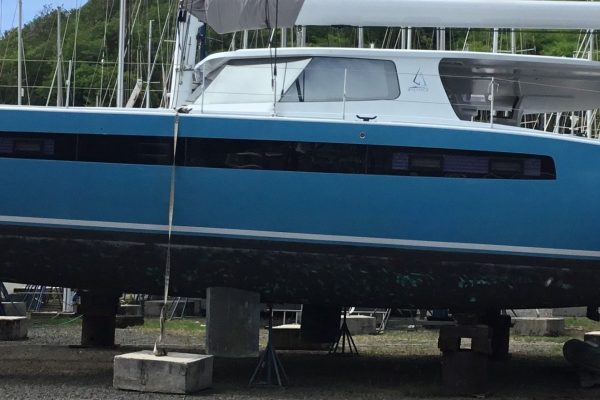
By: Phillip Berman, published with editor’s permission from Boating NZ and Blue Water Sailing
In my forty-five year career in the catamaran industry there’s been a relentless debate on the virtues and vices of daggerboards versus fixed keels. This debate has, however, mostly been waged without “hard numbers” from which to compare performance differences. As we have had requests at Balance Catamarans for both keels and daggerboards, Anton Du Toit (my design partner) and I felt we should conduct a study, the results of which follow.
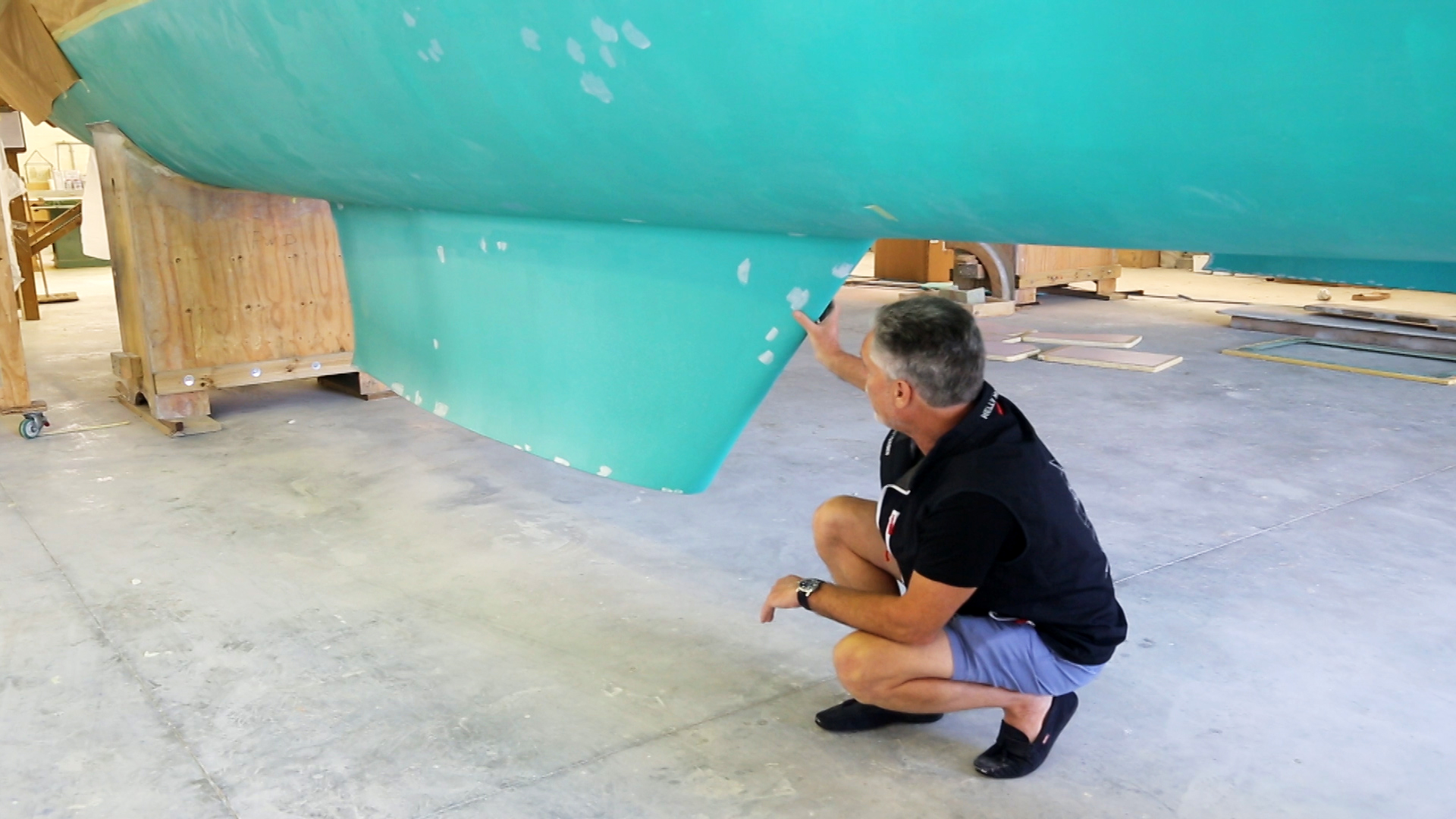
When we first set out to design and construct the Balance 526 we were aiming for cruising couples who wanted more performance and quality than they could find in mass production cats, but also more interior space, payload capacity and ease of use and maintenance than consumers focusing primarily on speed. Our intent was to find the balance – not to create the “lightest and fastest 52” in the world, or the “largest 52,” but a catamaran that could sail swiftly on all points of sail, carry significant levels of payload, yet still be gracious to live on. We also wanted her to be pleasing to the eye.
Our focus at Balance brings us an interesting range of buyers, some of whom are more focused on strength, space, safety and comfort rather than all out speed (cruiser types), others who are more speed focused, less value oriented, and prepared to give up comfort, ease of operation and payload capacity to go a bit faster (racer types). The later sorts of buyers are mostly what I affectionately call “spreadsheet guys.” (Full disclosure: I am not a spreadsheet guy. I am far more focused on how a boat lives, how tough she is, what she can carry, and how simple she is to sail and maintain without a professional crew.)
As we have gone along a few of our customers have asked if we would create the 526 with performance keels rather than daggerboards. They felt that the advantages of keels trumped the performance advantages of boards. We were happy to comply, so Anton set about to design high performance keels for the 526. (Note: On our 451, we only offer her with dual daggerboards and two shallow permanent fixed minikeels. On all other Balance designs it remains customer choice which configuration they wish to have.)
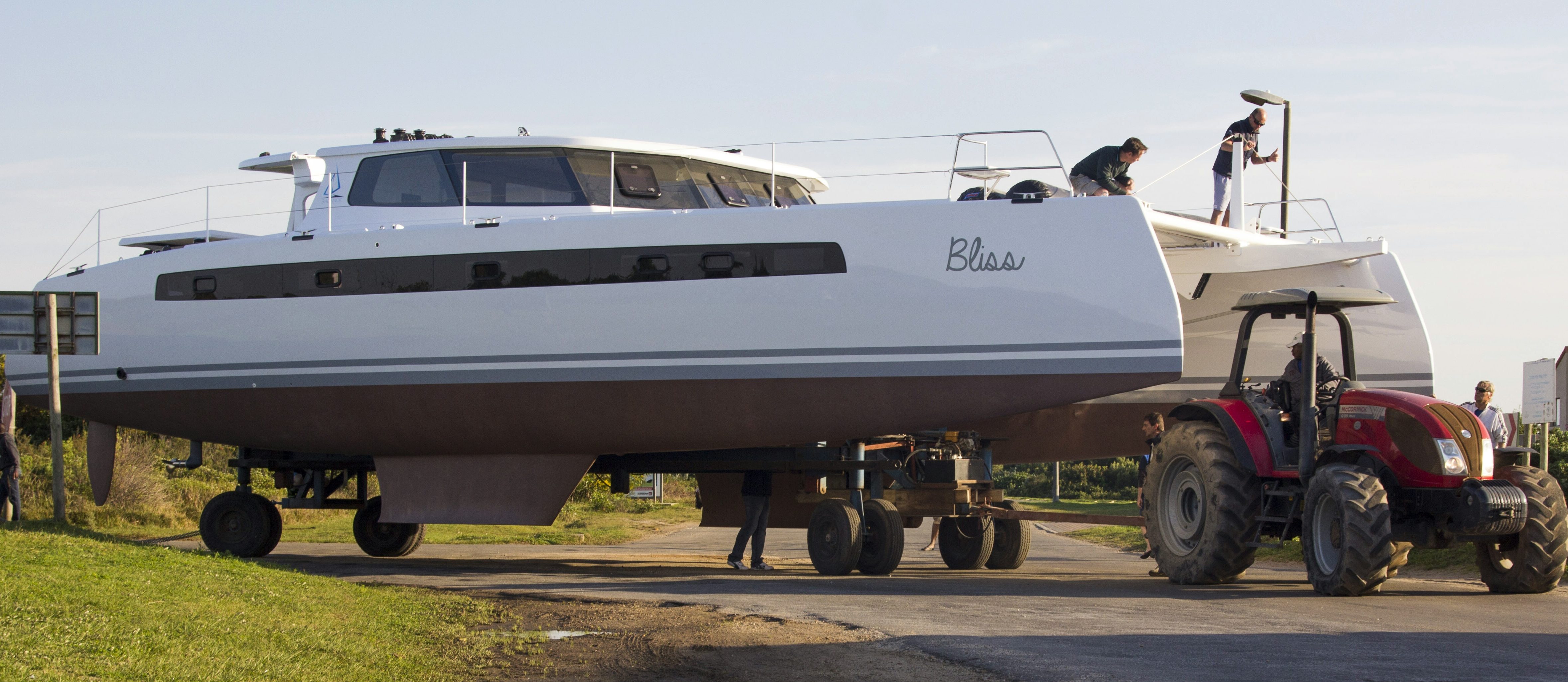
What we were not prepared to do was tell 526 buyers how much faster or slower the two different configurations would be. We felt it best to heed Lord Bryon’s advice to evade “kant and hyperbole” (the language of the day at boat shows!) so we hired the Wolfson Unit for Marine Technology and Industrial Aerodynamics at the University of Southampton to conduct comparative studies of the two configurations on identical 526 models. When you are comparing identical products with just two different variables it seemed a worthwhile study to undertake and share with our customers. It also becomes, to some extent, a worthwhile study for anyone considering a new or used catamaran purchase who is curious how the two different configurations impact performance.
While Anton and I believe these studies can be used by consumers to compare the relative performance differences between boards and keels, it is important to note that the 526 is a very light, narrowhulled epoxy performance cat and the keels we install are considerably finer, deeper and more carefullyshaped than those found on mass production designs. Additionally, we conducted the study with the daggerboards in the fully down position on all points of sail to reduce the studies complexity. The daggerboarded 526 would be marginally faster than the study indicates off- the-wind with boards raised due to a further reduction of wetted surface.
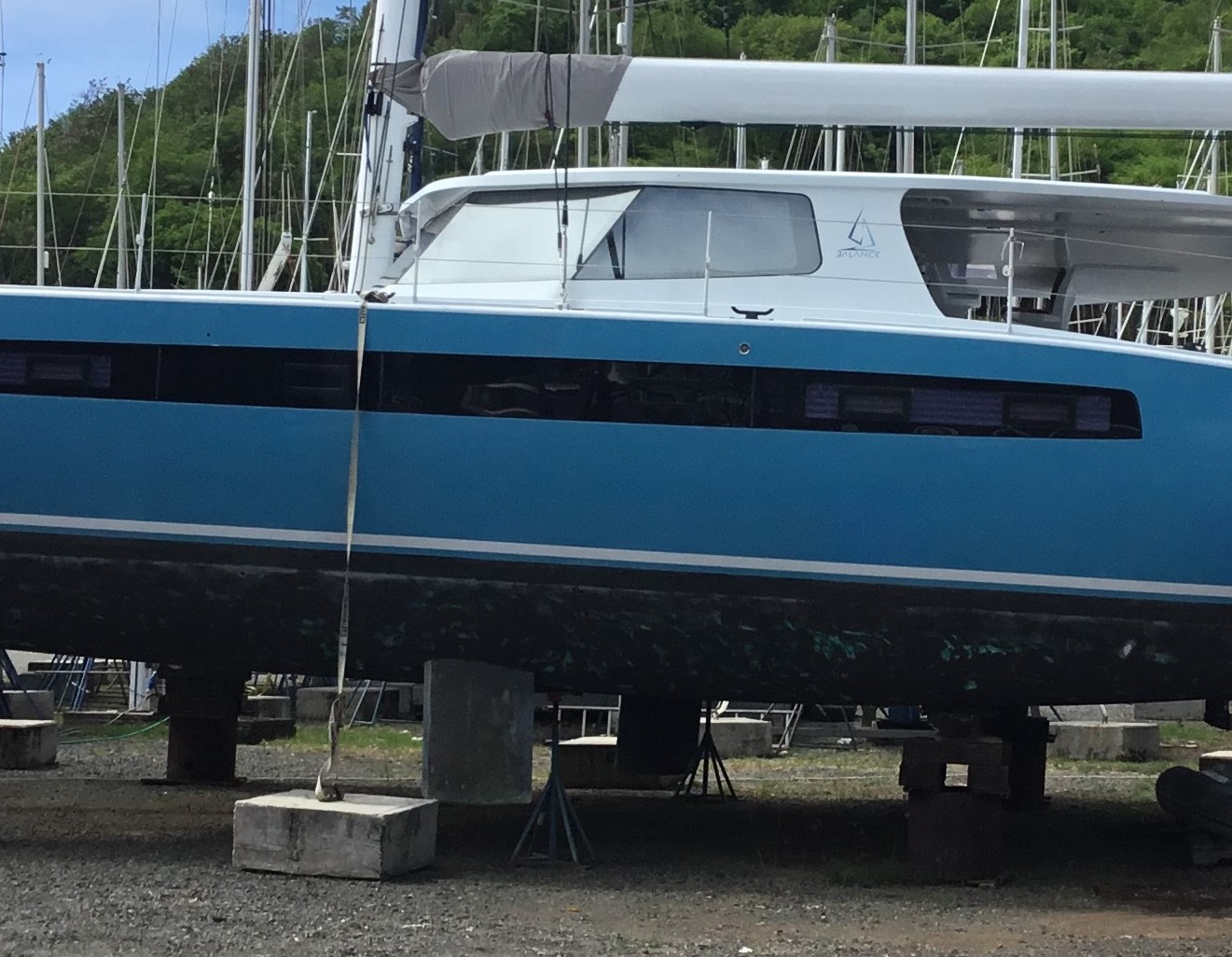
The disparity between keels and boards on a mass-production cat compared to a Balance or any other performance cat would be exaggerated considerably compared to the study that follows. I would note that we erred on the side of caution in setting our lightship weight for this study at 12.5 kg. We have carefully lode cell weighed our 5th boat and the actual lightship weight is 12,215 kg, or 26,930 pounds for the keeled 526 and 12,261 kg, or 27,030 pounds for the daggerboarded 526. Our lightship weight could be lower for customers prepared to put their boats on a diet, or sacrifice quality in several areas, but we have found that they want as much cabinetry as possible, folding tables, glass salon windows, Corian counter tops, and high-end flooring inside and out, etc. Spreadsheet guys miss the mark on this subject constantly in my experience. They also wrongly compare boats based on length, rather than the interior volume of the hulls and bridge – what I call the sum total of fiberglass parts. Regardless, the polars closely mimic the high performance our yachts have proven in real life cruising, fully laden, so this gives us great confidence in the studies accuracy.
Performance, of course, is not the be all and end all, so it is important to examine the advantages and disadvantages of boards versus keels beyond speed. They are as follows:
Advantages to Keels:
- No moving parts. One less thing to operate or break.
- If you ground the boat you hit the keels and they are easily repaired and at a low cost generally.
- You can chock the boat more easily on the hard and it is easier to beach in some circumstances.
- They cost less to fabricate.
- You get more room amidships for additional cabinetry.
- The keels add a bit of buoyancy. On a 526 about 1,600 pounds as our keels are large and mostly hollow inside.
- Daggerboards are typically a bit heavier. On the 526 each board and trunk weigh about 50 pounds more.
- Poorly designed boards and trunks can allow the boards to rattle when they are not under load. Keels do not rattle.
Advantages to Daggerboards:
- Boarded cats point higher and side-slip less as the study shows. I have noted that on keeled production cats you can “stick them up into the wind” but they tend to crab horribly when pinched, as such that you must crack off considerably to reduce leeway and sustain momentum. On most of the sea trials I conduct on production cats we “close reach” to windward on sea trials. This is less the case on deep, finely shaped performance catamaran keels.
- The draft on most keeled catamarans is deeper than the draft on daggerboarded cats. Our 526 keeled version draws about 12 inches more than the daggerboarded version. On daggerboarded cats the rudder tip usually represents her deepest draft. It is important to note that some cats carry very stubby keels to sustain shallower draft, but the shallower the keel the less well she performs when sailing close to the wind. This is important to keep in mind if you are comparing performance on fixed keeled production cats.
- Off the wind with the boards raised to 1/4 there is less drag and the boat steers and sails faster and more playfully.
- The daggerboarded cat is a bit faster and makes less leeway on nearly all points of sail as the study shows in the majority of wind conditions.
- An equally efficient set of keels have much more wetted surface than daggerboards, almost 4 times more. This is the case on our 526 keels.
- Daggerboards set properly can assist in preventing a cat from a “tripping capsize” in very high winds with large breaking cross seas. Both boards can be fully raised, or only the leeward board raised, so the boat can side-slip easily.
- Daggerboarded cats tend to have a bit higher resale value due to the fact that so few are produced in mass production. A buyer that wants boards will only focus on catamarans that have them.

Shifting our focus now to the performance data generated by Wolfson Unit. Their analysis returned the predicted boat speed and leeway angle for the Balance 526 with a keel design and daggerboard design for all combinations of true wind speed from 4 to 25 knots and true wind angles from 40 to 180 degrees. We can begin comparing these two configurations by directly comparing the speed and leeway at major points of sail, specifically beating, close, beam and broad reaching.
While beating the two designs are predicted to perform as follows: To summarize the upwind comparison, the daggerboard design is, on average, expected to sail 1.5 knots faster and 1.75 degrees higher. While close reaching the daggerboard design has less of an advantage than when beating, as can be seen from Table 2:
While close reaching the daggerboard design is expected to sail 0.5 knots faster and 0.75 degrees higher.
As the true wind angle approaches 90° for a beam reach, the keel and daggerboards become more closely matched.
In the beam reaching comparison the daggerboard design will sail slightly higher with a leeway advantage of about 0.25 degrees but it’s speed advantage in 5 knots TWS of 0.3 knots will fade to a 0.5 knot deficit in 16 knots TWS. At this point of sail the two designs are considered to have equal performance as the differences in leeway and boat speed are negligible.
Finally, while broad reaching the following speeds and leeway’s are expected.

In summary, when broad reaching the daggerboard design regains a slight advantage, as it maintains an additional 0.5 knots of boat speed. Leeway differences are again negligible.
Considering the above analyses, it can be seen that the daggerboard design will typically not only outperform the keel design but also out point it, make less leeway close to the wind, therefore giving the daggerboard design a substantial advantage when racing, or for performance focused sailors.
This data gives a fair comparison of the two designs at specific true wind speeds and angles but in order to fully understand the performance trends and enable better predictions between them, one must consider the entire range of wind conditions and all points of sail. This is best done with the use of speed and leeway deltas, where the differences between the two designs are calculated and analyzed.
The following two figures display the average speed and average leeway deltas. The calculation process to determine the deltas is chosen such that a positive value for the delta indicates an advantage for the daggerboard design, and a negative value favors the keel design. For example, a speed delta of +2 knots and a leeway delta of -1 degrees means that the daggerboard design is 2 knots faster than the keel design under the same conditions but would sail 1 degree lower than the keel design.
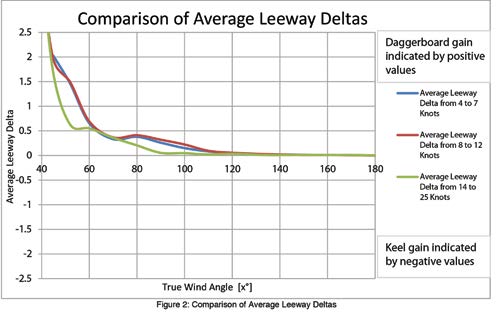
Counter to this, while still on a beam reach but when moving from a low wind condition to a high wind condition, the keel design begins to perform better. This is now taken from the green line (14 to 25 knot TWS range) and gives a -0.6 knot reading. Therefore the daggerboard design is now expected to be about 0.6 knots slower than the keel design under the new, higher TWS conditions.
Figure 2 is used in the same manner as Figure 1 but shows the leeway angle of each design rather than boat speed. Focusing again on a beam reaching condition, the leeway deltas indicate that the daggerboard will always out point the keel design as all three lines (TWS from 4 to 25 knots) indicate. positive values of 0.3, 0.35, and 0.1 degrees at 90 degrees TWA. Overall, Figure 2 shows that the daggerboard design has a significant gain in leeway over the keel design at all wind speeds and angles. This reaches a maximum when beating (TWA ±40-45 degrees) of 2 degrees, and declines to zero when running (TWA ±180 degrees).
With respect to the average boat speed deltas, Figure 1 shows that the daggerboard maintains a higher boat speed when sailing in light and medium winds (red and blue lines in Figure 1). In stronger conditions (green line) the daggerboards yield better boat speed when beating but the keel surpasses this between TWA of 60 to 145 degrees. Keeping in mind that the study was conducted with the daggerboards fully down at all times, in reality, the daggerboards will be raised in the 60 to 145 TWA range. As such the study slightly underestimates the speed of the daggerboard design over this TWA range.
Overall the daggerboard outperforms the keel in both boat speed and leeway in the vast majority of sailing conditions and is thus considered to be the better design choice if achieving ultimate performance is the key criteria. It should be noted that this study is specific to the Balance 526, but corresponding trends can be expected in performance cats of similar size and design.
In the end, and it is a point I cannot stress enough to any boat purchaser, all boats are sets of compromises and trade-offs, and so too with features – helm designs, sheeting systems, rig layouts, bimini designs, bed designs and locations, baths, engine placement, etc. Because I have been deeply involved in brokerage catamaran sales much of my life I recognize there is no one right or wrong boat, certainly no perfect boat, only a boat that happens to be a better fit for a particular sailor and his or her budget, cruising agenda and specific aesthetic proclivities.
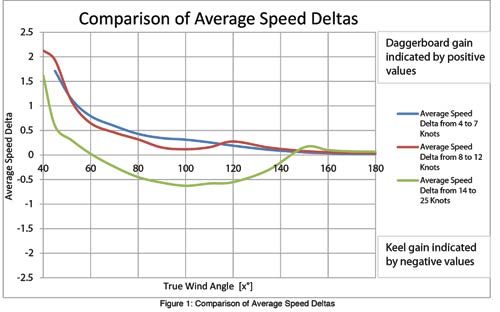
At least now we can say that if someone wants a 526 with keels, here is how she will perform compared to a boarded version. It is then up to the buyer to decide which configuration is the most appealing to them. I will say that, based on the five 526 we have sailing today, with over 60,000 miles of sailing behind them, those owners with keels seem quite happy, just as those with boards.
Alright spreadsheet guys, here’s your numbers to mess with!
Phil Berman is a former Hobie Cat World Champion and the founder of The Multihull Company, a global catamaran yacht brokerage firm. He is also the owner of Balance Catamarans, a boutique brand of high-end performance voyaging catamarans. He can be reached at [email protected] .
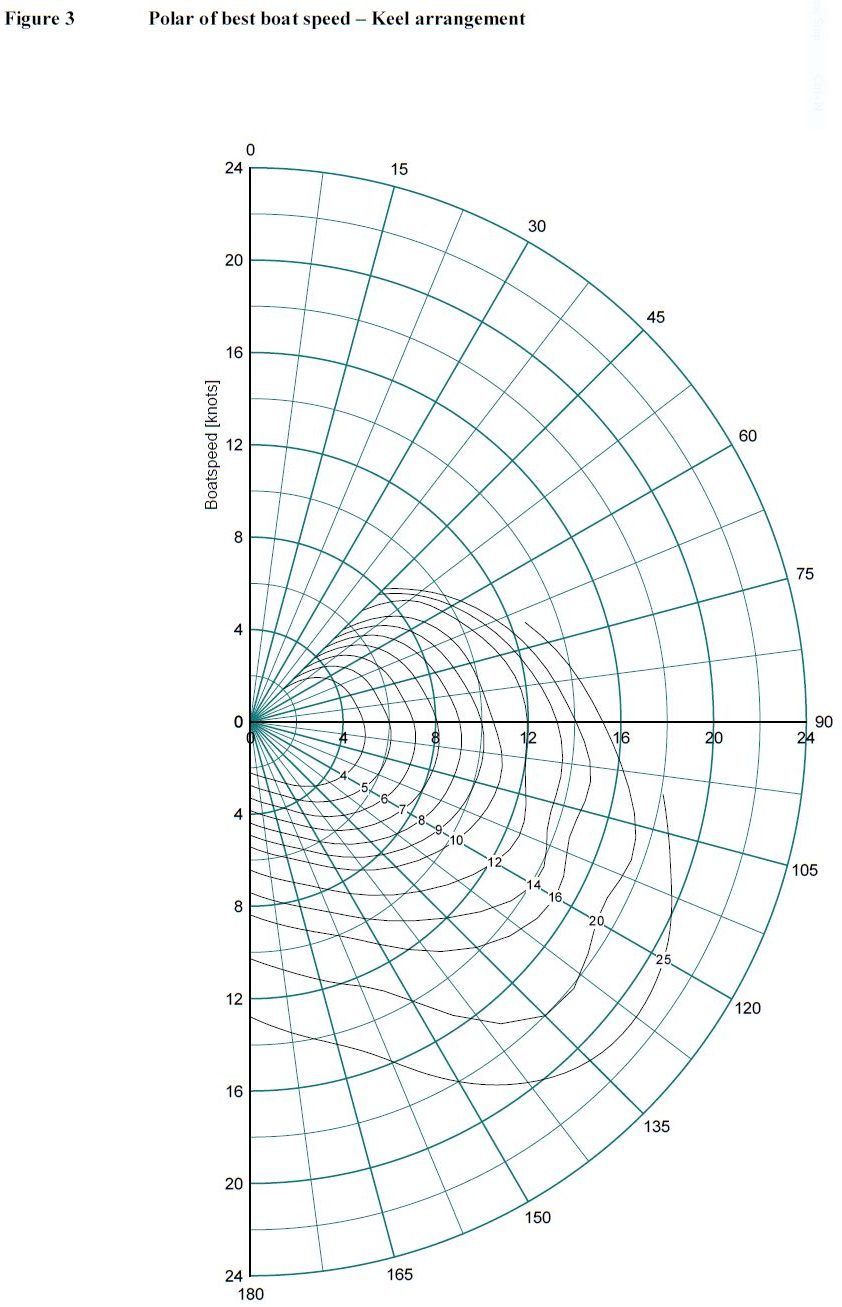
About Phillip Berman
- Are you a Spreadsheet Guy?
- Balance Catamarans is Born: A Bold Move in a Challenging Market
- Can a catamaran really sail upwind?
- Catamaran Depreciation
- Catamaran Vs Monohull
- Daggerboards vs. Keels
- Lessons Learned From A Free Spirit
- Placing a Boat Into Bare Boat Charter
- Post Survey Negotiations
- Saildrives or Straight Shafts? Which is Best For Me?
- Seller's Guide To Yacht Sales
- The 14 Biggest Mistakes When Purchasing a Used Catamaran and How to Avoid Them
- The 14 Biggest Mistakes When Purchasing a Used Cat…and How to Avoid Them Part Two
- The Perils of Internet Catamaran Shopping
- The Ten Commandments of Buying a Catamaran
Recent Posts
The multihull company announces the sale of the first pre-owned balance 482.
- Introducing the Tao 452: On Display At The Annapolis Boat Show October 12 - 15, 2023
Join Us At The Annapolis Boat Show Aboard the Voyage 590
The multihull company announced as dealer for the voyage 590, 6 great starter catamarans, ian edmonson joins tmc as yacht broker in fort pierce, fl., the multihull company opens new office in virginia, the multihull company named exclusive dealer for dolphin catamarans and their new model, the dolphin 380.
- Selling Your Catamaran in Panama
Visit Us at the 2023 Miami Boat Show
Categories: Articles , Articles by Phil Berman , Balance Catamarans , Catamaran Handling , Cruising Lifestyle , Design and Construction
Recent News
The Multihull Company is pleased to announce the closing on the Balance 482 "SeaLife" We wanted to take a moment and thank her new owners on their amazing new catamaran, and to also congratulate our team handling the sale. TMC agent Andrew Hodgdon successfully represented the buyers on the sale of the vessel, while TMC CEO Will Miller represented the...
The Multihull Company is pleased to announce their appointment as a dealer for Voyage Yachts and their new model – the Voyage 590! The Voyage 590 is being celebrated as the ultimate, luxury sailing catamaran with all the comforts of home surrounded by panoramic views of paradise. She maximizes luxury accommodation and comfort, with the performance and blue-water capability characteristic...
In early 2023, Cruising World approached us to seek our opinion on recommending a couple of brokerage catamaran options for first time catamaran buyers to consider when they first stepping into the catamaran market. Here are six boats hand-picked by The Multihull Company’s president and CEO, Capt. Will Miller, as excellent choices for brokerage-catamaran seekers. These are all worth a...
The Multihull Company, the world’s leader in multihull sales and service is excited to announce that it has been named the exclusive dealer for Dolphin Catamarans, a premier builder of high-quality catamarans, and their newest model, the Dolphin 380, designed by Philippe Pouvreau. "We are thrilled to be working with Dolphin Catamarans again and to be able to offer their...
The Multihull Company is thrilled to announce our participation in the Miami Boat Show, taking place on February 15-19, 2023. As one of the premier boat shows in the world, this event is the perfect platform for us to showcase our wide range of high-quality multihulls for sale. We are committed to providing our customers with the best experience possible,...
Introducing the Tao 452: On Display At The Annapolis Boat Show October 12 – 15, 2023
The Multihull Company is thrilled to unveil the new Tao 452, an exciting addition to the world of blue-water performance cruising catamarans. Meticulously engineered and crafted to perfection, the Tao 452 is set to redefine the catamaran experience for sailors worldwide. If you've ever felt the need for more sailing performance from your current production charter catamaran or been disappointed...
The Multihull Company is excited to announce its participation in this year's Annapolis Sailboat Show. The event will be held from October 12 - 15, 2023 in downtown Annapolis, and The Multihull Company will be showcasing the exquisite Voyage 590 catamaran from Voyage Yachts. The Annapolis Boat Show is a highly anticipated annual event that brings together boating enthusiasts, industry...
The Multihull Company is thrilled to announce the appointment of Ian Edmonson as a yacht broker at its newly opened Fort Pierce location. Ian brings a unique blend of boating passion, brokerage experience, real estate expertise, and customer-focused mentality to the team. Ian's love for boating began at an early age and has only continued to grow, leading him to...
We are thrilled to announce that Alan Prater has joined The Multihull Company team as a Yacht Broker in Virginia covering the Hampton Roads area of Virginia. With a lifelong passion for the water and a career spent in the US Navy and as a maritime training professional, Alan brings a wealth of experience and expertise to our team. Alan...
- Read All Articles
We take pride in our happy customers
Your team delivered on every mark. You’ve got an amazing broker in Mark Wattrus and I’m confident you will have continued success moving forward together. He was available 24/7 whenever I had questions. We had a great initial visit on the boat and his marketing plan and photos were superb
I bought a yacht that I had never seen. I did this because I trusted my broker Andrew Holland. It was not an easy job for Andrew, as I am an experienced boat builder and owner of previous yachts, but work in West Africa. Imagine how hard it was to communicate what I was looking for. Andrew came up with exactly what I wanted. He dealt with time delays, all my questions at odd hours, and was there for the survey. He reported honestly and professionally. After buying the yacht, I arrived at the boat on a Sunday night, after dark, after travelling from West Africa to the Caribbean, and found it was better than expected. He never pulled punches and made me aware of shortfalls. I expected to spend my one month leave working on the boat, but actually spent less than one week, and was able to spend 3 weeks sailing – wonderful bonus.
Thank you Andrew for putting up with all my questions, all my worries and all my crazy out of the time zone concerns – you were totally professional, but also I know that if and when we meet up, it will be like a friend finally meeting. You are always welcome on Aseka.
— Beverly Cory
Outstanding company with professional subject matter experts. If I were to buy or sell cruising sailboat, particularly a catamaran, Andrew would be my go to broker.
I have been sailing since I was a child and attended Massachusetts Maritime Academy. But when my wife and I began the process of purchasing an ocean cruising/racing catamaran, I realized that this is a world unto itself. Obviously, we needed to find someone knowledgeable to help us make an informed decision. More importantly, we needed someone honest and willing to put our interests before his or her own. I was lucky to work with Phil Berman at The Multihull Company. He repeatedly shunned the fast buck, choosing instead to work the long road to connect us with the “perfect boat”. I would be glad to recommend Phil and his company to anyone planning to purchase or sell a performance sailing machine.
— Eric Boutiette
Andrew Hodgdon was our broker when we bought our 2018 Lagoon 450F in Antigua in April 2922. He provided great service and was very attentive to our needs. We would highly recommend Andrew and the Multihull Company.
Trust & Expertise About Us
Successful relationships cannot exist without it. At The Multihull Company we base every relationship on a firm commitment to earning and retaining our client’s trust.
Advice of any kind is valuable only when grounded in hard-won expertise. It too, must be trustworthy. Trust and expertise define the heart and soul of The Multihull Company. We are a team of skilled professionals who thrive on providing expert, trustworthy advice and service to catamaran and trimaran sailors around the globe.
Follow us @themultihullcompany
- Pre-Owned Sales
Global Locations
New England +1-267-324-9067
Philadelphia +1-215-508-2704
Virginia +1-757-407-2526
Annapolis +1-703-350-8160
Charleston +1-843-364-4123
Brunswick +1-937-243-2213
Saint Augustine +1-910-477-2508
Fort Pierce +1-904-315-0997
West Palm Beach +1-561-312-0010
Ft. Lauderdale +1-484-744-2740
Miami +1-513-677-5338
San Francisco +1-215-508-2704
Seattle-Tacoma +1-206-297-1151
St. Martin +590 690 58 66 06
Grenada +1-473-457-3245
Puerto Rico +1-787-379-7348
Panama +1-305-735-1661
Trinidad +1-868-680-8909
Croatia +385 95 849 8009
France +33 (0) 6 73 97 17 30
Mauritius +1-215-508-2704
Australia +61 (0)7 5444 4822
Cape Town +1-843-614-2028
© Copyright 2024 The Multihull Company. All rights reserved.

My Cruiser Life Magazine
Basics of Sailboat Hull Design – EXPLAINED For Owners
There are a lot of different sailboats in the world. In fact, they’ve been making sailboats for thousands of years. And over that time, mankind and naval architects (okay, mostly the naval architects!) have learned a thing or two.
If you’re wondering what makes one sailboat different from another, consider this article a primer. It certainly doesn’t contain everything you’d need to know to build a sailboat, but it gives the novice boater some ideas of what goes on behind the curtain. It will also provide some tips to help you compare different boats on the water, and hopefully, it will guide you towards the sort of boat you could call home one day.
Table of Contents
Displacement hulls, semi displacement hulls, planing hulls, history of sailboat hull design, greater waterline length, distinctive hull shape and fin keel designs, ratios in hull design, the hull truth and nothing but the truth, sail boat hull design faqs.

Basics of Hull Design
When you think about a sailboat hull and how it is built, you might start thinking about the shape of a keel. This has certainly spurred a lot of different designs over the years, but the hull of a sailboat today is designed almost independently of the keel.
In fact, if you look at a particular make and model of sailboat, you’ll notice that the makers often offer it with a variety of keel options. For example, this new Jeanneau Sun Odyssey comes with either a full fin bulb keel, shallow draft bulb fin, or very shallow draft swing keel. Where older long keel designs had the keel included in the hull mold, today’s bolt-on fin keel designs allow the manufacturers more leeway in customizing a yacht to your specifications.
What you’re left with is a hull, and boat hulls take three basic forms.
- Displacement hull
- Semi-displacement hulls
- Planing hulls
Most times, the hull of a sailboat will be a displacement hull. To float, a boat must displace a volume of water equal in weight to that of the yacht. This is Archimedes Principle , and it’s how displacement hulled boats get their name.
The displacement hull sailboat has dominated the Maritimes for thousands of years. It has only been in the last century that other designs have caught on, thanks to advances in engine technologies. In short, sailboats and sail-powered ships are nearly always displacement cruisers because they lack the power to do anything else.
A displacement hull rides low in the water and continuously displaces its weight in water. That means that all of that water must be pushed out of the vessel’s way, and this creates some operating limitations. As it pushes the water, water is built up ahead of the boat in a bow wave. This wave creates a trough along the side of the boat, and the wave goes up again at the stern. The distance between the two waves is a limiting factor because the wave trough between them creates a suction.
This suction pulls the boat down and creates drag as the vessel moves through the water. So in effect, no matter how much power is applied to a displacement hulled vessel, it cannot go faster than a certain speed. That speed is referred to as the hull speed, and it’s a factor of a boat’s length and width.
For an average 38 foot sailboat, the hull speed is around 8.3 knots. This is why shipping companies competed to have the fastest ship for many years by building larger and larger ships.
While they might sound old-school and boring, displacement hulls are very efficient because they require very little power—and therefore very little fuel—to get them up to hull speed. This is one reason enormous container ships operate so efficiently.
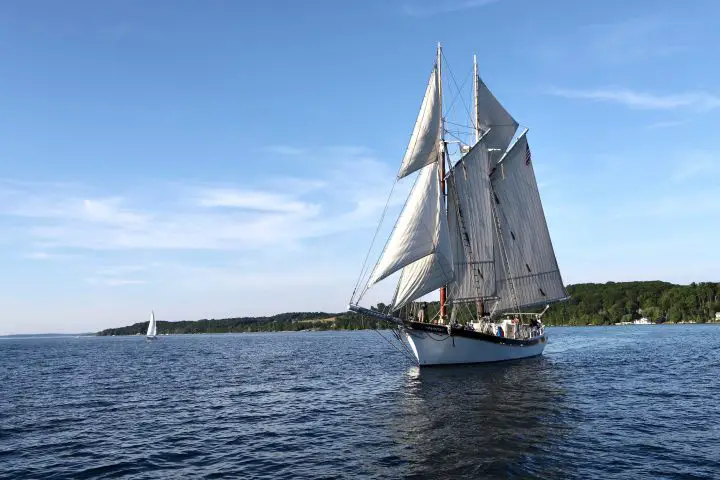
Of course, living in the 21st century, you undoubtedly have seen boats go faster than their hull speed. Going faster is simply a matter of defeating the bow wave in one way or another.
One way is to build the boat so that it can step up onto and ride the bow wave like a surfer. This is basically what a semi-displacement hull does. With enough power, this type of boat can surf its bow wave, break the suction it creates and beat its displacement hull speed.
With even more power, a boat can leave its bow wave in the dust and zoom past it. This requires the boat’s bottom to channel water away and sit on the surface. Once it is out of the water, any speed is achievable with enough power.
But it takes enormous amounts of power to get a boat on plane, so planing hulls are hardly efficient. But they are fast. Speedboats are planing hulls, so if you require speed, go ahead and research the cost of a speedboat .
The most stable and forgiving planing hull designs have a deep v hull. A very shallow draft, flat bottomed boat can plane too, but it provides an unforgiving and rough ride in any sort of chop.
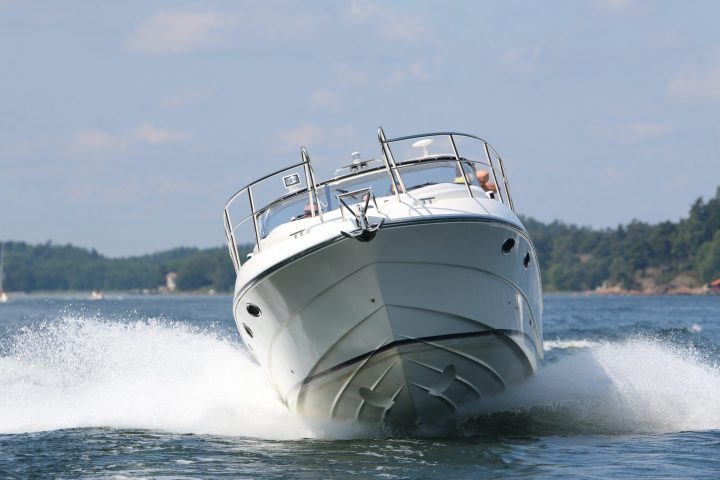
If you compare the shapes of the sailboats of today with the cruising boat designs of the 1960s and 70s, you’ll notice that quite a lot has changed in the last 50-plus years. Of course, the old designs are still popular among sailors, but it’s not easy to find a boat like that being built today.
Today’s boats are sleeker. They have wide transoms and flat bottoms. They’re more likely to support fin keels and spade rudders. Rigs have also changed, with the fractional sloop being the preferred setup for most modern production boats.
Why have boats changed so much? And why did boats look so different back then?
One reason was the racing standards of the day. Boats in the 1960s were built to the IOR (International Offshore Rule). Since many owners raced their boats, the IOR handicaps standardized things to make fair play between different makes and models on the racecourse.
The IOR rule book was dense and complicated. But as manufacturers started building yachts, or as they looked at the competition and tried to do better, they all took a basic form. The IOR rule wasn’t the only one around . There were also the Universal Rule, International Rule, Yacht Racing Association Rul, Bermuda Rule, and a slew of others.
Part of this similarity was the rule, and part of it was simply the collective knowledge and tradition of yacht building. But at that time, there was much less distance between the yachts you could buy from the manufacturers and those setting off on long-distance races.
Today, those wishing to compete in serious racing a building boat’s purpose-built for the task. As a result, one-design racing is now more popular. And similarly, pleasure boats designed for leisurely coastal and offshore hops are likewise built for the task at hand. No longer are the lines blurred between the two, and no longer are one set of sailors “making do” with the requirements set by the other set.
Modern Features of Sailboat Hull Design
So, what exactly sets today’s cruising and liveaboard boats apart from those built-in decades past?
Today’s designs usually feature plumb bows and the maximum beam carried to the aft end. The broad transom allows for a walk-through swim platform and sometimes even storage for the dinghy in a “garage.”
The other significant advantage of this layout is that it maximizes waterline length, which makes a faster boat. Unfortunately, while the boats of yesteryear might have had lovely graceful overhangs, their waterline lengths are generally no match for newer boats.
The wide beam carried aft also provides an enormous amount of living space. The surface area of modern cockpits is nothing short of astounding when it comes to living and entertaining.
If you look at the hull lines or can catch a glimpse of these boats out of the water, you’ll notice their underwater profiles are radically different too. It’s hard to find a full keel design boat today. Instead, fin keels dominate, along with high aspect ratio spade rudders.
The flat bottom boats of today mean a more stable boat that rides flatter. These boats can really move without heeling over like past designs. Additionally, their designs make it possible in some cases for these boats to surf their bow waves, meaning that with enough power, they can easily achieve and sometimes exceed—at least for short bursts—their hull speeds. Many of these features have been found on race boats for decades.
There are downsides to these designs, of course. The flat bottom boats often tend to pound when sailing upwind , but most sailors like the extra speed when heading downwind.
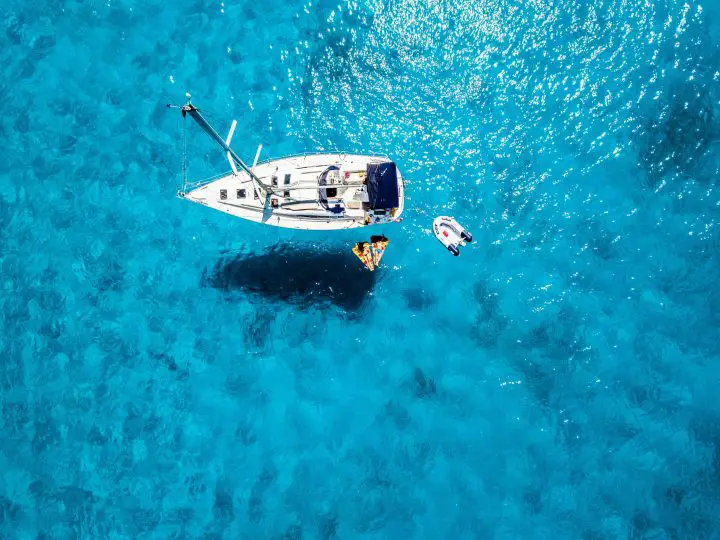
How Do You Make a Stable Hull
Ultimately, the job of a sailboat hull is to keep the boat afloat and create stability. These are the fundamentals of a seaworthy vessel.
There are two types of stability that a design addresses . The first is the initial stability, which is how resistant to heeling the design is. For example, compare a classic, narrow-beamed monohull and a wide catamaran for a moment. The monohull has very little initial stability because it heels over in even light winds. That doesn’t mean it tips over, but it is relatively easy to make heel.
A catamaran, on the other hand, has very high initial stability. It resists the heel and remains level. Designers call this type of stability form stability.
There is also secondary stability, or ultimate stability. This is how resistant the boat is to a total capsize. Monohull sailboats have an immense amount of ballast low in their keels, which means they have very high ultimate stability. A narrow monohull has low form stability but very high ultimate stability. A sailor would likely describe this boat as “tender,” but they would never doubt its ability to right itself after a knock-down or capsize.
On the other hand, the catamaran has extremely high form stability, but once the boat heels, it has little ultimate stability. In other words, beyond a certain point, there is nothing to prevent it from capsizing.
Both catamarans and modern monohulls’ hull shapes use their beams to reduce the amount of ballast and weight . A lighter boat can sail fast, but to make it more stable, naval architects increase the beam to increase the form stability.
If you’d like to know more about how stable a hull is, you’ll want to learn about the Gz Curve , which is the mathematical calculation you can make based on a hull’s form and ultimate stabilities.
How does a lowly sailor make heads or tails out of this? You don’t have to be a naval architect when comparing different designs to understand the basics. Two ratios can help you predict how stable a design will be .
The first is the displacement to length ratio . The formula to calculate it is D / (0.01L)^3 , where D is displacement in tons and L is waterline length in feet. But most sailboat specifications, like those found on sailboatdata.com , list the D/L Ratio.
This ratio helps understand how heavy a boat is for its length. Heavier boats must move more water to make way, so a heavy boat is more likely to be slower. But, for the ocean-going cruiser, a heavy boat means a stable boat that requires much force to jostle or toss about. A light displacement boat might pound in a seaway, and a heavy one is likely to provide a softer ride.
The second ratio of interest is the sail area to displacement ratio. To calculate, take SA / (D)^0.67 , where SA is the sail area in square feet and D is displacement in cubic feet. Again, many online sites provide the ratio calculated for specific makes and models.
This ratio tells you how much power a boat has. A lower ratio means that the boat doesn’t have much power to move its weight, while a bigger number means it has more “get up and go.” Of course, if you really want to sail fast, you’d want the boat to have a low displacement/length and a high sail area/displacement.
Multihull Sailboat Hulls
Multihull sailboats are more popular than ever before. While many people quote catamaran speed as their primary interest, the fact is that multihulls have a lot to offer cruising and traveling boaters. These vessels are not limited to coastal cruising, as was once believed. Most sizable cats and trimarans are ocean certified.
Both catamarans and trimaran hull designs allow for fast sailing. Their wide beam allows them to sail flat while having extreme form stability.
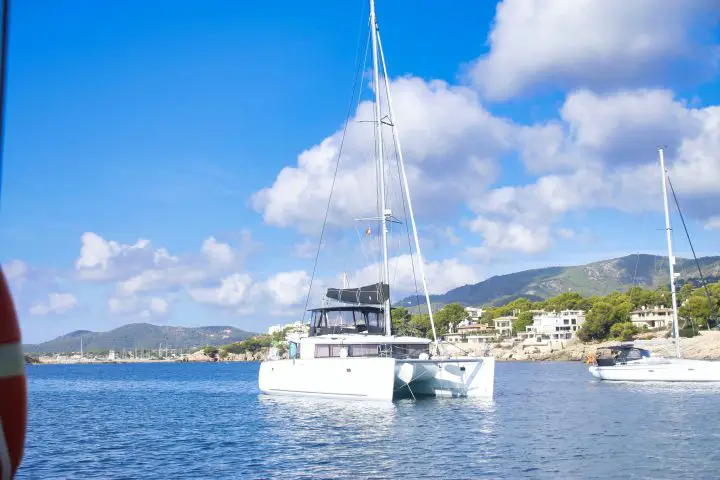
Catamarans have two hulls connected by a large bridge deck. The best part for cruisers is that their big surface area is full of living space. The bridge deck usually features large, open cockpits with connecting salons. Wrap around windows let in tons of light and fresh air.
Trimarans are basically monohulls with an outrigger hull on each side. Their designs are generally less spacious than catamarans, but they sail even faster. In addition, the outer hulls eliminate the need for heavy ballast, significantly reducing the wetted area of the hulls.
Boaters and cruising sailors don’t need to be experts in yacht design, but having a rough understanding of the basics can help you pick the right boat. Boat design is a series of compromises, and knowing the ones that designers and builders take will help you understand what the boat is for and how it should be used.
What is the most efficient boat hull design?
The most efficient hull design is the displacement hull. This type of boat sits low in the water and pushes the water out of its way. It is limited to its designed hull speed, a factor of its length. But cruising at hull speed or less requires very little energy and can be done very efficiently.
By way of example, most sailboats have very small engines. A typical 40-foot sailboat has a 50 horsepower motor that burns around one gallon of diesel every hour. In contrast, a 40-foot planing speedboat may have 1,000 horsepower (or more). Its multiple motors would likely be consuming more than 100 gallons per hour (or more). Using these rough numbers, the sailboat achieves about 8 miles per gallon, while the speedboat gets around 2 mpg.
What are sail boat hulls made of?
Nearly all modern sailboats are made of fiberglass.
Traditionally, boats were made of wood, and many traditional vessels still are today. There are also metal boats made of steel or aluminum, but these designs are less common. Metal boats are more common in expedition yachts or those used in high-latitude sailing.
Matt has been boating around Florida for over 25 years in everything from small powerboats to large cruising catamarans. He currently lives aboard a 38-foot Cabo Rico sailboat with his wife Lucy and adventure dog Chelsea. Together, they cruise between winters in The Bahamas and summers in the Chesapeake Bay.

What’s Behind Different Keel Configurations by Jim Schmicher
In recent years, the superyacht market has become more focused on greater performance by optimizing all aspects of a yacht’s design, engineering and construction.
The choice of the keel configuration is surely one of them.
It’s not surprising that the first three units of the brand new SW105 miniseries will each have unique keel designs to satisfy the requirements of three different owners.
To his end, we’ve asked Jim Schmicker, Vice President of Farr Yacht Design, one of the world’s foremost designer of racing and cruising sailboats, to explain how the choice of the keel design has specific benefits that make it the best choice for a particular owner’s needs.
Jim Schmicker Is Vice President and shareholder of Farr Yacht Design. The company is recognized as one of the world’s foremost racing yacht design studio, based on one of the most impressive winning results records ever compiled by a single company. For more than 30 years, FYD has been developing fast, custom and production cruising yachts. Southern Wind has collaborated with this reputable studio since 1992.

KEEL DESCRIPTIONS
When approaching the cholce of a keel, an owner should be aware that each of the options has advantages and disadvantages but all of them are designed to deliver excellent performance and achieve stringent stability targets while maintaining a similar displacement.
The simplest keel option for construction and installed systems is the fixed keel. The choice of draft for a fixed keel Is decided by balancing upwind performance against reasonable access to ports and anchorages. Reaching and downwind performance is the strongest feature of the fixed keel so long as sufficient stability is achieved. The keel is fabricated out of mild steel plates that are formed and rolled into the correct shape. Considering cost, portions of the keel, such as the leading and trailing edges of the fin, can be CNC machined and the rest hand-faired or the entire keel can be machined. This construction method results in a simple and light structure. Given the shallower draft compared to lifting or telescopic keels a heavier bulb Is necessary to achieve the target righting moment. However, the light fin construction helps to mitigate some of the relatively greater bulb weight. Attachment to the hull is entirely below the cabin sole which facilitates a variety of choices of interior layout with no constraints on either the accommodation or machinery spaces.
Fixed Keel showing Bolt Pattern and Internal Construction

LIFTING KEEL
The lifting keel is a popular choice for superyachts of this size. The ability to raise and lower the keel allows access to ports and anchorages with limited water depth while the deep maximum draft achieves excellent upwind performance. The keel construction is complicated with hydraulic cylinders housed internally to the keel, PLC systems, locking pins to hold the keel In the raised position and adjustable bearing pads to ensure tight tolerances and no movement of the keel In Its trunk while underway. The high number of moving parts and complex hydraulic control systems have associated installation and maintenance costs. The keel trunk takes up significant space In the accommodation but with clever integration with other aspects of the interior its impact can be diminished. The keel is typically constructed out of high strength carbon steel plates welded together and CNC machined to an extremely high level of accuracy. As such, advanced foil sections can be used which results in higher lift to drag ratios being achieved. The lower portion of the keel fin, below the hull in the raised position, is tapered to improve lift efficiency, optimising the amount of surface ares and reducing drag.
Lifting Keel with Tapered Lower Portion Showing Hydraulic Cylinders, Trunk and Bearing Pads

TELESCOPIC KEEL
The telescopic keel combines some of the benefits of the fixed keel and lifting keel. It achieves a similar amount of draft adjustment as the lifting keel with only minor intrusion into the interior. The upper, fixed part of this design is installed partly inside the hull but mostly outside and below the hull surface. The lower, moving part retracts into the upper part and incorporates a foil-shaped shell that slides over the outside of the upper part. Similar to the lifting keel, the telescopic keel is a complex installation with a high number of moving parts and hydraulic systems with associated costs. The fin is typically constructed out of high strength stainless steal plates welded together and CNC machined to an extremely high level of accuracy. The un-tapered planform shape required to house the hydraulic cylinders and structure supporting the lower part results in higher surface area, The fin components have a relatively higher weight and center of gravity.
Telescopic Keel with Un-tapered Lower Portion Showing Hydraulic Cylinders, Internal Structure and Shell

KEEL COMPARISON
Each of the keel designs has specific benefits that may make it the best choice for a particular owner’s needs. In terms of draft, both the lifting and telescopic keels achieve shallow draft (3.15m to 3.65m) without compromising performance as a result of their heavier fins and associated structure. The fixed keel requires an acceptable amount of draft (in this case 4.5 meters) for reasonable upwind performance while still allowing access to the owner’s preferred ports and anchorages. A fixed keel has a much lighter fin and associated structure weight. For the same displacement, it achieves the highest righting moment because the keel has the deepest center of gravity as a percentage of Its draft. A secondary benefit of the fixed keel Is less heeling moment because the sideforce it generates is acting closer to the surface of the water so the fixed keel version operates at a lower angle of heel.
The telescopic keel has the best combination of performance, harbor access and disruption of the interior. Its disadvantages are greater wetted surface, volume outside of the hull and maintenance costs. With specific reference to the Southern Wind SW105 project, because similar displacement was a design requirement, the performance differences between the first three units is not large. However, the deepest maximum draft (5.6m) of the telescopic keel produces the best upwind performance, as a result of its lower induced drag.
The lifting keel (at 5,15m draft) has the next best upwind performance while the fixed keel is strongest in power reaching conditions. For performance versus rating the lifting and fixed keel versions are essentially equivalent over a balanced race course with the advantage going to the lifting keel for more upwind-downwind oriented races and to the fixed keel when the reaching content Is greater. The telescopic keel, with its slightly less efficient keel shape, comes in a very close third place behind the other two options. The initial cost of the fixed keel is the least of the three and ongoing maintenance costs will be less than these of the lifting and telescopic options.
KEEL CHOICES FOR THE FIRST THREE SOUTHERN WIND 105’S
The Southern Wind 105 Is the newest addition to the SWS line of luxurious, performance, blue-water cruising superyachts. The first three yachts constructed will each have unique keel designs to satisfy the requirements of the three owners. The overall parameters of a superyacht of this size, the necessary draft for reasonable upwind performance and the owner’s requirements for keel draft for access to his preferred ports and anchorages have led to fixed, lifting or telescopic keels being viable options.
Design Brief
Desire for an advanced keel design with maximum upwind performance without any significant compromise to the interior layout and saloon space.

Best performance for both racing and cruising and no requirement for a specific minimum draft. The 4.5m draft is designed to achieve the low leeway angles desirable for racing combined with high sailing stability.

Best performance combined with a minimum draft requirement of 3.1m Is the strongest driver of the keel design. Intrusion into the interior is apparent but details of the trunk design allow light across the saloon and avoid a complete separation of the two sides of the yacht.

Explore French Polynesia with Southern Wind

Sail, Surf, Explore: unleash your adrenaline spirit in the Balearic waters

A GREEN REVOLUTION | GELLICEAUX

Sustainable future

A charter with a Southern Wind allows you to live an ultimate cruising experience. Discover our Charter fleet.

Our Brokerage team has been responsible for most of the purchases of SWS yachts for sale. Browse our Brokerage fleet.

Customer Care

Yacht Management
- Privacy Policy
- Cookie Policy
Contact Us
Parts of Catamaran: A Comprehensive Guide to Understanding the Components
by Emma Sullivan | Aug 2, 2023 | Sailboat Racing

Short answer: The key parts of a catamaran include the hulls, bridgedeck, mast(s), rigging, sails, rudders, and daggerboards. These components work together to provide stability, propulsion, and control for this type of multi-hulled watercraft.
Exploring the Essential Parts of a Catamaran: A Comprehensive Guide
From cruising the open seas to enjoying lazy afternoons by the shore, catamarans have become a popular choice for water enthusiasts. With their unique design and exceptional stability, these vessels offer an unmatched sailing experience . But have you ever wondered what makes up a catamaran and how each part contributes to its overall functionality? In this comprehensive guide, we will take you through the essential parts of a catamaran, uncovering their purpose and shedding light on why they are instrumental in making these boats such fantastic options for adventure seekers.
1. Hulls: The hulls are the twin structures that form the main body of a catamaran. These structures play a pivotal role in providing stability and buoyancy while at sea. Catamarans boast wider hulls compared to traditional monohull sailboats, resulting in increased surface area and enhanced stability. The design allows for smoother sailing even in rough waters, as each hull slices through waves independently.
2. Keels: Unlike monohull sailboats that rely solely on a single keel positioned beneath the waterline for both lift and resistance against sideways drift (known as leeway), catamarans often feature two separate skegs or keels attached to each hull. These auxiliary structures enhance directional control and offer excellent stability while reducing drag.
3. Deck: The deck is where all the action takes place! It serves as the primary horizontal surface on which passengers can relax, sunbathe or engage in various activities while aboard the vessel. Catamaran decks usually come with ample space due to their wider design compared to monohull sailboats .
4. Trampoline: One of the standout features of a catamaran is its trampoline – a mesh-like netting stretched between the two hulls just above sea level. While it may seem like an unconventional addition, trampolines provide multiple benefits including giving passengers an exhilarating sensation as they sit or lay above the water. This ample recreational area additionally offers an unobstructed view of the sea, making it an ideal spot for stargazing or simply enjoying the soothing sound of the waves.
5. Cockpit: The catamaran’s cockpit is strategically positioned closer to the waterline, ensuring a thrilling and immersive sailing experience. It acts as the primary control center where the helm is located, allowing sailors to expertly navigate their vessel through various seascapes. Additionally, some catamarans offer spacious cockpits that provide sufficient seating capacity for socializing with fellow passengers or hosting intimate gatherings while at anchor.
6. Rigging: The rigging refers to all lines, cables, and hardware necessary for controlling and adjusting the sails . Catamarans typically employ a simple yet effective rigging system that ensures easy maneuverability and efficient sailing performance. By skillfully managing these components, sailors can harness wind power optimally and maintain smooth cruising speeds in any weather conditions.
7. Sails: Sails are central to a catamaran’s propulsion system, enabling it to move gracefully across bodies of water without relying on fuel-based engines alone. Modern catamarans often embrace a sail plan consisting of multiple sails designed to maximize efficiency and adapt seamlessly to varying wind strengths and directions. With innovative designs such as fully battened mainsails and lightweight genoas, these boats have become incredibly agile even when faced with challenging wind patterns.
8. Engines: While a catamaran’s sails provide a significant portion of its power source, auxiliary engines are still crucial for many aspects of sailing life – be it docking in tight spaces or maneuvering during low-wind situations. These engines are usually mounted within each hull beneath deck level as part of an integrated propulsion system comprising shafts, propellers, and operational controls.
9. Navigation Instruments: In today’s era of advanced technological aids, catamarans make use of a range of navigation instruments to enhance safety and efficiency. From GPS systems providing precise positional information to depth sounders measuring water depth, these sophisticated tools are essential for ensuring smooth journeys and avoiding potential hazards.
So there you have it – a detailed glimpse into the essential parts of a catamaran. Wherever your sailing adventures take you, now you can fully appreciate how each component contributes to the incredible performance and unrivaled experience offered by these magnificent vessels. So hop aboard a catamaran and embark on your next nautical journey with confidence!
How to Identify and Understand the Various Components of a Catamaran
Catamarans are fascinating vessels known for their unique design and exceptional performance on the water. Whether you are a seasoned sailor or just interested in learning more about these incredible boats, understanding their various components is essential . In this blog post, we will take a detailed, professional, witty, and clever dive into the world of catamarans and shed light on how to identify and understand their different parts .
1. Hulls: At the core of any catamaran are its hulls – the main supportive structures that keep the boat afloat. Unlike traditional single-hulled vessels, catamarans have two parallel hulls connected by a deck. These hulls play a vital role in providing stability and minimizing drag while sailing. Think of them as the sturdy legs that help the catamaran gracefully glide through the water .
2. Deck: The deck serves both as a platform for enjoying your time onboard and as an important structural element that connects various parts of the catamaran. It consists of multiple areas such as the helm station (where you control the boat), seating areas, dining spaces, trampoline nets for lounging, and storage compartments. Sunbathing or hosting friends for a sunset gathering? The deck has got you covered!
3. Rigging: If you’ve ever looked up at a sailboat’s mast with admiration, then you’ll love discovering how rigging contributes to a catamaran’s overall performance and elegance. The rigging includes all the supporting wires and ropes that hold up the mast(s) on your catamaran and control its position relative to wind direction (known as “trimming”). Understanding how to properly trim your sails can greatly enhance your sailing experience – from capturing optimal wind power to achieving picture-worthy maneuvers.
4. Sails: What could be more mesmerizing than watching billowing sails against an azure sky? Catamarans utilize various types of sails based on their purpose – mainsails, jibs, genoas, spinnakers – each designed to maximize performance under specific wind conditions. Learning about the different sails and their characteristics will help you navigate efficiently and make the most of your sailing adventures. Plus, understanding the art of sail trim is sure to impress your fellow sailors!
5. Rudders: Just as a captain relies on his or her compass for navigation, catamarans depend on rudders to steer through the water with precision. Mounted at the stern (rear) of each hull, these ingenious components allow you to control your course by diverting the flow of water passing beneath them. Rudders are essential for maintaining stability and maneuverability when tacking, jibing, or navigating challenging waters.
6. Engines: Catamarans aren’t solely reliant on wind power; they often incorporate engines as auxiliary means of propulsion. These mechanical marvels provide added security and flexibility during low-wind situations or when maneuvering in confined spaces like marinas or crowded anchorages. Understanding how to handle your catamaran’s engines confidently will ensure smooth sailing even when Mother Nature plays hard-to-get.
By expanding your knowledge about these various catamaran components – hulls, deck, rigging, sails, rudders, and engines – you’ll unlock a whole new level of appreciation for these magnificent vessels and gain confidence in navigating them.
Lastly, remember that wit and cleverness go hand-in-hand with professionalism when exploring any topic. So have fun while unraveling the mysteries of catamaran anatomy! Perhaps envision yourself as an expert sailor who can distinguish port from starboard blindfolded or sharpen your comedic skills by jokingly referring to hulls as “feline foundation” (though cats might not appreciate sharing their name with boats!).
Happy sailing!
Step-by-Step Breakdown: Unraveling the Mysteries behind Catamaran Anatomy
Catamarans have become increasingly popular in recent years, mainly due to their unmatched stability and impressive speed capabilities. But have you ever wondered what lies beneath the sleek exterior of these remarkable vessels? In this blog post, we will delve into the intricate details of catamaran anatomy, providing you with a comprehensive understanding of how these boats are constructed and why they excel on the water.
1. The Hulls: The Foundation of Stability At the core of every catamaran lies its hulls – two parallel structures that run alongside each other. Unlike traditional monohull boats that feature a single hull, catamarans distribute their buoyancy across two hulls, offering superior stability even in rough waters. These hulls are typically made from fiberglass or aluminum and are designed to cut through waves effortlessly, minimizing resistance and maximizing speed.
2. Bridging the Gap: The Trampoline One striking feature present in many catamarans is the trampoline located between the two hulls. This sturdy mesh-like material serves various purposes. Firstly, it provides an additional platform for sunbathing or relaxing while underway. Secondly, it acts as a safety net by preventing crew members or passengers from falling into the ocean should any unexpected jolts occur during navigation .
3. Connecting Hulls: The Crossbeams In order to maintain structural integrity and connect both hulls securely, catamarans utilize crossbeams that stretch between them. These crossbeams play a vital role in sharing weight distribution evenly across both sides, ensuring stability and balance at all times.
4. Above Deck: Central Cockpit and Living Space Moving upwards onto the deck area, you’ll discover a central cockpit where most controls and steering mechanisms are located. This strategic placement allows for optimum visibility and easy maneuverability while sailing. Additionally, catamarans often feature large living spaces, including saloons and cabins that provide ample room for socializing, dining, and sleeping. Their spaciousness is a significant factor contributing to their growing popularity among cruising enthusiasts.
5. The Power of Sails: Rigging and Sail Plan Catamarans rely on sails for propulsion, utilizing a complex system of rigging to hoist and control them effectively. A unique feature of catamarans is the absence of a single mast; instead, they employ multiple masts strategically positioned between the hulls. This configuration optimizes sail area while reducing heeling (when a boat tips sideways due to windy conditions), resulting in smoother sailing experiences even during stronger winds.
6. Additional Features: Daggerboards or Foils To enhance performance further, some catamarans are equipped with daggerboards or foils – retractable appendages located beneath each hull. These boards reduce lateral slippage by providing lift, improving upwind capability and enhancing overall speed. As technology advances, advanced hydrofoil systems have also been introduced in certain catamaran models, allowing these boats to glide above the water ‘s surface entirely.
By unraveling the mysteries behind catamaran anatomy step-by-step, it becomes evident why these vessels are highly sought after by both leisure sailors and competitive racers alike. From their stable hull design to innovative features such as trampolines and foils – every element plays its part in creating an exceptional sailing experience that combines comfort, speed, and versatility. Perhaps now you can fully appreciate these engineering marvels whenever you set sight on one gliding gracefully through the waves!
Frequently Asked Questions about the Different Parts of a Catamaran Answered
Have you ever looked at a catamaran and wondered what all those different parts are called? Or maybe you’re thinking about buying or renting a catamaran and want to be familiar with its components . Well, look no further! We’ve compiled a list of frequently asked questions about the different parts of a catamaran and will provide detailed, professional, witty, and clever explanations just for you.
1. What is a Catamaran? A catamaran is a type of boat that consists of two parallel hulls connected by a deck. It offers increased stability compared to traditional monohull boats due to the wider beam. This unique design allows for smoother sailing experiences and more spacious interiors.
2. Hulls – What Are They? The hulls are the main structure of a catamaran, providing buoyancy and supporting the entire vessel. Typically made from fiberglass or aluminum, they have curved shapes that help reduce resistance in the water while providing stability. Think of them as the legs of the feline-inspired boat!
3. Trampoline – Isn’t That for Jumping? While it may sound similar to the equipment used for bouncing around at your local playground, in the world of catamarans, trampoline refers to an open area between the hulls where passengers can relax or even stretch their sea legs! Made from durable materials like nylon mesh or PVC canvas, trampolines provide excellent circulation and an unobstructed view below deck.
4. Rigging – Is it Related to Sailing Techniques? Indeed! Rigging refers to all the elements involved in controlling sails on a catamaran . This includes mast(s), boom(s), standing rigging (shrouds & stays), running rigging (halyards & sheets), winches, cleats – basically everything needed to manipulate wind power efficiently and safely navigate through various conditions.
5. The Mast – How Tall Should It Be? The mast, often made of aluminum or carbon fiber composite, is the tall vertical pole that holds up the sails. Its height depends on several factors, such as boat size, intended use, and the desired sail area. Think of it as the catamaran’s lighthouse – guiding you along your aquatic adventures with grace.
6. Boom – Not Just a Sound Effect! Nope, not just an imitation of an explosion! The boom is a horizontal spar attached to the bottom of the mast, helping support and control the lower edge (foot) of the mainsail. It swings back and forth with changes in wind direction – think of it as a catamaran’s wagging tail!
7. Daggerboards – Are They Catamaran Ninja Weapons? While they may sound dangerous and ninja-worthy, daggerboards are actually retractable foils that extend from each hull into the water. Their purpose? Providing lateral resistance against sideways motion caused by wind force while improving upwind performance by reducing leeway – no martial arts skills required!
8. Rudders – Steering Like a Pro Like most boats, catamarans have rudders for steering purposes. These underwater blades at the stern help control direction by redirecting water flow around them when turned. Whether you’re tacking or gybing through waves or researching rudder-related puns like this one—we’ve got you covered.
So there you have it – frequently asked questions about the different parts of a catamaran answered in detail! Now you can impress your fellow sailors with your newfound knowledge or confidently embark on your next seafaring adventure aboard one of these sleek double-hulled vessels ! Remember to keep exploring and enjoy every nautical mile!
The Key Elements That Make up a Catamaran: Everything You Need to Know
Title: The Key Elements That Make up a Catamaran: Everything You Need to Know
Introduction: Catamarans have long fascinated sailing enthusiasts with their unique design, efficient performance, and spacious interiors. Whether you are a seasoned sailor or a curious novice, understanding the key elements that make up a catamaran is essential. In this enlightening article, we will delve into the intricate details of these remarkable vessels, uncovering the secrets behind their success on the open seas .
1. Hull Design: Stability Meets Speed At the heart of every catamaran lies its dual-hull structure. Unlike traditional monohulls, catamarans feature two separate hulls connected by a spacious deck. This design offers enhanced stability and reduced heeling, making them less prone to capsizing compared to their single-hulled counterparts. The inherent buoyancy allows for faster speeds and smoother sailing experiences—enabling both exhilarating adventures and relaxed cruising.
2. Beam: Embracing Extra Space One of the most significant advantages of a catamaran is its beam—the width between its two hulls—which can be quite impressive. The ample beam creates an exceptionally generous living area that sets catamarans apart from other sailboats . More space means greater comfort for passengers and crew alike; accommodating larger groups, luxurious amenities, and even personalized additions such as Jacuzzis or sunbathing decks.
3. Stability & Balance: A Steady Journey In addition to their unique structural design, catamarans offer exceptional stability through weight distribution and physics principles. With twin hulls spread apart at a considerable distance, it becomes significantly easier to maintain balance during sailing motions—a significant advantage for those susceptible to seasickness or seeking effortless navigation under challenging conditions.
4. Sailor-Friendly Handling: Ease-of-Use at Sea Catamarans excel in terms of maneuverability due to several factors working harmoniously together. Their shallow drafts allow for exploration in shallower waters, and docking becomes a breeze with the ability to navigate narrower marinas. Furthermore, their twin engines operate independently, offering excellent control even in tight spots or challenging wind conditions—a maneuverability dream for sailors of all skill levels.
5. Sailing Performance: Effortless Speed When it comes to performance on the water, catamarans stand tall once again. The efficiency gained from their two hulls reduces drag and enables quicker acceleration, resulting in higher average speeds than traditional monohulls. Even when faced with light winds, their ample deck space allows for customized rigging options—such as efficient sails or high-tech foiling capabilities—that can unlock extraordinary speed potential.
6. Comfortable Living Spaces: An Unprecedented Haven Catamarans redefine on-board living by providing both ample space and superior comfort. The expansive interior saloon offers panoramic views of the surroundings while being versatile enough to cater to various activities—from hosting lively social gatherings to peacefully reading a book by the window. Additionally, private cabins are often located in each hull, creating secluded sanctuaries for relaxation and tranquility amidst enchanting seascapes.
Conclusion: As we conclude our exploration into the key elements that make up a catamaran, it becomes evident why these vessels have become revered in the sailing world . The revolutionary dual-hull design ensures stability and faster speeds while offering unparalleled comfort and spaciousness aboard. Whether you seek adventure or serenity on the seas, understanding these elements will help you appreciate catamarans’ remarkable qualities truly—an embodiment of innovation and maritime excellence brought together harmoniously by human ingenuity.
Mastering the Parts of a Catamaran: A Beginner’s Guide for Sailing Enthusiasts
Are you a sailing enthusiast who is fascinated by the sleek and efficient design of catamarans? If so, then you’ve come to the right place! In this comprehensive beginner’s guide, we will delve into the key components of a catamaran and unlock the secrets to mastering its various parts. So grab your sailor’s hat and get ready to embark on an exciting journey through the intricate world of catamaran sailing!
The first component that sets a catamaran apart from other sailboats is its dual-hulled structure. Unlike traditional monohull sailboats, which have only one hull, catamarans feature two parallel hulls connected by a deck or bridge. This unique design grants them exceptional stability, speed, and even more interior space for amenities such as cabins and lounging areas.
Now let’s move onto a crucial part of any sailboat – the rigging . The rigging system on a catamaran consists of numerous elements that work harmoniously to control and manipulate the sails . Firstly, there are the masts: tall vertical structures that support the sails. Catamarans typically have two masts placed towards each end of the boat , allowing for efficient distribution of power.
Attached to these masts are various types of sails, including mainsails, jibs or genoas (fore-sails), and spinnakers (used for downwind sailing). The main sail is the largest sail on a catamaran and is hoisted up the mast using halyards – ropes specifically designed for this purpose. Jibs or genoas assist in maneuverability by generating additional power when sailing upwind.
For those seeking exhilarating downwind adventures, spinnakers add an extra element of thrill to your journey! These expansive triangular or bulbous-shaped sails catch wind from behind and propel your catamaran with remarkable swiftness. Learning how to handle these different types of sails will be crucial to seamlessly controlling the boat and maximizing performance on the water.
Next in line are the helm and steering system, responsible for guiding your catamaran ‘s path as it gracefully glides through the waves. The helm, often referred to as the steering wheel , is used to control the rudders located at each hull’s stern. One unique characteristic of catamarans is their tilting tendency caused by wind pressure acting upon the exposed surface area of their broad decks. Therefore, mastering steering techniques, including adjusting sail configurations and keel positions, will help you navigate with finesse and maintain balance.
One particularly innovative feature found in some catamarans is a daggerboard or a centerboard system. Located between the two hulls beneath the waterline, these retractable fins can be individually raised or lowered to vary their depth while sailing. By adjusting these boards according to wind conditions and point of sail , you can minimize resistance, optimize speed, and even prevent lateral drift.
We cannot overlook catamarans’ anchoring systems when discussing their components . Anchors are vital for keeping your vessel secure when moored or stopping for a leisurely swim in crystal-clear waters. Most modern catamarans employ bow rollers integrated at the front end that facilitate effortless anchor deployment and retrieval. With an array of anchor types available — from plows to flukes — it’s essential to understand each one’s characteristics in various seabed environments.
Lastly, let’s not forget about safety equipment onboard! While mastering catamaran parts allows for glorious adventures on calm seas, unforeseen challenges may arise during your sailing odysseys. It’s important always to have safety essentials like life jackets, fire extinguishers, first-aid kits, emergency flares, and navigational tools like GPS systems.
So there you have it – a comprehensive overview of key components necessary for mastering the art of sailing a catamaran! Understanding how each piece of the puzzle fits together and harmonizes uniquely will set you on a path to becoming a skilled catamaran sailor . Whether you’re gliding across tranquil bays or tackling exhilarating rough seas, this guide will equip you with the knowledge and confidence to embark on unforgettable nautical journeys!
Recent Posts
- Approaching a Mooring Buoy: Essential Tips for Safe Navigation
- Best Tiller Autopilot: Enhance Your Sailing Experience
- Nautical Navigator: Essential Tools and Techniques for Seamanship
- Sail Making Material: A Comprehensive Guide
- 2 Person Dinghy: The Ultimate Guide to Choosing the Perfect Boat
- Sailboat Gear and Equipment
- Sailboat Lifestyle
- Sailboat Maintenance
- Sailboat Racing
- Sailboat Tips and Tricks
- Sailboat Types
- Sailing Adventures
- Sailing Destinations
- Sailing Safety
- Sailing Techniques
Log in or Sign up
You are using an out of date browser. It may not display this or other websites correctly. You should upgrade or use an alternative browser .
cruising catamaran keel design
Discussion in ' Boat Design ' started by emcmia , Feb 27, 2004 .
emcmia New Member
I have a P43 Privilege, 25 ft beam, 26000 lbs displacement with fixed keels. Each keel is approximately 10 ft in length and extend about 24 inches below the rounded hull form resulting in a total draft of 48 inches. The keels are essentially flat slabs with virtually no foil shape and average about 6 inches wide, flared into hull and tapered at the bottom to about 4 inch width. Underway, either under power (twin 56 hp Yanmars) or sail, especially in shallow water and hull speed over 8 knots, the boat tends to squat, progressively until the bow raises and the waterline at the transom (i.e. swim platforms) submerges as much as 12 inches. I have extended the swim platforms 48 inches which has resulted in adding at least 2 knots to the hull speed. However, the squatting effect has not changed. At the next haulout, I am considering changing the shape of the keels to a foil shape, similar to a conventional aircraft wing but symetrical on both side and tapering the trailing edges to less than 1 inch. The objective is reduce the negative pressure that I believe is occurring aft of the keels due to the turbulence created by the existing keel shape. That being said, I am concerned by the prospects of increasing the drag due to the increased width that will be inherent with new foil shape. Your comments and suggestions would be seriously appreciated. Thanx, in advance.
tspeer Senior Member
I'm not sure changing the cross section of the keel will change the squat. The keels have to produce enough lift to counter the force of the rig, whether they are thin or thick. And that means a pressure difference on each side. Given the extremely low aspect ratio of the keels, the cross section shape may not mean much. Making the keels deeper may be a better bet. Or adding a centerboard that fits entirely within the keel.
san.dam Junior Member
This is a very strange effect on a catamaran. The turbulence of a vey thick trailing edge under the stern may be a part of the problem. The displacement seems high enough to be another part... If the aft sinking occurs only in shallow water,perhaps due to the distortion of the Froude law ,when in shallow water(...) Anyway ,is a very good job to refine the trailing edge, and you can get only advantages.
45' Cruising Catamaran Project
Are keelboats for cruising dead?
Proa Make O'Break, preparing for MICROCRUISING
A new Raidboat and Cruising Dinghy Design for Home Builders
22 Foot Racing/Pocket Cruising Sailboat
Spec. for coastal cruising boat
21ft Lugger for daysailing and coastal cruising
Project: Canting keel for cruising yachts
the Cost of Cruising
West Coast BC cruising platform
- No, create an account now.
- Yes, my password is:
- Forgot your password?

What's the Best Keel Design for Bluewater Sailing?
There are a lot of factors at play in bluewater sailboat design. The keel design is a critical choice for any serious sailor - it will affect performance, comfort, speed, but also durability and safety.
If you prefer comfort and sturdiness and don't mind slower speeds, the best keel design for bluewater sailing are full keels. Fin keels are the proven keel design for people who prefer higher speeds and maneuverability and don't mind decreased durability and a less comfortable sail.
Below we'll quickly touch on the basic keel types and then discuss what makes a seaworthy keel, and explain in detail how the full and fin keels compare.
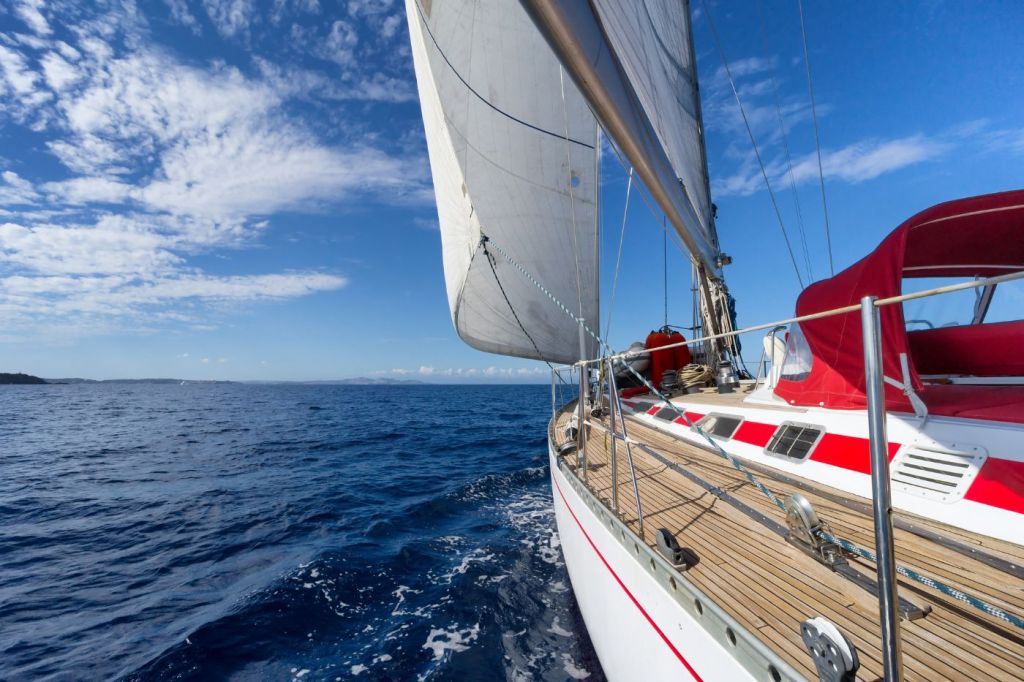
On this page:
Basic keel types, what makes a keel seaworthy, advantages of full keel as a bluewater cruiser, disadvantages of a full keel ocean cruiser, picking a fin keel variant as a bluewater cruiser, hybrid designs, so which keel type is best for bluewater sailing.
Let's look at what keels are out there so you know your options. There are three basic keel types :
- lifting keel
The full keel is a fin running across the boat length. It comes in all shapes and curvatures; for instance, not all span from the absolute front to the absolute back.
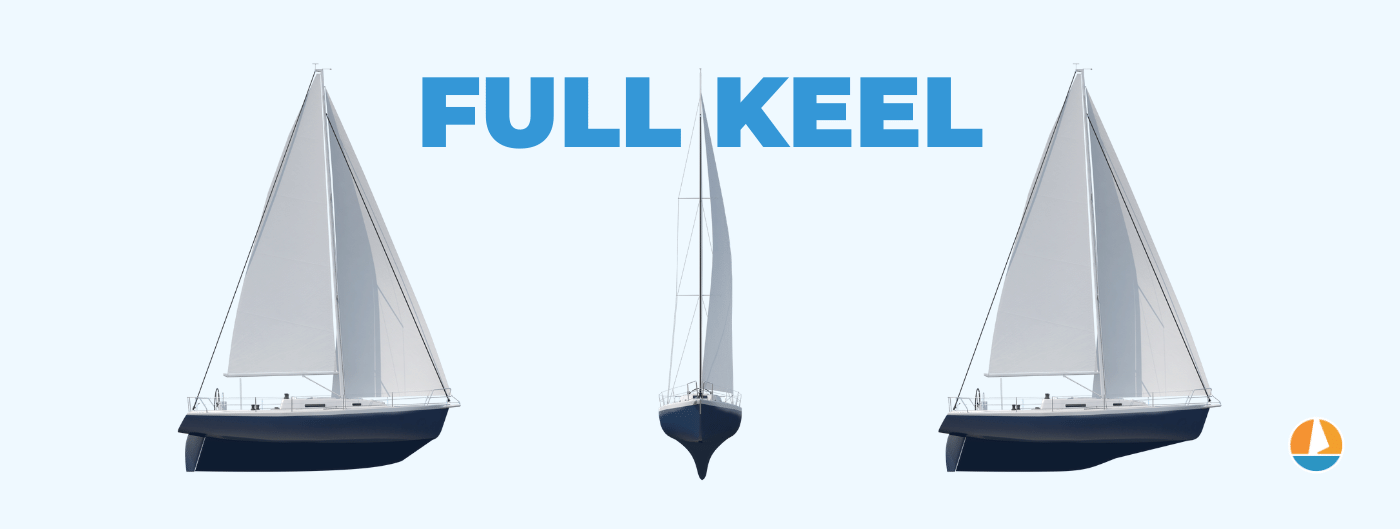
The fin keel is a narrow fin below the boat , usually in the center. It comes with various endings, sometimes with a weight at the tip, adding to the stability, sometimes there are two keels, which helps with performance.
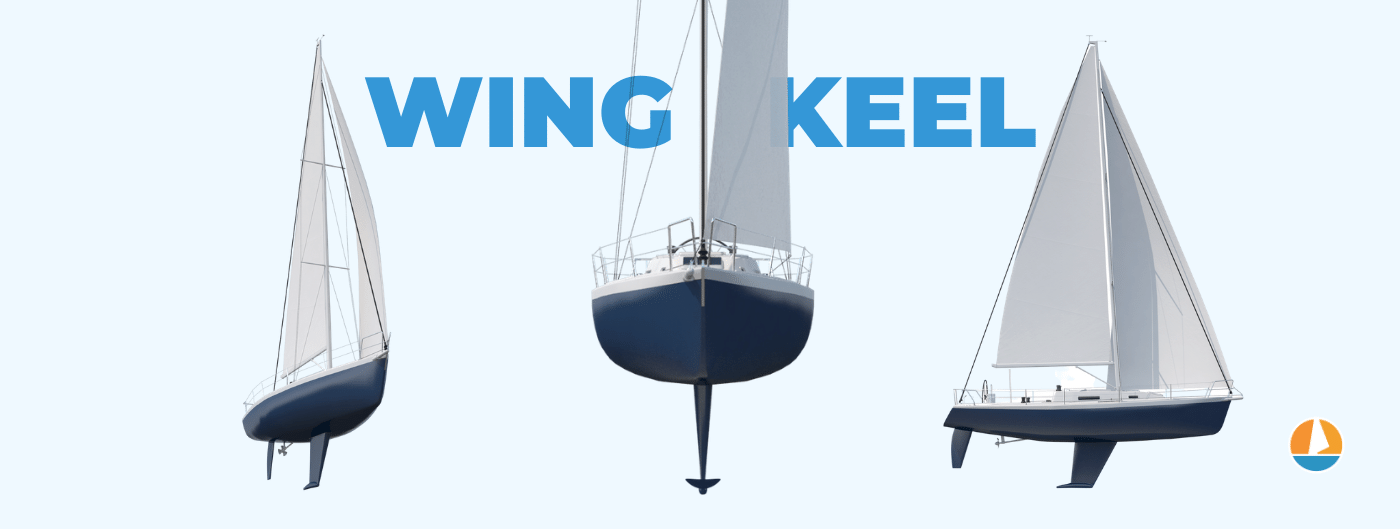
The lifting keel is a fin keel that can be raised . It can be weighted or unweighted , and in some cases they can be lifted all the way, disappearing into the hull. In other cases, they merely lift a bit to gain a more shallow draft.

This is a very rough classification of keel types, and there are plenty more. For a more complete overview, please go over our illustrated guide, which contains a full list of keel types with illustrations and diagrams like the ones above and will help you understand the basics of keel design in ten minutes or less.
In this article, I'll adhere to the three main types of keels, full , fin , and lifting keel.
When it comes to seaworthiness, you need stability to withstand large waves and rougher weathers and either speed to outrun bad weather, or enough rigidity to outlive it.
You want something low maintenance (all things considered) so that it won't be very susceptible to wear and tear and so that it can be repaired with the least amount of tools possible.
On the other hand, you don't have to care much about draft versatility, as you will be mostly in deep waters and you don't need to venture into performance extremes, since racing likely won't be on the menu.
The lifting keel isn't the best bluewater design
Keeping all of the above in mind, we can safely cross off lifting keels in all their variants. They come with too many drawbacks, such as fragility, decreased performance, and less stability provided - for which they offer lesser draft as a trade, but that is a useless feature for bluewater sailors.
The lifting keel design does have its advantages . It is great for navigating shallows. That's why you'll mostly encounter lifting keels among lake sailboats, coastal cruisers, and island hoppers as well as those living in shallow water areas, such as Florida.
Fin keels vs. full keels: both best in their own way
That leaves us with a full keel and a fin keel. And this is where things get tricky. As it turns out, there is no single best answer. Whether you will go with either is up to your preference and sailing style.
Here is what you want to know. If you are a sailor without deadlines, you are in it for the long passages and a lot of time spent on a boat, go with a full keel .
Its extreme amount of wetted surface will contribute positively to stability. The boat will track well and will be less influenced by waves. As far as comfort goes, things won't get any more pleasant (unless you opt for a catamaran).
This means heaving to will be easier, the boat won't rock as much and it will be able to withstand rough weather with as much comfort as possible. In other words, you won't attempt to outrun squalls, since you'll be less likely to, but you'll have a more comfy experience overall.
The reduced heeling is also great, so you can have more sheets up without fearing you will flip your boat and it makes living onboard just a bit more convenient.
All in all, sailing full keels will be more forgiving and easier, as the keel stabilizes both horizontally and vertically. Something noticeable especially when things get bumpy.
As an added bonus, if you happen to run aground, this is the best keel to do so (with perhaps the exception of the swing keel ). Since it is connected to the boat at all its length, there's little chance it will break off.
When looking at full keel designs, you'll notice that the rudder is protected by the keel. So the most vulnerable part of the boat as well as central to boat operation is less likely to get damaged if you run into tricky situations.
So as far as sturdiness goes, this is a win. The side effect is that full keel boats tend to be of sturdier build quality since it's assumed that whoever wants a full keel, opts fundamentally for sturdiness.
In other words, you are buying yourself a slow, steady tank. These designs, often referred to as the traditional, or classical designs, go way back to when technology and materials didn't exactly help the sailors, so they had to go for designs that had their back in all conditions as much as possible, and rely less on technological solutions. This means they have plenty of interesting advantages without the need for gadgets or fancy add-ons.

What are the drawbacks? Speed and maneuverability . There is a reason you don't see full keel racers out there. The keel design creates a lot of drag, slows down the boat, and offers very little in terms of agility.
Also, its fabulous tracking ability, which is so useful when cruising, will prove annoying when maneuvering the boat in smaller spaces, like slips. Getting into slips in marinas will be plenty more difficult than with fin keels since the boat is keen on maintaining direction. So make sure you get those bow thrusters installed.
Then there are fin keels. A common variant is called a bulb keel , which simply means it will have a weight attached to its tip, which increases the righting moment. In other words, it is a counterbalance to reduce heeling.
Another variant is called an L keel , which is shorter to provide a lesser draft, and the sacrificed area is added to the back at the bottom, resulting in an L shape.
Its reduced wetted surface results in lower drag than with full keels, so they are much faster, but they don't track as well and are more susceptible to whatever is happening on the water surface.
Gone are the feeling of safety and sturdiness. Then again, their maneuverability is high, as they don't resist directional change much.
And as you might have guessed, if you run aground with a keel like this, the chances of damage or it full-on ripping out of the boat are considerably higher.
To put it differently, the boat is easier to manipulate, but will not have your back as much when it comes to providing safety. You will need to step your game up and be on guard more than with full keels.
Both these designs are equally capable of withstanding rough weather - though with varying degrees of comfort. They both are capable of long crossings, though one focuses on steadiness, the other on agility.
Luckily, if you dislike either of these, there are hybrids of both, designs that try to get the best of both worlds.
The fin keel variations aren't as plentiful, since sailors have little to complain about when it comes to them. You will find the aforementioned bulb keels that will add to stability - something you will definitely appreciate far from the shore, where the waves get bigger. And there are wing keels, which is a fin keel with horizontal wings connected to its end, to improve directional stability, helping you along when on a long crossing.
When it comes to full keel variations, you will find pretty much anything you can dream of. The variations are mostly in terms of length - they don't necessarily run all the way from the front, all the way to the back, and have varying lengths.
Shortening a full keel lessens the comfort and the heel reducing ability, but works well for speed and maneuverability. And not to lose the rudder protection, some designs feature two keels, as it were, behind one another, where the one in the back is rather small, mostly for the rudder protection, rather than anything else.
If you prefer sturdiness, reliability, comfort, and safety, a full keel is the preferred keel design for bluewater sailing. However, if you value speed, and maneuverability, and don't mind increased heeling with rougher seas, the fin keel design is a good option as well.
And if you like neither, find yourself a compromise of which there are many.
There are dozens of keel designs out there, and each type serves a different purpose and excels under different conditions. To understand which keel type is best for your situation , I recommend you read our Illustrated Guide to Sailboat Keel Types , which contains the fundamentals of keel design and an overview for each keel type's characteristics (including diagrams). It will help you understand which keel designs to consider in ten minutes or less.
Leave a comment
You may also like, 41 sailboat cruising essentials for long trips.
In this post I list the items you are unlikely to have if you have never done bluewater or long-term cruising before. There are some essential safety product and …
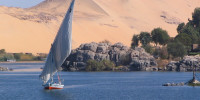
The Difference Between Freshwater and Saltwater Boats
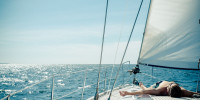
Everything You Need to Sail Around the World (by an expert)
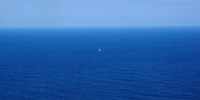
What Is Bluewater Sailing?
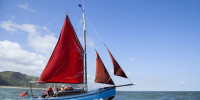
The Cheapest, Smallest Boat to Sail Around the World
Own your first boat within a year on any budget.
A sailboat doesn't have to be expensive if you know what you're doing. If you want to learn how to make your sailing dream reality within a year, leave your email and I'll send you free updates . I don't like spam - I will only send helpful content.
Ready to Own Your First Boat?
Just tell us the best email address to send your tips to:

Do Catamarans Have Keels? Uncovering the Truth
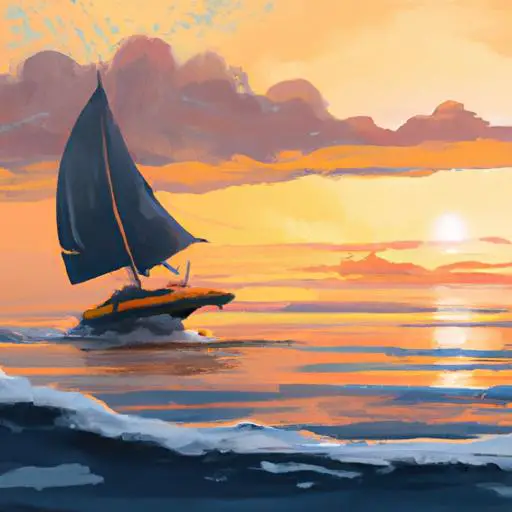
Have you ever wondered what makes a catamaran so different from other types of boats? You may have noticed that a catamaran appears to lack the long, central keel that other boats have.
So, do catamarans have keels? In this article, we’ll go beyond the surface level to uncover the truth about catamarans and keels.
We’ll look at what a catamaran is, what a keel is, and why catamarans don’t have keels.
We’ll explore the advantages and disadvantages of not having a keel, as well as the different types of catamarans and their popular uses.
By the end of this article, you’ll have a better understanding of why catamarans are the way they are.
Table of Contents
Short Answer
Catamarans typically do not have keels.
Instead, they have two hulls, or parallel hulls, connected by a frame.
This design reduces drag and increases stability, allowing catamarans to move quickly and remain upright in rough seas .
Keels are typically seen on monohull boats, which are boats with a single hull.
What is a Catamaran?
A catamaran is a type of boat that is made up of two hulls, or parts, that are connected by crossbeams and struts.
Compared to single-hulled boats, catamarans are more stable and provide greater stability due to the weight being distributed over a larger surface area.
This design also allows catamarans to be more easily maneuvered and to move through shallow waters.
As a result, they are often used for recreational activities such as fishing and sailing.
Catamarans also typically lack a keel, which is a fin-like structure that is found on the bottom of a single-hulled boat that helps provide stability and also helps protect the boat from waves or other environmental forces.
Instead, catamarans rely on their two hulls to provide stability and protection.
What is a Keel?

When it comes to boats, the keel is perhaps one of the most important components.
A keel is a long, heavy, and usually flat piece of metal, wood, or fiberglass that is attached to the hull of a boat and extends below the surface of the water.
This structure serves several important functions, including providing stability, generating lift, and helping to steer the boat.
The keel also serves as a counterweight to the wind and wave forces that push against the hull of the boat.
It also helps to disperse the weight of the boat, allowing it to remain level in the water.
While a keel is present on most traditional boats, it is not present on catamarans.
Why Don’t Catamarans Have Keels?
When it comes to boats, the keel is an integral part of the design.
It provides stability and helps the boat to move through the water.
So why dont catamarans have keels? The simple answer is that they dont need them.
Catamarans are designed with two hulls that are connected by crossbeams and struts.
This design helps to provide greater stability by distributing the weight of the boat over a larger surface area.
The lack of a keel also allows the catamaran to be more easily maneuvered and to move through shallow waters.
This design also allows catamarans to be more fuel efficient than traditional single-hulled boats, as the two hulls help to reduce drag.
Additionally, the lack of a keel reduces the overall weight of the boat, making it easier to transport and launch.
The design of the catamaran also helps to make it more stable in rough seas, making it an ideal choice for recreational activities such as fishing and sailing.
The design of the catamaran also allows it to be more responsive to the waves and wind than traditional single-hulled boats, as the two hulls move independently and respond to the conditions more quickly.
This makes them ideal for sailing and other activities, as they are able to turn faster and more accurately than single-hulled boats.
In short, the lack of a keel on catamarans is one of the main advantages of the design.
The two hulls provide greater stability and maneuverability, and the overall lighter weight of the boat makes it easier to transport and launch.
The lack of a keel also makes the catamaran more fuel efficient and responsive to the waves and wind.
As a result, catamarans are often used in recreational activities such as fishing and sailing.
Advantages of Not Having a Keel

The absence of a keel on catamarans can be advantageous in many ways.
First, it provides greater stability than traditional single-hulled boats.
Because the weight of the boat is distributed over a larger surface area, the catamaran’s two hulls are able to withstand more force from waves and other conditions.
This makes them an ideal choice for recreational activities, such as fishing and sailing, as they are able to remain steady in choppy waters.
Furthermore, the lack of a keel allows catamarans to be more maneuverable than single-hulled boats.
Without the additional weight of a keel, catamarans can turn more quickly and easily, making them ideal for racing and navigating through tight spaces.
Additionally, the absence of a keel allows catamarans to move through shallow waters, which is beneficial for exploring areas that would be inaccessible to single-hulled boats.
Lastly, the absence of a keel also contributes to the overall design of the catamaran, as the two hulls are connected by crossbeams and struts.
This design helps to increase stability and reduce rolling.
Additionally, it can provide greater visibility, as the two hulls can extend farther out from the center of the boat, providing a better view of the surroundings.
Disadvantages of Not Having a Keel
The lack of a keel on catamarans can be both a blessing and a curse.
While having two hulls instead of one provides greater stability, this also means that the catamaran is more vulnerable to strong winds and choppy waters.
Without the keel acting as a counterbalance, the catamaran can be more easily pushed off course.
This is especially true if the boat is not well-balanced, as the weight distribution is less evenly distributed without a keel.
Additionally, a keel can provide additional lift to the boat, which can help to increase speed and maneuverability.
Without a keel, catamarans will often be slower and less responsive than a traditional single-hulled boat.
Finally, the lack of a keel also means that the catamaran is more vulnerable to capsizing, as the boat is more top-heavy without the keel acting as a counterbalance.
Different Types of Catamarans

When it comes to catamarans, there are several types that have different designs and features.
The most common type of catamaran is the pontoon catamaran, which is composed of two hulls that are connected with beams and struts.
This type of catamaran is often used for recreational activities, such as fishing and sailing, because of its stability and ability to maneuver in shallow waters.
Another type of catamaran is the trimaran, which is composed of three hulls connected by beams and struts.
The trimaran is designed to provide more stability than the pontoon catamaran, and is often used for racing and long-distance sailing.
The third type of catamaran is the hydrofoil catamaran, which is composed of two hulls that are connected with beams and struts.
This type of catamaran is designed to reduce drag and increase speed by using hydrofoils to lift the hulls out of the water.
This type of catamaran is often used in high speed boat racing and can reach speeds of up to 40 knots.
Finally, there is the semi-submersible catamaran, which is designed to be partially submerged in water.
This type of catamaran is often used for research and exploration, and can be used to explore shallow waters where traditional boats are not able to go.
No matter the type of catamaran, they all have one thing in common: they do not have a keel. Instead, they are designed with two or more hulls that are connected by crossbeams and struts. This design helps to provide greater stability and allows catamarans to be more easily maneuvered in shallow waters. As a result, catamarans are often used in recreational activities, such as fishing and sailing.
Popular Uses for Catamarans
Catamarans are popularly used in recreational activities such as sailing, fishing, and even racing.
Their unique design allows them to maneuver easily in shallow waters, which makes them ideal for these activities.
Additionally, catamarans are often used for chartering and cruising, as they are more stable than traditional single-hulled boats.
The lack of a keel also allows catamarans to move more quickly through the water.
Furthermore, the spacious living area provided by the two hulls makes catamarans an ideal choice for extended trips and vacations.
Catamarans are also used in commercial activities such as ferrying, transport, and research.
Their stability makes them perfect for transporting cargo and passengers over long distances.
Additionally, the two hulls provide more room for researchers to conduct experiments and surveys.
The shallow draft of catamarans also allows them to navigate shallow waters, which makes them ideal for research purposes.
Lastly, catamarans are also used in rescue and emergency operations, as their stability makes them perfect for difficult and dangerous conditions.
Final Thoughts
In conclusion, catamarans are unique boats that are designed without a keel for added stability and maneuverability.
While they do not have the same advantages as a single-hulled boat with a keel, they are popularly used for recreational activities such as fishing and sailing.
With the knowledge of why catamarans do not have keels, you can now confidently choose the right boat for your next adventure.
James Frami
At the age of 15, he and four other friends from his neighborhood constructed their first boat. He has been sailing for almost 30 years and has a wealth of knowledge that he wants to share with others.
Recent Posts
Does Your Boat License Expire? Here's What You Need to Know
Are you a boat owner looking to stay up-to-date on your license requirements? If so, youve come to the right place! In this article, well cover everything you need to know about boat license...
How to Put Skins on Your Boat in Sea of Thieves? (Complete Guide)
There is a unique sense of pride and accomplishment when you show off a boat you customized to your exact specifications. With Sea of Thieves, you can customize your boat to make it look like your...
- OC Wally Cento
- 84 Mini Maxi
- IMOCA Open 60
- Consultancy Services
- 30m Blue Water Cruiser
- 25m Explorer Yacht
- 24m Fast Cruising Catamaran
- 23m Performance Cruiser
- 20m Explorer Yacht
- 20m High Performance Cruiser
- 18m Blue Water Cruiser
- 15m Performance Cruiser
- 15m Explorer Yacht
- 12m Explorer Yacht
- Multihull Design
- 18m Explorer Yacht
- 40m Blue Water Cruiser
- 40m Cruiser Racer
- 33m Performance Cruiser
- 30m Wally Cento
- 24m ORCsy Racer Cruiser
- 24m Day Sailer
- Carbon Component Design
- Yacht Performance Development
- CFD and Model Testing
- Twin Rudder Steering Systems
- Custom Deck Hardware
- Modifications and Refit
- VPP Routing and Sail Analysis
- Classic Yacht Refit & Optimisation
- Naval Architecture
- Engineering
- Rudder Design
- Brokerage Services
- 'Seahorse Magazine' #192
- Lucent #180
- Influence #171
- 'Eora' #169
- 'The Three Brothers' #168
- 'Edenred' #165
- Polka Dot #154
- 'Teata' #148
- ‘Sensei’ #131
- 'Sabre II' #93
- French Pineapple #79
- 'Letto Di Pletto' #47
- 'Mowgli' #41
- 23.8m Ultime Trimaran
- 20.7m Orma Trimaran
- 18.28m Orma Trimaran
- 16.75m Cruising Catamaran
- 16.1m Cruising Catamaran
- 12.8m Crowther Shockwave Catamaran
- 9.1m Seacart 30 Trimaran
- 26.3m Aluminium Sloop
- 22.38m Aluminium Classic Yacht
- 21.0m Steel Schooner
- 21.0m Aluminium Cruising Ketch
- 20.0m Aluminium Explorer Yacht
- 20.0m Luca Brenta Racer Cruiser
- 19.6m Aluminium Bluewater Cruiser
- 19.2m Aluminium Lifting Keel Sloop
- 18.23m Mylius Racer Cruiser
- 16.0m Sly Cruiser Racer
- 14.5m Aluminium Cruising yacht
- 13.87m Wooden Motor Sailer
- 11.6m Classic Pilot Cutter
- 25.25m Reichel Pugh Maxi
- 18.28m IMOCA 60 One Planet
- 18.28m O Canada IMOCA Open 60
- 18.28m Come in Vendee Open 60
- 18.23m Mylius FD Racer Cruiser
- 15.84m TP52 Racing Yacht
- 15.25m Pegasus Open 50
- 10.89m Figaro 3
- 10.1m Figaro 2
- 14.5m Aluminium Cruising Yacht
- Hispanoamérica
- Work at ArchDaily
- Terms of Use
- Privacy Policy
- Cookie Policy
Moscow Has a New Standard for Street Design
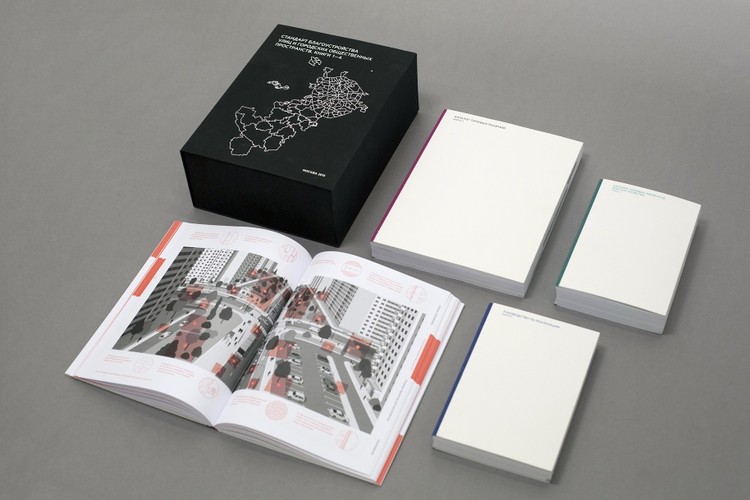
- Written by Strelka Magazine
- Published on August 25, 2016
Earlier this year the development of a new Street Design Standard for Moscow was completed under a large-scale urban renovation program entitled My Street , and represents the city's first document featuring a complex approach to ecology, retail, green space, transportation, and wider urban planning. The creators of the manual set themselves the goal of making the city safer and cleaner and, ultimately, improving the quality of life. In this exclusive interview, Strelka Magazine speaks to the Street Design Standard 's project manager and Strelka KB architect Yekaterina Maleeva about the infamous green fences of Moscow, how Leningradskoe Highway is being made suitable for people once again, and what the document itself means for the future of the Russian capital.

Strelka Magazine: What is the Street Design Standard and what does it include?
Yekaterina Maleeva: The Street Design Standard is a manual for street planning in Moscow . The Standard is divided into four books, each one of them covering particular aspects of street design. Many cities across the globe have developed their own standards and the concept has gained a lot of popularity over the last decade. The New York Street Design Manual is a famous example; the book has even been translated into Russian. However, Moscow streets have little in common with New York streets, for example; every city has its own unique urban typology and simply copying existing solutions from another manual is not a viable option.
When we started our work on the Standard , the first thing we did was study Moscow streets, their peculiarities and common features. The first volume of the Standard focuses on the typology and distinctive attributes of the streets of Moscow. We gathered data on more than 3,000 streets and processed the data. Despite the large sample size, we discovered certain similarities. We managed to identify ten of the most common street types, but some unique streets could not be categorized. For instance, Tverskaya Street, built in 19th century, originally fell under category "10C." But after it was widened in the 1930s, Tverskaya ended up in a unique place within the urban fabric of Moscow. Such objects as that require a case by case approach and an individual project.
What can be found in the other volumes?
After we identified these ten street types, we started working on defining the best way to approach the development of each. The second book describes what a street of each type must have. We developed a general profile and functional zoning for each type. The pavement is more than just a pedestrian lane: there is a buffer zone between the roadway and the walking lane where the parking posts, street lights and communication lines are located. It’s a mandatory utility zone that has to be paved in such a way that any section can be easily unpaved and replaced. There is also a pedestrian fast lane for people walking to their workplace and a promenade with benches and other objects. Building façades have a large impact on the street they are facing. Restaurants and shops are located in these buildings. Making the adjacent zone retail-friendly is important. Cafes and restaurants must be able to open street patios to attract customers without disrupting the pedestrian traffic. How to apply these concepts to each of the street types is thoroughly explained in the Standard .
The third book describes eleven groups of design elements, including surface materials, benches, trash bins and lights. This catalogue of elements contains no mention of suppliers. It does not promote any manufacturers; instead it describes the attributes which define a quality product. For instance, the third book explains which type of tree grates will serve the longest while causing no damage to the root system of a tree. Styles of grates, bins, benches and other elements may vary, but all the items must comply with the quality standard.
Finally, the fourth book focuses on the planning process: how to perform preliminary analysis, how to apply user opinions during the development and how to achieve quality implementation. Additionally, there is a special emphasis on the fact that street planning cannot be carried out without any regard for the context of the street. A street should be regarded as a part of an interconnected system of various public spaces, together with adjacent parks, garden squares, yards and plazas.
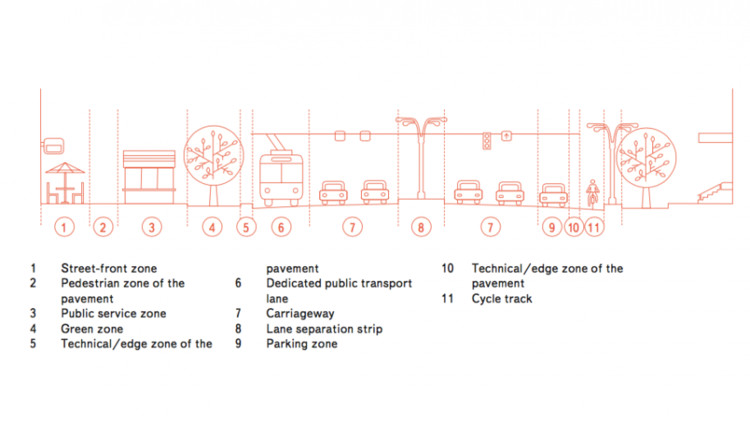
Does the Standard have an official status? Should it be considered a law or merely a guideline?
There are a number of state-level laws and regulations relevant to street design issued by the Moscow Government. They were taken into account during the development of the manual. These regulations ensure safety standards and must be complied with. While the existing legislation covers safety aspects, our books introduce comfort standards. The Standard is basically a non-binding, advisory guideline created with the goal of improving the urban environment everywhere across the capital and maintaining it at a high level.
What happens if a street does not fit any of the mentioned types (and is not as significant as Tverskaya)? For instance, what if a street located in the New Moscow territory has cottages on one side, apartment complexes on the other and an entrance to the Moscow Ring Road somewhere along the way?
A standard is not a ready-made solution. The streets share common features yet also retain their individual attributes at the same time. Applying a single standard profile to every street is impossible. Adjustments are always in order.
The Standard offers three sets of solutions for each type of street with a large potential for combining various elements. The manual basically offers a convenient database that a designer working with a new space could use. That does not mean that all the new projects will look exactly the same. Some solutions featured in the Standard are yet to be implemented anywhere in Moscow . For instance, our collaboration with Transsolar, a German company consulting us on environmental comfort, revealed that Moscow’s largest environmental problem was not in fact CO2, but small-particle dust produced by studded tyre traction. And a simple method to control this type of pollution already exists. Many busy streets outside the city center have a green buffer zone separating the roadway from the sidewalks. A 1.5m high ground elevation running along this zone could filter out up to 70% of the tyre dust, preventing it from spreading into the residential areas. Western countries have been successfully using this technology for many years. Now it is a part of Moscow Standard . By the way, a terrain elevation could also help reduce the level of road noise.
.jpg?1471881026)
Does the Standard offer anything for the main roads? For example, nowadays Leningradskoye Highway basically splits the city into two disconnected parts; it’s a car dominion.
The Standard does not offer solutions for transportation problems. When we were defining our street typology, we relied on traffic load data calculated using Moscow ’s transportation model. We pursued a goal of only offering solutions that would not aggravate the current transport situation. Any planned sidewalk extension or addition of a bicycle lane or road crossing should first be approved by the Moscow Department of Transport.
As for the main roads, our research revealed that the streets with the highest traffic load also have the heaviest pedestrian traffic. One would think that it should be the other way around. However, the main roads have metro stations, which generate a lot of pedestrian traffic, which in turn draws retail. Treating main roads the same way as highways is impossible. The needs of both vehicle traffic and local residents must be taken into account, which creates a paradox.
These territories have every opportunity to become more comfortable. Some have relatively large green buffer zones that currently remain underused. The Standard proposes to augment these zones with additional functionality. On one hand, some of the main streets will gain attraction centers, especially near intersections connecting them to the adjacent residential areas. Weekend markets are one example of such centers. On the other hand, the Standard involves the creation of zones able to absorb extra precipitation flowing from the roads and filter it. There is a list with types of vegetation best fit to handle this task. The same zones could be used to store snow in the winter. The meltwater will be naturally absorbed by the soil, alleviating the need for moving the snow out to melt. This, however, would require decreasing the quantity of melting chemicals sprayed over the snow, as the plants underneath might be susceptible to their effects.

Can the new Standard rid us of green lawn fences, yellow curbs and other eternal eyesores?
The choice of yellow and green appears random, so we have no idea how to actually fight that. The Standard offers no colour schemes. As long as fences meet the set requirements, their colour does not matter. However, currently they seem to fail to comply. The Standard states that lawns do not require fencing. This is a waste of materials: people will not trample grass and bushes just for the sake of it, while dog owners will trespass anyway. There are many other options for protecting lawns from being trampled. For instance, a same-level pavement strip with a different texture could protect a lawn from accidental intruders just as well as a curb can.
Natural soil water absorption is currently largely ignored, with most precipitation going down the storm drains. Meanwhile patches of open terrain on a street are able to absorb water. Employing these natural cycles in street layout could save resources.
Does the Standard provide any financial estimations? For instance, an approximate cost of renovating a street of a particular type?
No, as the Standard does not list any products of any particular brand, there are no prices to refer to. Nonetheless, the Standard was developed to fit three potential price ranges. Whether their estimated price is low or high, all the elements ensure that quality requirements are met. The same quality level must be maintained across the whole city and never drop below the set standard.

Let’s say a world-famous architect arrives to Moscow to design a street. He puts incredibly beautiful things into his project, which, unfortunately, contradict the Standard and are not guaranteed to work as intended. In that scenario, will the architect be told to stick to the Standard ?
This could happen and I think it would be a good thing. If an architect plans to place a sculpture on a 1.5 meter wide sidewalk, would that really be a good idea? Following the Standard ensures smooth movement. Its goal is to reinvigorate the streets. In Copenhagen, new design manuals helped increase average time spent by residents outside by 20% over 10 years. That was achieved through creating convenient and attractive public spaces. Moreover, implementation of the Standard enables the creation of professional documentation for architects, which excludes the possibility of any instructions that will later be unclear to the experts trying to work with them. Finally, the Standard also pursues the task of providing the opportunity for the development of street retail.
Isn’t retail a whole different story? How can retail be introduced in such places as Strogino District, where the ground floors are living floors and have security bars on windows? By reintroducing street vendors?
True, business has no direct relation to street renovation. However, there is a strong connection between them. In Strogino, building façades are mostly located far from the sidewalk. Moreover, facades are often concealed by shrubbery and trees, making local businesses even less noticeable. Another problem is that first floor apartments cannot be used for commercial purposes due to insufficient ceiling height (3 m compared to 3.5 m required minimum). Nonetheless, we discovered multiple examples of shop owners reconstructing apartments in residential districts to meet the requirements.
Our British consultant Phil Wren, a street retail expert, travelled Moscow ’s residential districts and studied the existing examples. He came up with a great idea: building an expansion connected to the façade and facing the sidewalk. This makes it possible both to achieve the required ceiling height and increase the visibility of the business to the passers-by. The part of the shop located in the apartment can be used as a utility room or a stockroom. This way the noise level is reduced, regulations are met and store space is increased. Our Russian consultants confirmed the viability of the proposed concept. And the Standard will ensure that any added expansions will look presentable.

Does the Standard also regulate façade appearances, an architectural element? What should be expected from this? It is unlikely that all houses which fail to comply will be demolished once the Standard is implemented.
Renovation works with what is given. Of course, façades cannot be changed. Central Moscow has a problem with mansions and many other buildings being fenced off, which prevents them from accommodating street retail. Central streets are also relatively narrow. The Standard proposes sidewalk expansion wherever the access to the first floors is open. Street renovation does not always involve planting trees. Some places require enhanced crossings so that people can quickly reach the other side of the street to get to a shop or a café. Those streets where the facades are windowless are a more suitable place to plant more vegetation.
Can an average person – not an architect, designer or construction worker – understand the new Standard , or is it a technical document which can only be interpreted by a professional?
Any person can. The Standard is written in a way that both professionals and common citizens are able to understand. The Standard contains multiple images, photos, infographics and diagrams and is written in plain language. We would love for more people to read it: the books contain many interesting solutions for our city that affect every pedestrian.
In late March it was revealed that Strelka KB would be developing a standard for recreational zones and public areas in Moscow . What differences will that document have from the Street Design Standard ?
The two standards will have a lot in common. The city currently faces a task of developing a connected system of public spaces. The first logical step was to work with the streets which actually connect areas of attraction and other public spaces. Now the work on all other public spaces takes off. Parks, garden squares, yards, water bank recreation areas, plazas near metro stations must all fall into place. Work with these territories will set a single quality standard. In addition, it will improve Moscow ’s quality of life and reduce air pollution. Simple solutions could improve airflow, increase biodiversity and reduce noise levels at the same time.
The renovation program is quite long and depends on numerous standards and documents. But when exactly will the endless repair works end? Are there any time estimations for when all these concepts will finally get implemented?
This is not an easy question. Full renovation may last decades. The Standard is the first step towards actually controlling the renovation process and its timeline. Until now renovation has been proceeding rather haphazardly. Now the city has decided that the way the streets are designed should be clarified. We understand that the Standard cannot last unchanged for eternity and should, just like any regulation, undergo periodical updates. The Standard uses flexible typology: a street of one type could transition to another within a few years under certain conditions, such as changes in its usage and its user categories. Everything must stay regularly updated according to the accumulated experience.
During our work on the Standard , we held regular roundtables joined by experts and ordinary citizens. One of our guests mentioned that he had recently started paying attention to Moscow ’s facades, their beauty and their drawbacks. He was able to do that because he no longer had to watch his step. So the process has already started and we already see some results.

- Sustainability
世界上最受欢迎的建筑网站现已推出你的母语版本!
想浏览archdaily中国吗, you've started following your first account, did you know.
You'll now receive updates based on what you follow! Personalize your stream and start following your favorite authors, offices and users.
- Architecture News – World Buildings
- Buildings by Country
- Buildings by City
- Architects by country
- Architects by city
- Architects alphabetical
- Competitions
- Building Events
- Architecture Design
Moscow City Agglomeration Competition
Moscow City Agglomeration Development Concept Competition, Architecture Contest, Building, Design
Moscow City Agglomeration Development Concept Competition
Russian Design Contest – design by various architects
17 Oct 2012
Moscow City Agglomeration Competition Results
Moscow City Agglomeration Development Contest
PLANS FOR A NEW MOSCOW PRESENTED
At the end of August nine international teams presented their final projects for the draft concept for the development of the Moscow agglomeration to a group of experts and the client, the Moscow Committee for Architecture. At the beginning of September, they were judged by an international jury, headed by Deputy Mayor Marat Khusnullin. They judged proposals for the Moscow agglomeration as a whole, for the new extension of the city and for a new federal government centre to be located in the new extension. In the last category the project of the Urban Design Associates team was the winner, in the two other categories the team of Antoine Grumbach.
The competition for the design of a draft concept for the development of the Moscow agglomeration was announced after president Medvedev agreed with the governor of the Moscow region to transfer a part of the region’s territory south west of the city to the municipality.
The aim of enhancing Moscow’s territory 2,5 times was to relief the pressure on the city that is dealing with enormous traffic problems. At the same time, it was announced that the federal government would move its offices from the centre of Moscow to the new territory. The competition that was commissioned by the Moscow Committee for Architecture and organized by the Moscow Masterplan Institute, was based on the model of the Grand Pari(s) competition that was initiated by French president Sarkozy in 2008. Nine teams were selected on the basis of their portfolio’s.
For the first time in history, planners from all over the world were looking at the development of Moscow not just as a city, but as a metropolitan agglomeration. This is very important, since Moscow’s traffic problems are mainly caused by the daily migration to the central city by people from the agglomeration. The creation of new centers of working and living could be a way to solve this problem. The big question is where to create these centers: in the agglomeration or inside Moscow? Though most of the competitors stress that it is as important to densify the city within its borders, as it is to create new centers outside, the extension of the city is something to be dealt with – it is a development that has been taking place ad hoc for the last 20 years.
Moscow City Agglomeration Development Contest Projects
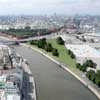
The Ostozhenka team seems to take the most radical position of all competitors by proposing to freeze urban development in the new territories, using them exclusively for the creation of recreation areas, agricultural land and forestry. All new construction should be concentrated in former industrial sites within the existing borders of the city.
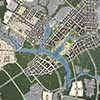
Actually all teams propose to desify the existing city. In general, many teams have produced converging projects where technical aspects or just common sense appear to prevail over conceptual and artistic considerations. In this perspective, three projects can be considered more of less generic – the projects of the Urban Design Associates, TSNIIP and Chernikhov teams don’t really make clear choices but develop their project by juxtaposing obvious development potentials.
On top of this Urban Design Associates team proposes a detailed project for the government centre with an artificial lake as the binding element between the different quarters. With attractive imagery this project was especially liked by the jury, which it to considered this project the best for the federal government center.
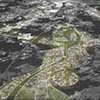
The Bofill and Grumbach teams choose to concentrate new construction in a long linear development reaching out of the city, motivating this by the idea that this is represents the natural growth pattern of the city. Bofill’s project consists of a wave-like development that mixes urban settlements with a park landscape. The Grumbach project uses the RER model that we know from Paris, and includes an compehensive public transport plan and detailed projects for the development of the areas around the stations. These appealing proposals made the jury declare it the winning project for both the Agglomeration and the New extension categories.

Almost all projects propose a rail connection between the Vnukovo and Domodedovo airports parallel to the Moscow Ring Road, but only the l’AUC team develops this as the central axis of the new development: a parallel city that connects both existing and new settlements in the extension and links up with the existing express rail connections that currently serve the airports. More detailed projects are presented for 10 sites evenly distributed within the existing city and in the South-West extension. They include a Luxury River Area, A Slow City Area, a University Research and Development Area and the Federal Government center.

The OMA team also works with development clusters, but they are not just located in the city and the Southwest. The displacement of the government agencies and ministries as a trigger for the establishment of urban settlements outside the city is taken to its extreme: they are not concentrated in one new federal government centre but distributed around the city near existing developments that are related to the specific character of a ministry or agency: The ministry of border control near an airport, the ministry of transport near a railroad test site, the ministry of energy near a centre for nuclear science etc. On the whole the OMA project concentrates on the invention of new instruments like taxation, land use regulation and land swap rather then the creation of new urban configurations.

In contrast with the OMA plan the project by the Secchi teams is the most architecturally articulated. Not transport lines define the urban development but urban form. It proposes to shift the centre of gravity of the city towards the south west. For this it creates a large square that reaches over the Moscow ring Road and unites city and countryside. It attempts to erase the Moscow Ring Road, that in all other projects features as a rigid border of the city.
Though the jury has chosen some project as being the best, there is little chance that one or another project will be realized. However, all teams have produced large reports that will be thoroughly studied by the city and the Masterplan Institute. This will give the city a large catalogue of possible solutions and development strategies that it can use to solve the problems of the Moscow agglomeration.
28 Jun 2012
Moscow City Agglomeration Development Competition News
International Consortium including British firm McAdam Architects takes first place in second round of Moscow City Agglomeration competition
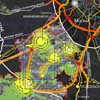
Presentations took place in Moscow on 22 June 2012 for the second stage of the competition, in which 9 teams presented the first editions of concepts for the city agglomeration development, including the existing city and the new south western sector of the agglomeration.
The international consortium, lead by well-known Russian urbanist – Andrey Chernikhov, and including McAdam Architects, Tower 151, Georgi Stanishev and Ginsburg Architects were awarded the highest score by a panel of international experts with OMA taking second place.

The consortium suggested that, instead of looking at new development in the south western sector, in the first instance an abundance of brown field and other available sites within the existing city boundaries should be attended to. They highlighted vast areas occupied by goods railways and disused industrial sites from Soviet times, as prime areas for regeneration and expansion, as well as a re-thinking of transport networks to alleviate pressure on existing systems.
Their radical proposals have sparked a debate as to the validity of the brief which emphasises the need to expand development into the south western sector.

James McAdam who attended the presentations said: the process is evolving into a fascinating discourse on how a major capital can tackle the problems of expansion and regeneration on a vast scale. As a consultation procedure the range of ideas being suggested are incredibly diverse and could be pooled as a powerful medium for Moscow’s future.
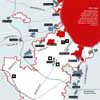
Final concept presentations are scheduled to take place at the end of August.
Moscow City Agglomeration Development Concept Competition images / information received 280612
McAdam Architects
27 Apr 2012
Moscow City Agglomeration Development Concept Competition 2012
OMA wins first round of the Moscow City Agglomeration Development Concept Competition
Moscow, 27 April, 2012 | A consortium of experts led by OMA scored the highest of the 10 teams that completed the first stage of the competition to develop the concept of the Moscow Agglomeration.

In 2011, the Russian Federation Council confirmed that the city of Moscow will annex 150,000 hectares to the southwest, making Moscow 2.4 times its current size. The expansion is designed to relieve pressure on the historic city center by redistributing the working places to the annexed part of the Moscow Oblast, thereby addressing transport, ecological and social issues that result from high levels of commuting. Before Moscow’s new administrative borders come into force in July this year, the Council called for a concept for the development of the Moscow Agglomeration, and in February this year the Council invited 10 teams to participate in the development of this concept.
For the first round of the competition, focused on a plan for the Moscow Agglomeration as a whole, OMA proposed a joint framework for the development of Moscow and the Moscow Oblast, under which the administrative border and political mandate could address the entirety of the Agglomeration. OMA proposed logistical hubs outside Moscow’s current boundaries which would be linked to the City and the Oblast through high-speed rail, integrating all forms of infrastructure: transport, broadband, industry, and energy provisions. The proposal also suggested that the development would not rely solely on government funding, but could introduce a public/private mix.
On the proposed development strategy, OMA Partner-in-charge Reinier de Graaf says, “We are very honored to participate in such an ambitious project. In launching this plan, the authorities have taken an important step in addressing the problems of the city at the appropriate scale: Moscow’s proposed expansion becomes a reason to develop a single integrated future for Moscow and the Oblast.”
The OMA team working with AMO, its internal research studio, is led by Reinier de Graaf and Associate Laura Baird. The concept is being developed together with a core team consisting of the Strelka Institute for Media, Architecture and Design, Project Meganom and Siemens. This core team will be supported by an advisory board which includes McKinsey, Ricky Burdett, Saskia Sassen, member of the Committee for Global Thought (Columbia University), the Levada Center, West 8, and RWDI.
Moscow City Agglomeration Development Concept Competition images / information from OMA
Rem Koolhaas
Location: Moscow , Russia
Moscow Architecture Developments
Contemporary Moscow Buildings
Moscow Building Developments – chronological list
Russian Architecture Tours by e-architect
Moscow Architects Offices
Another Moscow architecture design by OMA on e-architect:
Garage Center for Contemporary Culture – new building in Gorky Park, Moscow , Russia Garage Gorky Park
Moscow Architecture
Moscow New Town Masterplan Selection
Bolshoi Moscow Competition Design: various architects Moscow City Agglomeration Competition
A101 : Largest European New Town Restarts A101 New Town Project
“Aeroflot – Russian Airlines” Architect: Vladimir Plotkin Aeroflot Offices Moscow
Moscow School of Management, SKOLKOVO Adjaye Associates Moscow School of Management
Russia Tower Foster + Partners Russia Tower : ‘tallest tower in Europe’ proposal
Russian Architecture
Pushkinsky Cinema Competition
Russian Architecture Competition
Perm Museum Competition
A101 Urban Block Competition Moscow
Building Competitions : Archive
Office for Metropolitan Architecture
Comments / photos for the Moscow City Agglomeration Development Concept Competition page welcome
AVSIM Library System Version 2.00 -- 2004-May-01 © 2001-2024 AVSIM Online All Rights Reserved

IMAGES
VIDEO
COMMENTS
The most important catamaran design hull shape factor, is the Prismatic Coefficient (Cp). This is a measure of the fullness of the ends of the hull. ... Finally you can flatten out the hull rocker (the keel shape seen from the side) and add a bustle aft. That is the approach I use, in part because that adds displacement aft, just where it is ...
The Rustler 57 has the option of being fitted with a lifting keel. Its 2.0 (6ft 8in draft makes her a more versatile cruising yacht. In the centre of the keel is a bronze fin that has a chord as wide as the depth of the lead stub. When the blade is retracted, the yacht only draws 2.0m / 6ft 8in and she still sails well.
The boat with a fixed keel is likely to point nearly as high as one with dagger boards, but will lose ground though increased leeway. As the wind strength increases the fixed keels will typically operate much more efficiently and from personal experience the difference in performance between two similar cats -one with efficient fixed keels, the ...
This fin keel offers the least draught of any of our fixed keel options at 1.15m/3ft 9in and draws 10cm/4in less than the twin keel version. The keel has a significantly longer chord (2.24m/7ft 4in compared to .7m/2ft 3in of the standard keel) so she has the reassuring directional stability of a long-keeled yacht but with better manoeuvrability.
Good directional stability depends on the hull balance. A properly designed daggerboarded boat will sail as straight as a LAR keel one, and have the additional benefit of being quicker to tack and maneuver when necessary. Finally, if you run aground, you can lift the boards to get off, but remain stuck with keels.
You could essentially say that a catamaran with keels is a bit like a long-keel monohull, and the daggerboard catamaran is a fin keel monohull in more terms. I think we all know and all agree that the best sailing boats are going to be the one with fin keels. ... Everything in design, it's always interconnected. Going back to the comfort, and ...
A cruising catamaran's performance depends on three main aspects; its length, the sail area, and the boat's weight. Long boats are generally fast. A light boat with more sail area is also faster than a heavier boat with less sail area. In other words, you can make a multihull faster by making it longer, lighter, or adding more sail.
Design parameters for these charter cats are often centered around 2 week multiple family vacations in the steady Trade Winds and day sails between closely spaced islands of the Caribbean. The features of these keel catamarans obviously put less demand on pure sailing performance or extreme upwind sailing characteristics, but rather try to ...
The length of the stub keel will depend on various factors, such as the size and design of the catamaran, intended use, and specific requirements of the boat builder. Generally, the stub keel on a catamaran is designed to provide stability and improve sailing performance, so it is important to consult with a naval architect or boat designer to ...
Yes, you do need a keel. Pretty much all sailboats have a keel, with exceptions for multi-hulled and/or smaller boats. In the case of catamarans, the very design principles that lead to the dual-hull design render the keel obsolete. The stability introduced by the outrigged, dual-hulls replaces the necessary righting moment from the keel.
In my forty-five year career in the catamaran industry there's been a relentless debate on the virtues and vices of daggerboards versus fixed keels. ... Their analysis returned the predicted boat speed and leeway angle for the Balance 526 with a keel design and daggerboard design for all combinations of true wind speed from 4 to 25 knots and ...
Where older long keel designs had the keel included in the hull mold, today's bolt-on fin keel designs allow the manufacturers more leeway in customizing a yacht to your specifications. What you're left with is a hull, and boat hulls take three basic forms. ... Catamarans have two hulls connected by a large bridge deck. The best part for ...
4. THE KEEL The keel is the most important hydrodynamic feature of any sailboat. Keels are responsible for a boat's stability and to prevent it from sliding across the water on certain points of sailing (closehauled and reach position). Once a keel is chosen, the rudder is relatively easy to design.
TELESCOPIC KEEL. The telescopic keel combines some of the benefits of the fixed keel and lifting keel. It achieves a similar amount of draft adjustment as the lifting keel with only minor intrusion into the interior. The upper, fixed part of this design is installed partly inside the hull but mostly outside and below the hull surface.
These structures play a pivotal role in providing stability and buoyancy while at sea. Catamarans boast wider hulls compared to traditional monohull sailboats, resulting in increased surface area and enhanced stability. The design allows for smoother sailing even in rough waters, as each hull slices through waves independently. 2. Keels:
Each keel is approximately 10 ft in length and extend about 24 inches... Log in or Sign up. Boat Design Net. Home Boat Design Forums > Design > Boat Design > cruising catamaran keel design. Discussion in 'Boat Design' started by emcmia, Feb 27, 2004. Joined: Feb 2004 Posts: 3 Likes: 0, Points: 0, Legacy Rep: 10 Location: Miami emcmia New Member.
The fin keel is a narrow fin below the boat, usually in the center. It comes with various endings, sometimes with a weight at the tip, adding to the stability, sometimes there are two keels, which helps with performance. The wing keel is a special type of fin keel design. The lifting keel is a fin keel that can be raised.
Catamarans typically do not have keels. Instead, they have two hulls, or parallel hulls, connected by a frame. This design reduces drag and increases stability, allowing catamarans to move quickly and remain upright in rough seas. Keels are typically seen on monohull boats, which are boats with a single hull.
Qilak is a custom sailing yacht design, an Owen Clarke designed blue water lifting keel expedition yacht, a cruising explorer of the Arctic, Antarctic and the North West Passage. She is built from aluminium and was launched in September 2018 at KM Yacht Builders, Holland.
Published on August 25, 2016. Share. Earlier this year the development of a new Street Design Standard for Moscow was completed under a large-scale urban renovation program entitled My Street, and ...
Greetings! I have been experimenting, trying to obtain the best mix of accuracy and completeness for the Moscow Russia city scenery. To accomplish this, I have downloaded, (and purchased as necessary), both Drzewiecki Design's Moscow XP POI scenery pack as well as simHeaven's excellent X-Europe for XP-11.
The competition for the design of a draft concept for the development of the Moscow agglomeration was announced after president Medvedev agreed with the governor of the Moscow region to transfer a part of the region's territory south west of the city to the municipality. The aim of enhancing Moscow's territory 2,5 times was to relief the ...
AVSIM Library - Search Results. in AVSIM File Library and below. Moscow City X DEMO is a very detailed model of Moscow metropolitan area in Russia, together with lite sceneries of 7 airports (UUWW Vnukovo, UUDD Domodedovo, UUBW Zhukovski, UUMO Ostafyevo, UUBM Myachkovo and UUMB Kubinka), many heliports and thousands of buildings. This product ...